Rickubis
Bird Page #6b2: Great Blue Herons!--page 2
This page was born 1/26/2023 (split from
Great Blue Herons page). Rickubis designed it. (such as it
is.) Last update: 5/30/2024
Images and contents on this page copyright ©2002-2024 Richard M. Dashnau
I've linked so many
images on the original page, it takes too long to load. So, I've split it
into multiple pages. The newest material will be on the larger numbered
pages.
Click here for
Great Blue Herons Page 1.
Go back to my home page, Welcome
to rickubis.com
Go back to
the RICKUBISCAM
page.
----------------------------------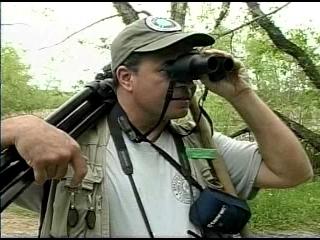
Welcome
to Brazos Bend State Park. That's me on the trail, some years ago. With
so many animals in Brazos Bend State Park there are many interactions
between predator and prey.
With luck, we get to witness some of them. In my experience, most
visitors to BBSP think of Alligators when they think of predators
there. But we have so many others, and I would
suggest we have more than one "apex" predator in the park--and I really
enjoy pointing that out to visitors.
Besides Alligators, we have Otters, Bobcats, and Coyotes. Rat
snakes might count in that list. In the air, we have Bald
Eagles, Northern Harriers, Red-Shouldered Hawks,
Red Tailed Hawks, Great Horned Owls, Barred Owls (to name just a few).
And, I would add Great Blue Herons to the list. In their
environment (which can be anywhere, because they can fly and then walk
on all terrain with those amazing legs), they
can kill and eat almost anything, and swallow prey of surprising size.
The GB Herons fascinate me because they are so large, yet move
with such leisurely grace and control;
only to stop, stalk, and then-with a movement that seems effortless-stab
prey. If the prey is large, it is rendered helpless within a few
seconds; although it can take a few
minutes more to make the prey totally inert. They are apex
predators in their environment, and will eat almost anything.
05/04/2024 At BBSP (which was
celebrating its 40-year anniversary). I heard a Heron squawking just
West of the Spillway Bridge, in Pilant Lake. I found a
Great Blue Heron (Ardea Herodias), and saw that it was being harassed by
a Red-Winged Blackbird (Agelaius phoeniceus)! I filmed video,
because--well, drama was
happening. The Blackbird left, then came back, perched on various
plants, and flew at the the Heron. The Heron ducked, while the Blackbird
sometimes came very close.
Edited video of the event is here.
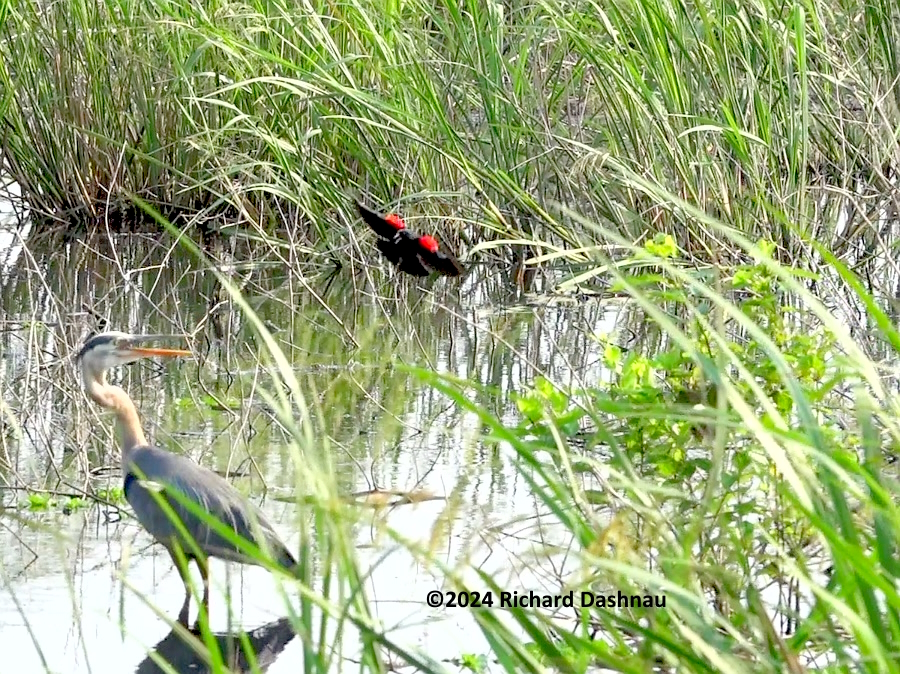
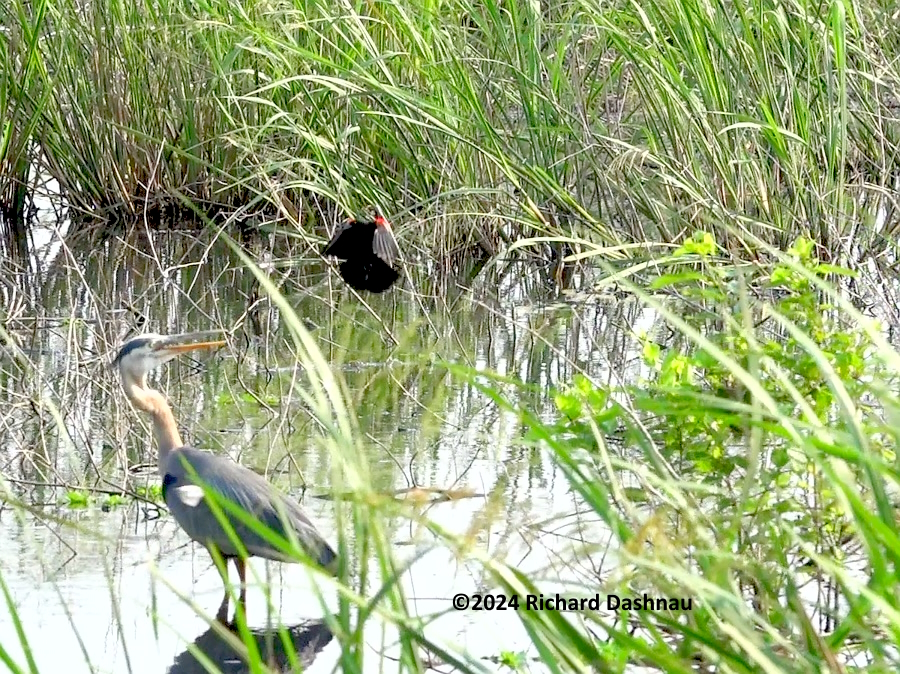
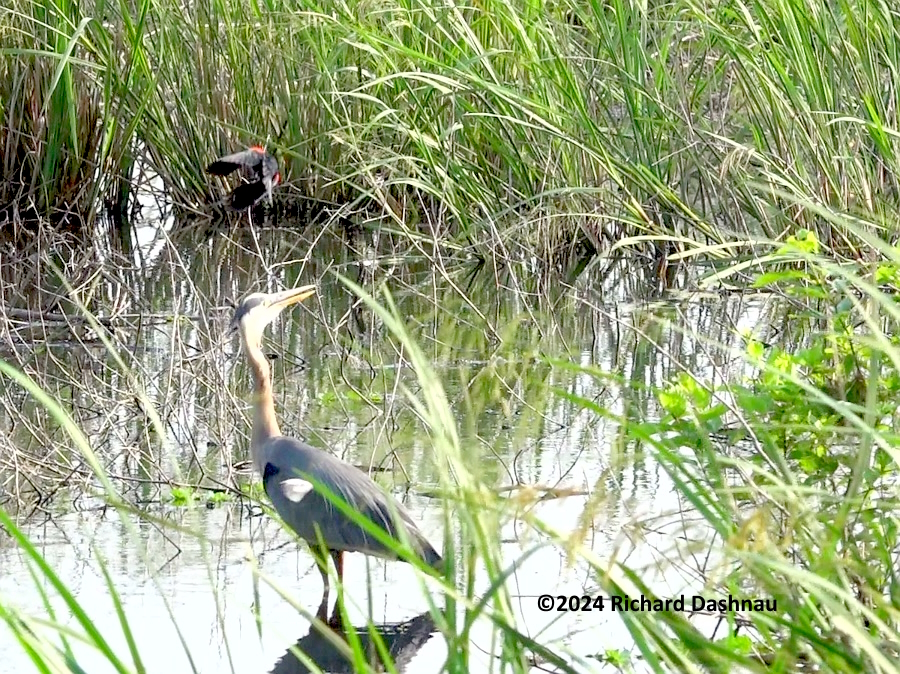
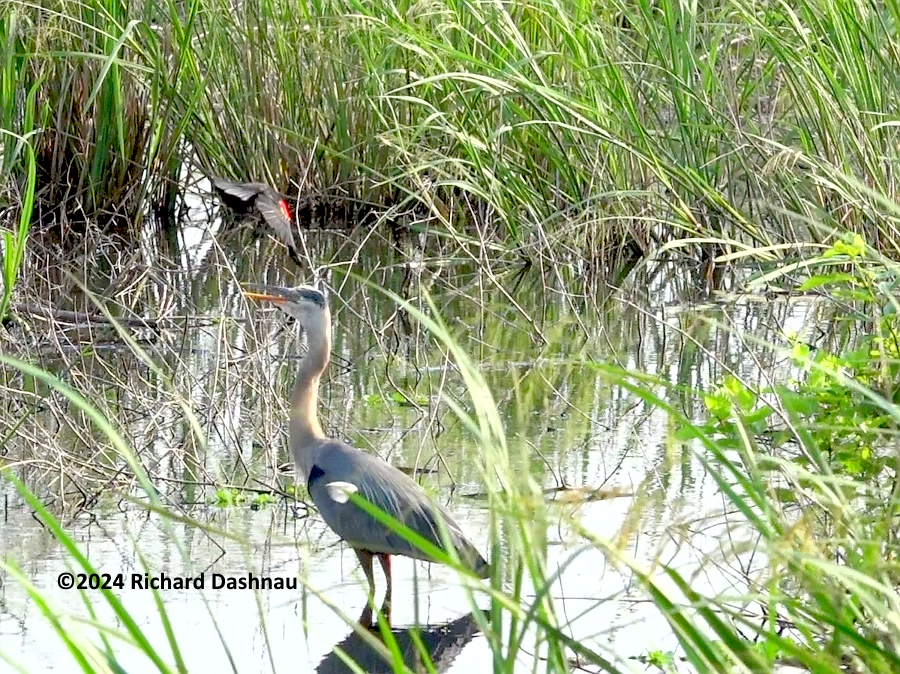
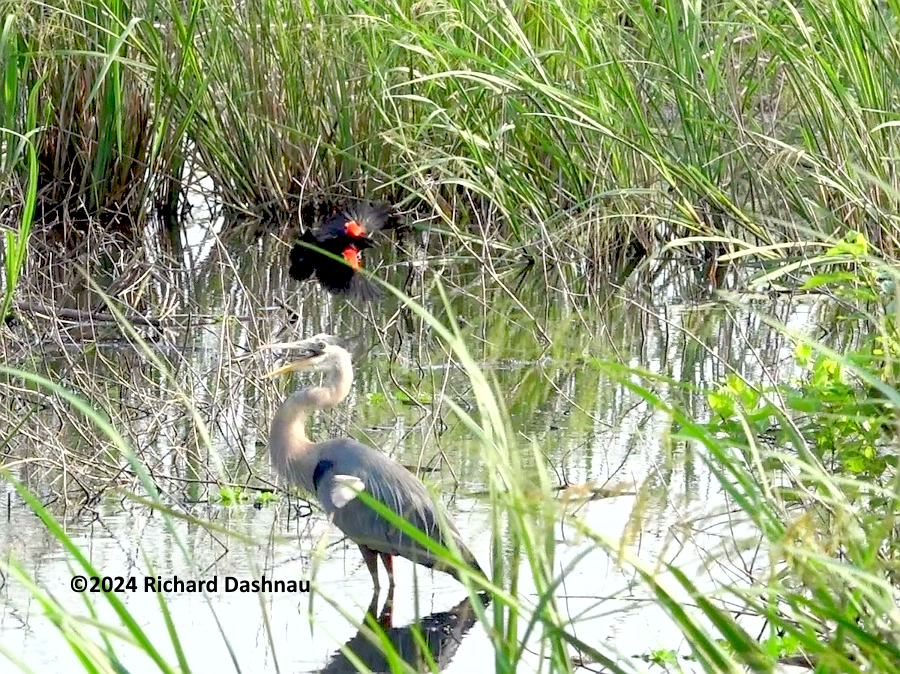
It was over quickly. The Blackbird flew away and didn't return,
and then the Heron also took off. I couldn't tell if there was a nest or
babies around, so have no idea what
angered the Blackbird. While I watched, I wondered if the Heron would
take the Blackbird out of the air. I've seen Great Blue Herons
demonstrate their speed and accuracy
many times. I've seen them stab dragonflies, even out of the
air (I've added a clip from 2022 that shows this to the end of the new video).
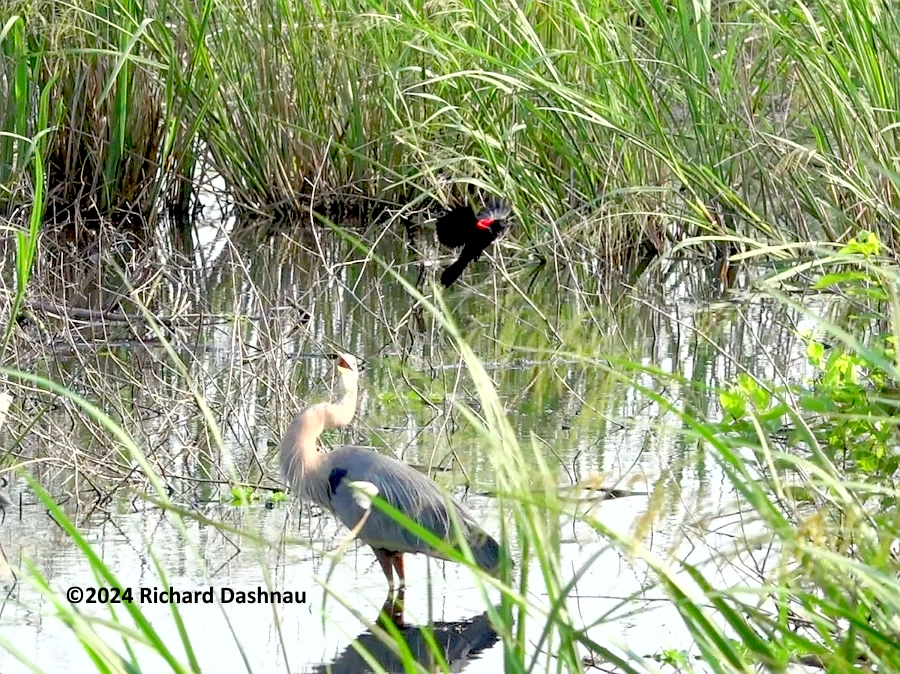
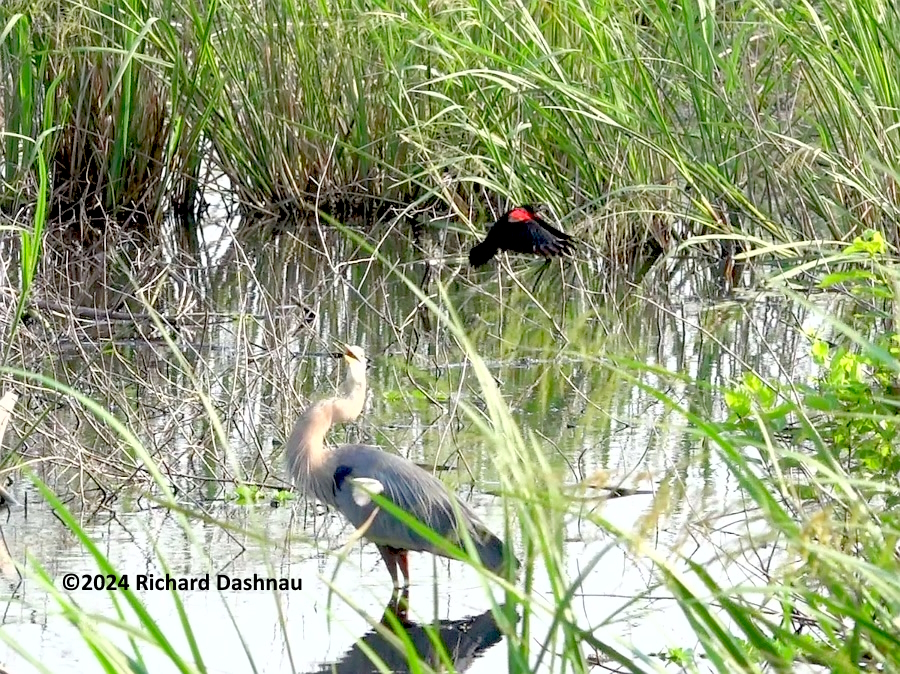
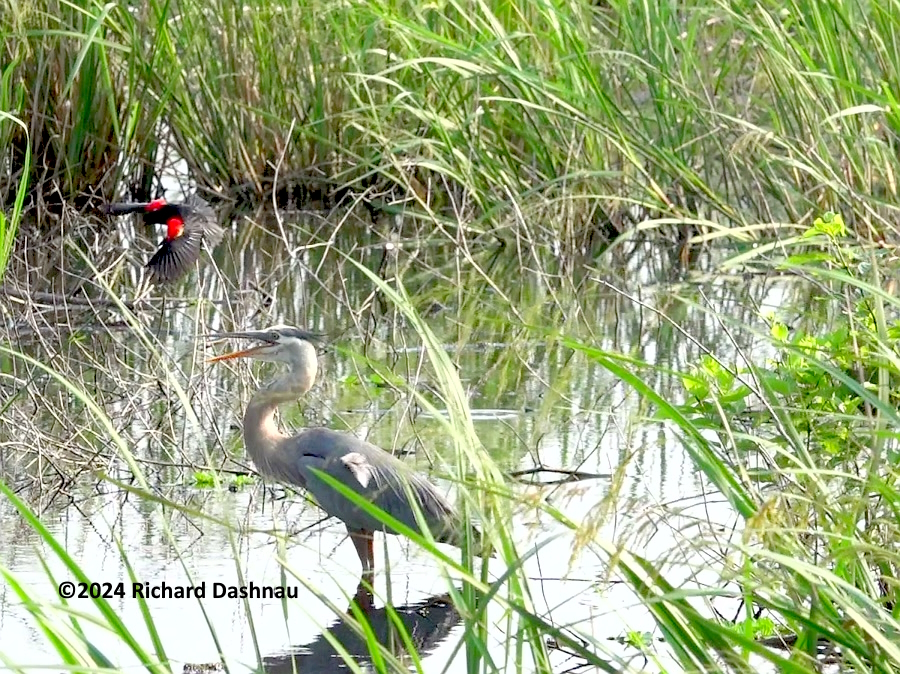
Update
03/19/2024 - 03/10/2024 Brazos Bend State Park I was
watching various wading birds in Pilant Slough near the Observation
Tower at 40 Acre Lake. They were
foraging on the floating plant mats. I like to watch this
behavior to see what the birds are catching. The birds move
quickly, and there are many of them, so it takes some
luck for me to be watching the right bird at the right time to see a
successful capture of prey. It takes even more luck to catch it
with a camera. For a long time (years?) I've
been hoping to film the capture of one specific animal--and today I was
successful! The pictures on not very good, but they are still
clear enough for me to identify the
prey. The Great Blue Heron, Ardea herodias was at least 25 yards away,
and I shot a burst of photos when it grabbed something. I
couldn't identify the prey until I got
home and examined the photos. The images below were taken as a single
burst of photos (at 10 images per second); so the prey was gone in less
than a second.
What was it? The Great Blue Heron had caught and eaten an Eastern
Newt, Notophthalmus viridescens. I've known the newts live here.
We've caught them during our
Pond Life Programs.
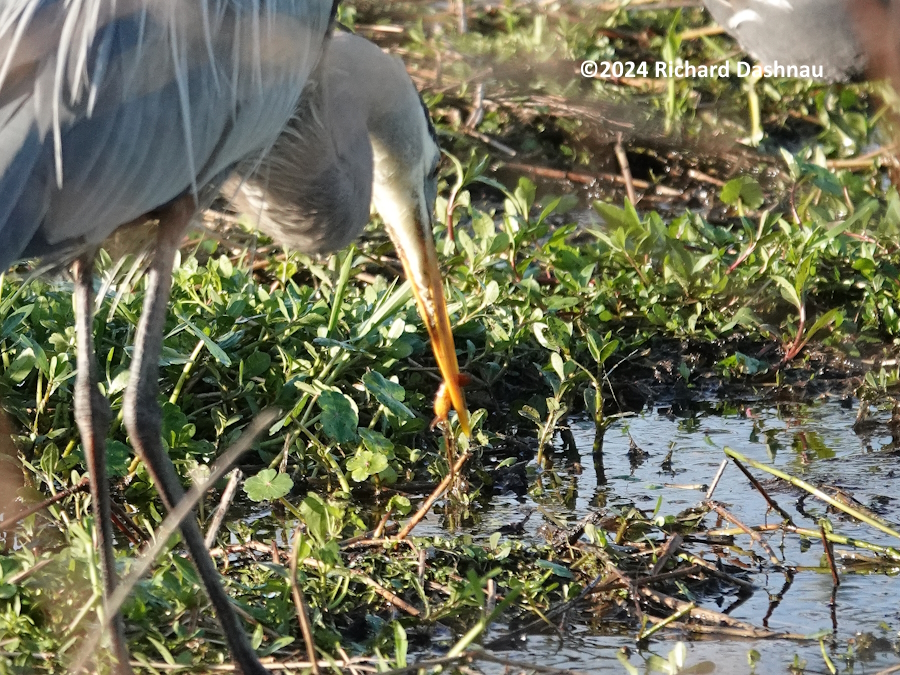
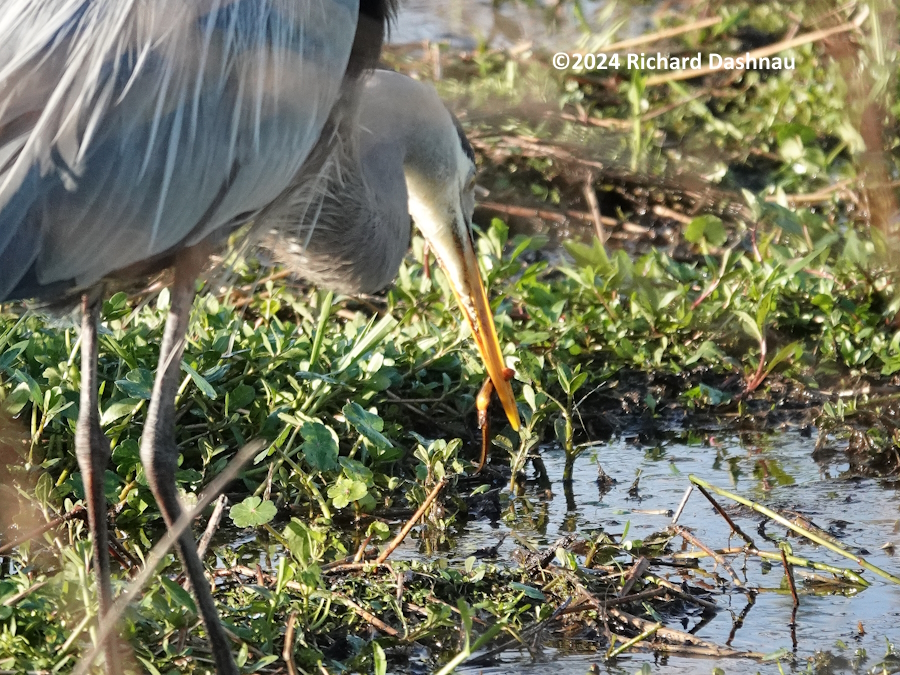
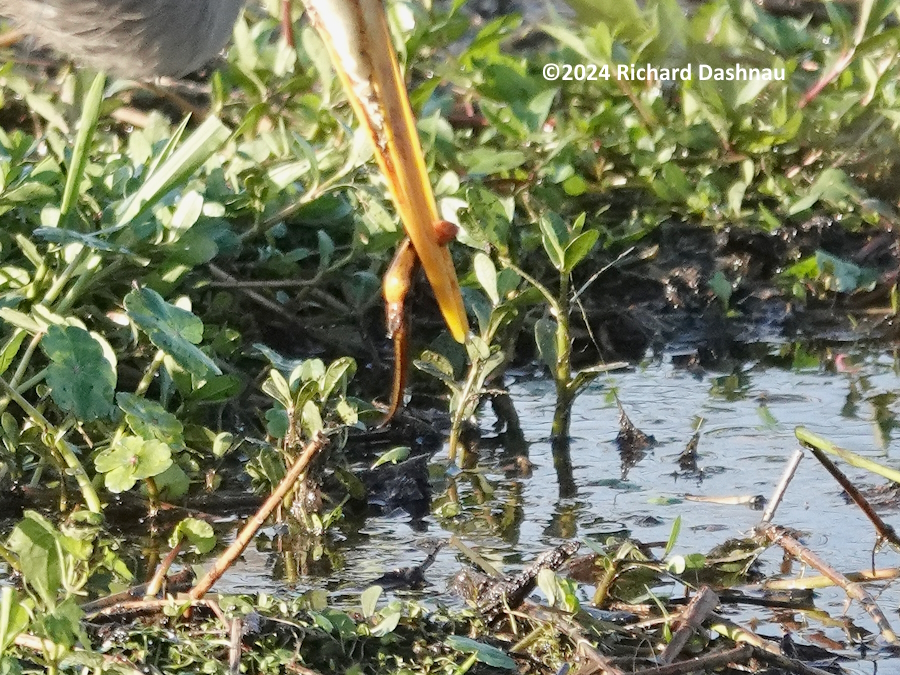
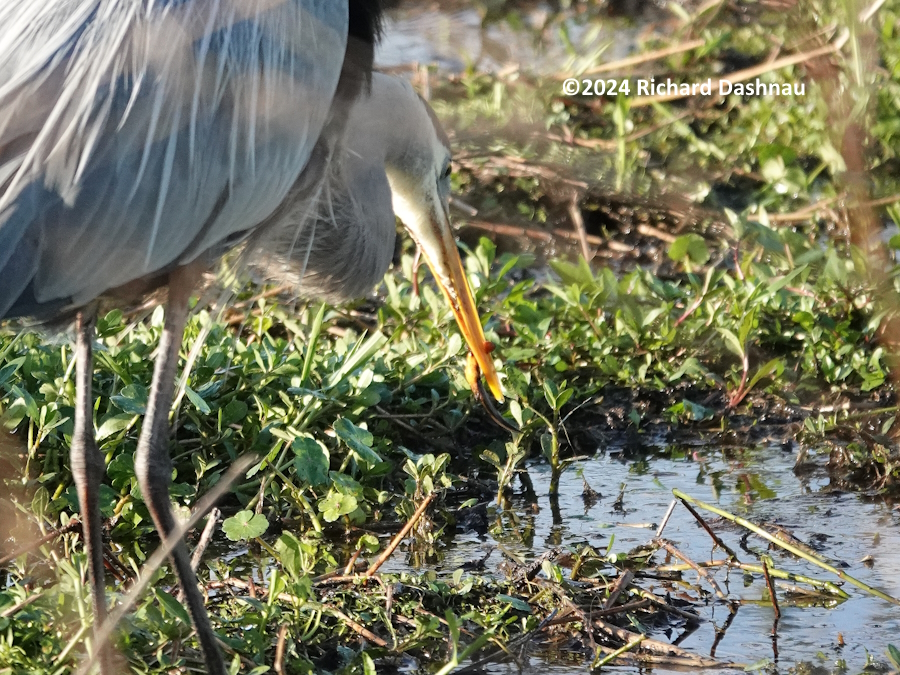
While growing up in the Northeast U.S., I'd
found the newts many times, and had kept them briefly. I'd also found
Red Efts up there, and in that environment I'd found them
nearly the size of adult newts, and VERY bright orange. I had
learned that the Eft stage was toxic, and the orange was a "warning"
color (this is called "aposematic" coloration).
Here's an study:
"Chemical Defense of the Eastern Newt (Notophthalmus viridescens):
Variation in Efficiency against Different Consumers and in Different
Habitats" by Zachary H. Marion, Mark E. Hay.
If you'd like to read it, here's an open-source link(my favorite
kind): https://www.ncbi.nlm.nih.gov/pmc/articles/PMC3229496/
From this study (notes in [[double brackets]] are just my own comments):
1) "Like Taricha newts, the eastern newt (Notophthalmus viridescens) is
assumed to deter predators by secreting TTX, with all life-history
stages reportedly unpalatable to a variety of vertebrate
and invertebrate predators. " [[ TTX=tetrodotoxin. They are toxic
at *all* stages!?!? ]]
2) "The lack of rigorous research on the chemically-mediated
predator-prey interactions involving Notophthalmus viridescens is
surprising given that eastern newts are thought of as keystone
predators that regulate the diversity and abundance of larval anurans,
aquatic invertebrates, and the ecosystem functions of some freshwater
environments." [[ *Keystone predators*!? This little
amphibian? What a great example of how much a single organism can affect
pond life. ]]
3) "The eastern newt (Notophthalmus viridescens Rafinesque,
Salamandridae) is one of the most widely distributed salamanders in
North America and occupies lentic environments
across the spectrum from temporary to permanent water bodies."
[[ Where I come from, I knew them as "Red-Spotted Newt", but
they're the same species. ]]
4) " Notophthalmus viridescens secrete tetrodotoxin (TTX) which
could serve as a chemical defense against predators. Concentrations of
TTX are greatest in the red eft stage,
followed by adults, eggs, and finally larvae." [[ As stated above,
TTX is in all stages, although greatest in the red eft stage (which has
the warning colors). ]]
5) " To assess newt palatability to co-occurring consumers, we used
adult largemouth bass (Micropterus salmoides; 15–20 cm standard length
[SL]), juvenile bluegill sunfish (Lepomis macrochirus; 2–4 cm
SL), the crayfish Procambarus clarkii (9–12 cm total length), and adult
bullfrogs (Lithobates catesbeianus; 12.5–18 cm snout-vent
length)." [[ The list of predators that they used are all
inhabitants at BBSP also.
The crayfish is our big Red Swamp Crawfish. It is native here, and the
same species that is cultivated and served in restaurants. ]]
6) "Here we show that eastern newts, their early ontogeny, and
especially their dorsal skin areas are distasteful to common aquatic
consumers such as fish and crayfish, that fish avoid newts due
to chemical deterrents, and that the compound TTX can produce this
response at small portions of its reported natural concentrations. Yet
some consumers, such as bullfrogs and possibly
other reptiles and amphibians, appear undeterred by TTX." (page 6)
7) "Our results show that the newt Notophthalmus viridescens is
unpalatable to fishes and a crayfish, and that this unpalatability is
chemical in nature, is concentrated in exterior dorsal skin, and is
likely due to TTX or related secondary metabolites. However, this
chemical defense is ineffective against bullfrogs (and possibly
turtles), allowing considerable consumption of tethered newts in
the field." (page 7)
From my observation here, I can add Great Blue Herons to the list of
predators that eat Newts. The last two images below show that the
Newt was swallowed (its head is
visible in image #3), and it was gone after image #4 and the images that
followed (not shown here). It does make me wonder if the TTX has
any effect on the Herons
after they've eaten a newt. I have seen other wading birds catch newts
but it has been a very rare observation, and I have never been able to
capture it on film before.
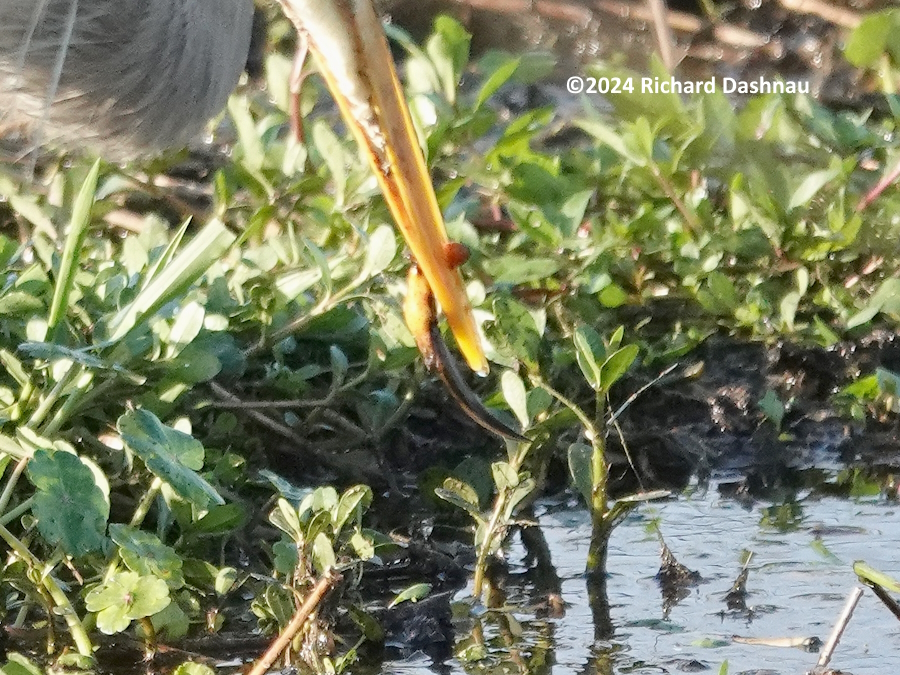
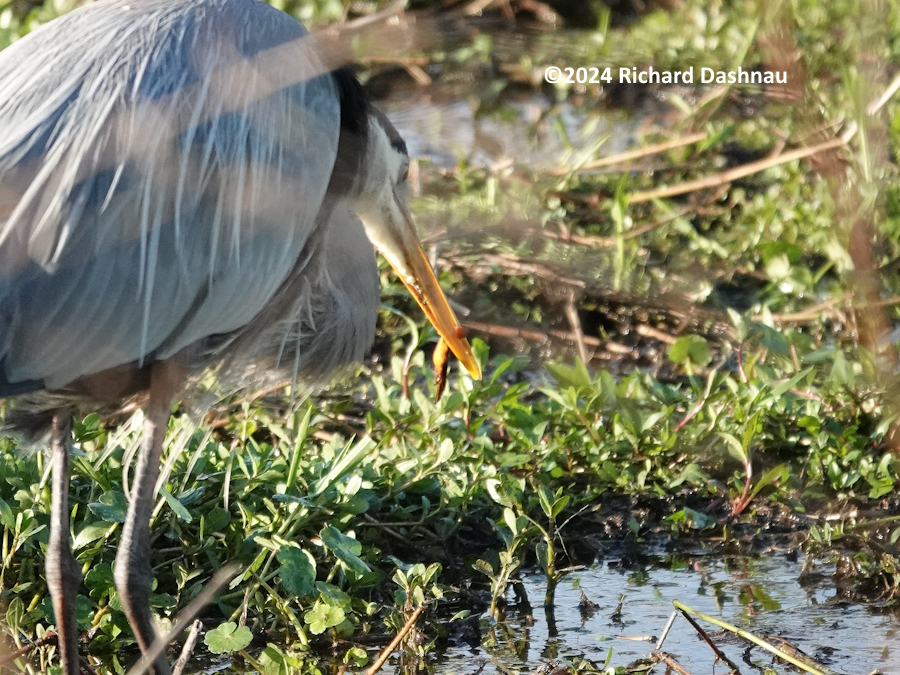
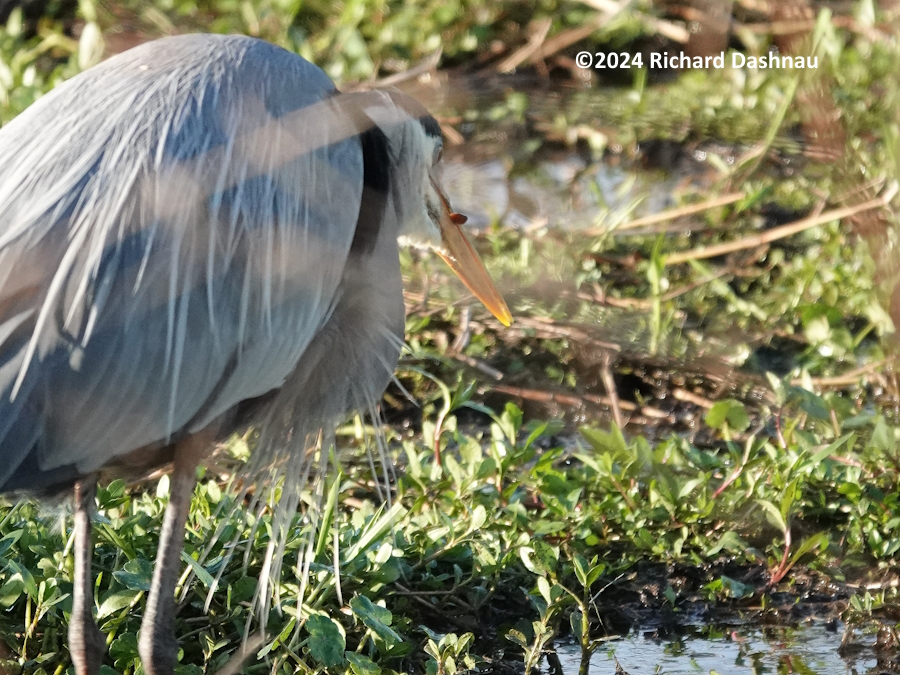
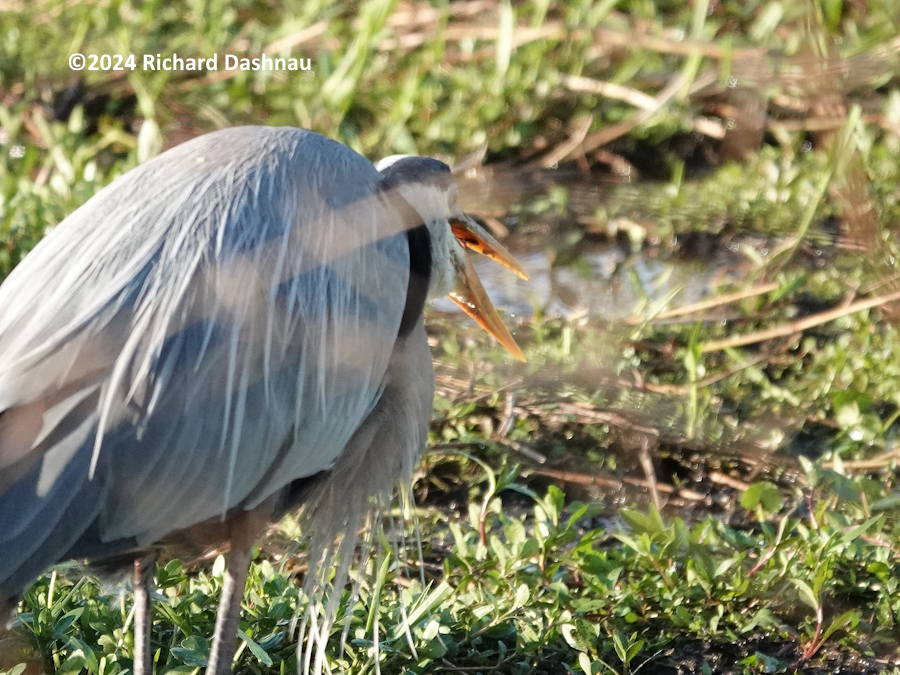
Here's an Eastern Newt, Notophthalmus
viridescens, that we caught at during a Pond Life Program a few weeks
later, on 03/24/2024 .
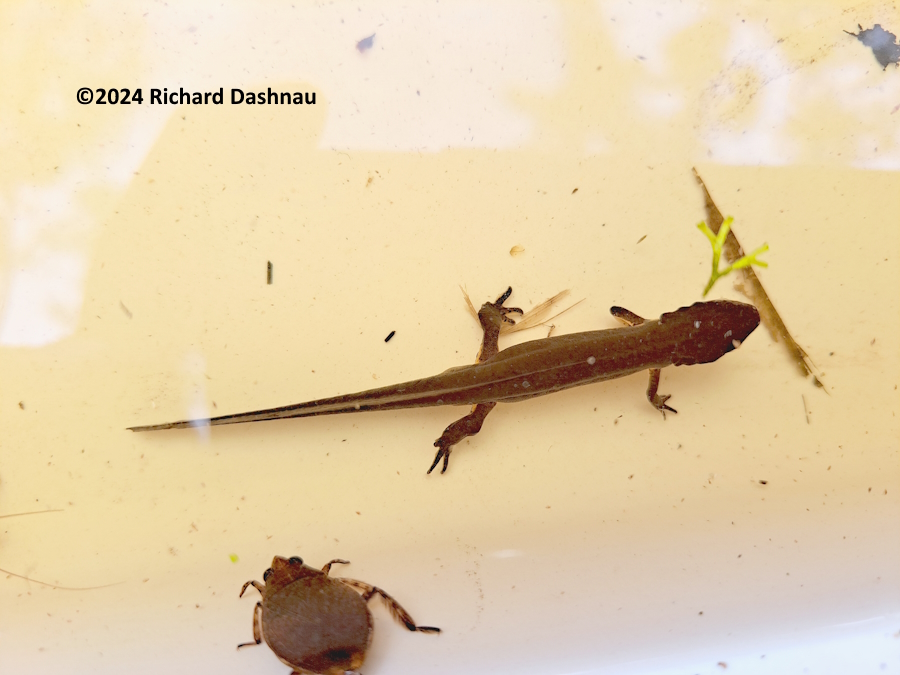
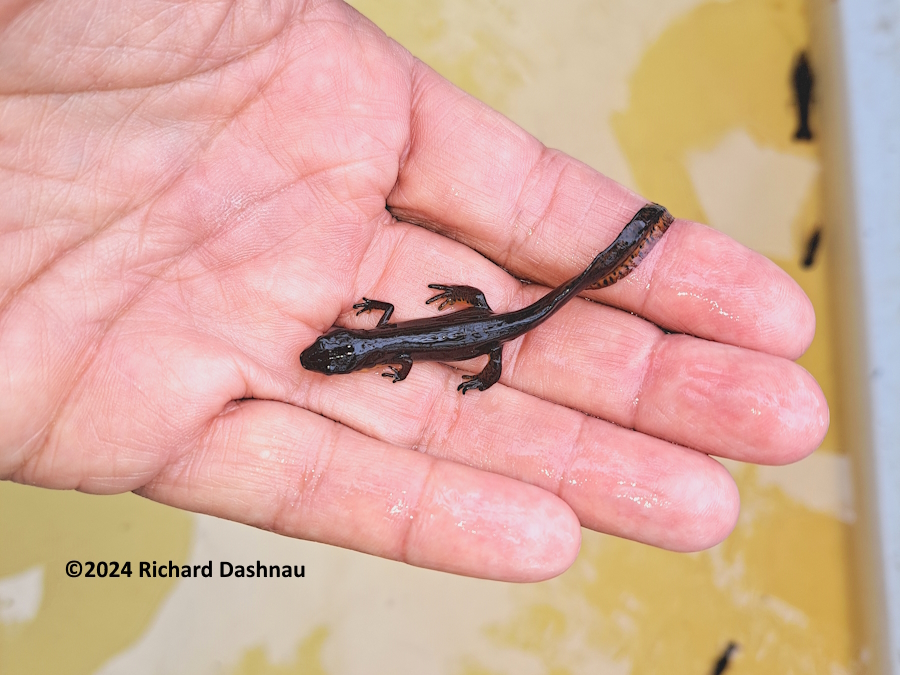
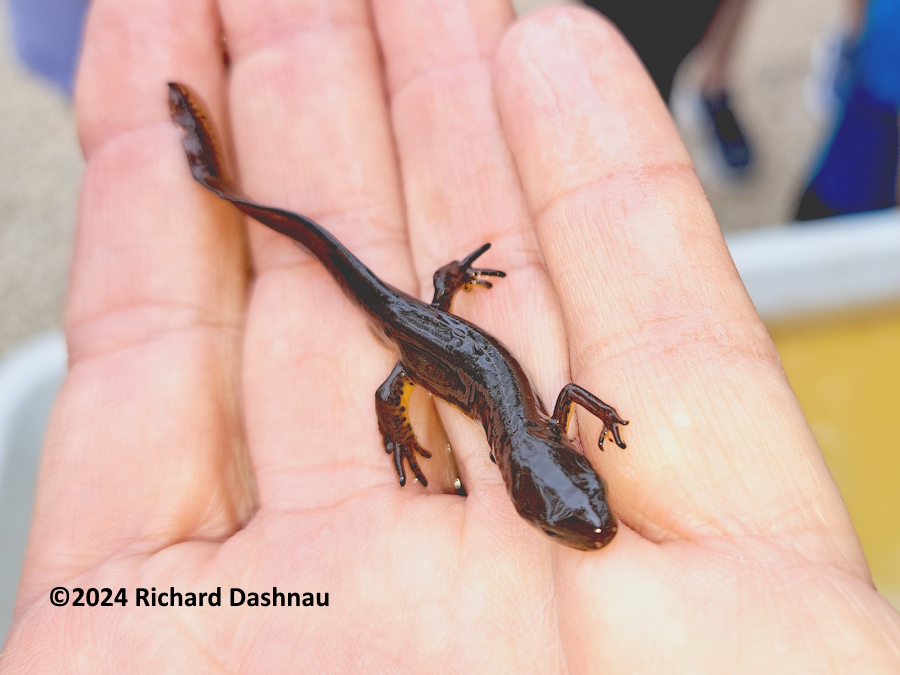
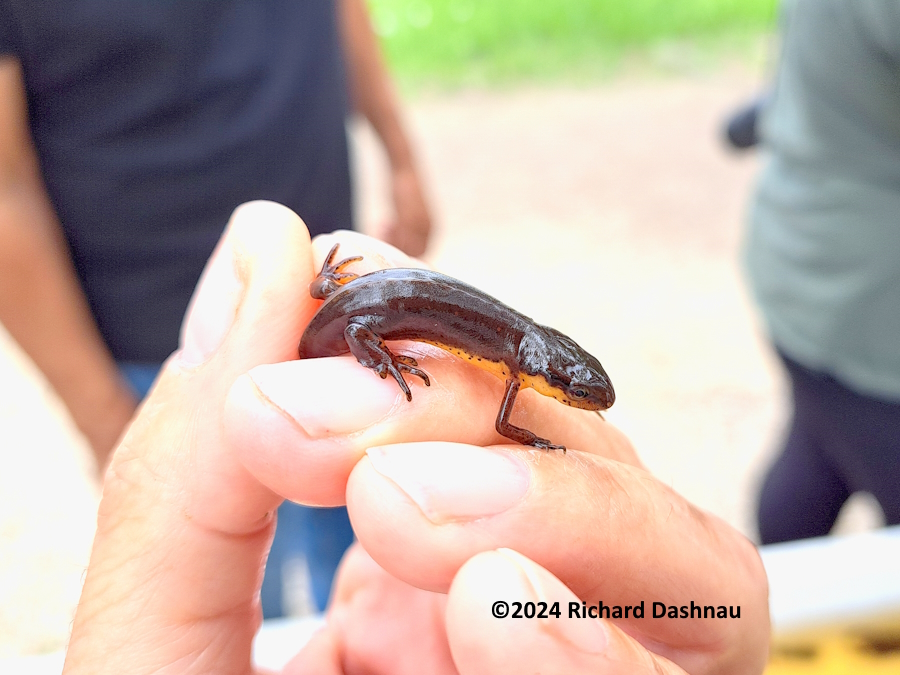
On 01/15/2023
I was at BBSP, and
it was an interesting day. First, about 9:30am,
this Great Blue Heron (Ardea
herodias) caught a Lesser Siren (Siren
intermedia) out of Pilant Slough near
the Spillway Trail. I've seen many GB Herons capture sirens
many times. Here in BBSP my experience leads me to believe
that whenever I see a GB Heron with long, thick, dark
prey--I
assume that it's caught a Lesser Siren. Sirens are
amphibians, described as salamanders that only have 2
front legs(missing the rear legs), and external gills. Some
of these images show
the Siren's short front legs. The row of vertical
grooves on the Siren's side (costal grooves) are also
visible. The wet exterior, thick body, flattened tail, and
the costal grooves help identify the
prey as a siren from a distance. If one is closer then the
two short front legs can sometimes be seen; and a
combination of these elements help distinguish it from a
snake or an eel.
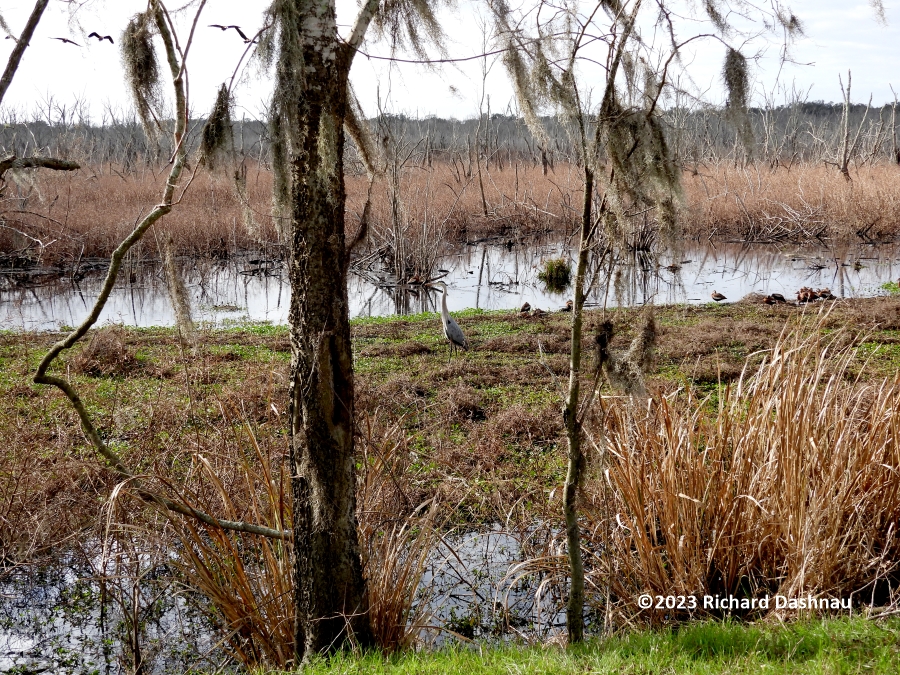
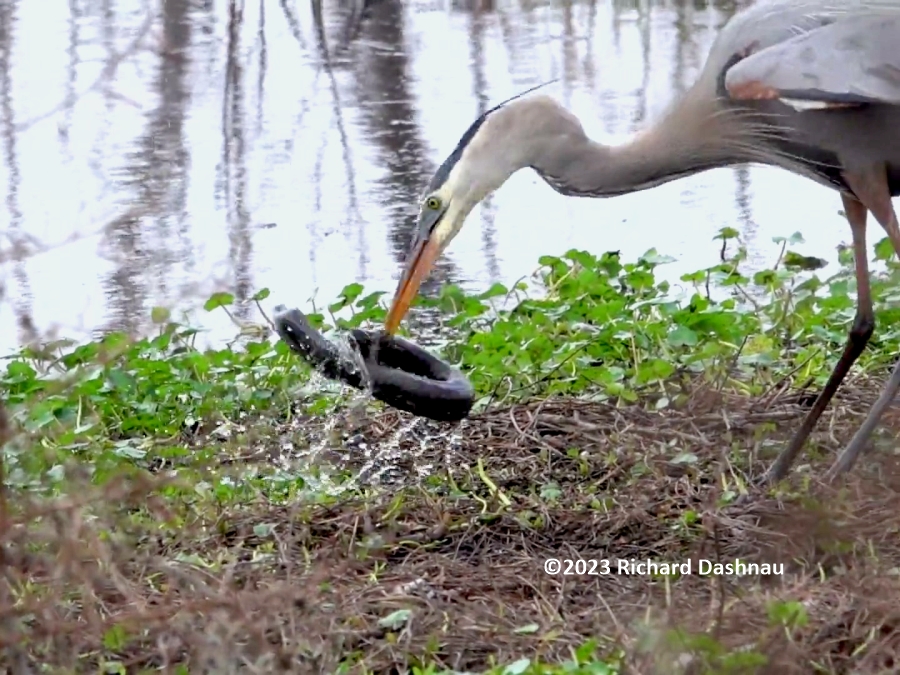
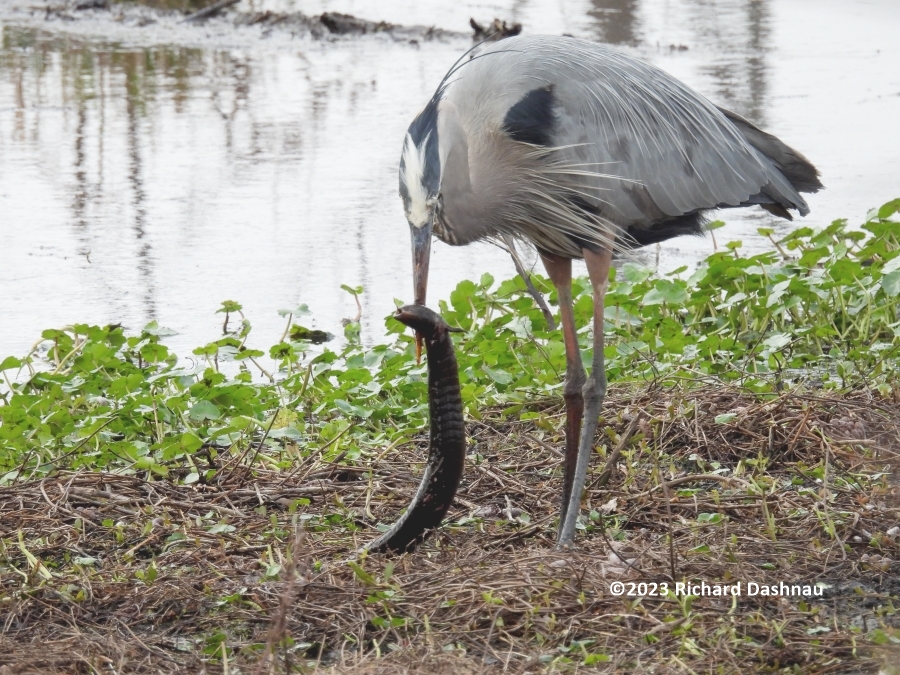
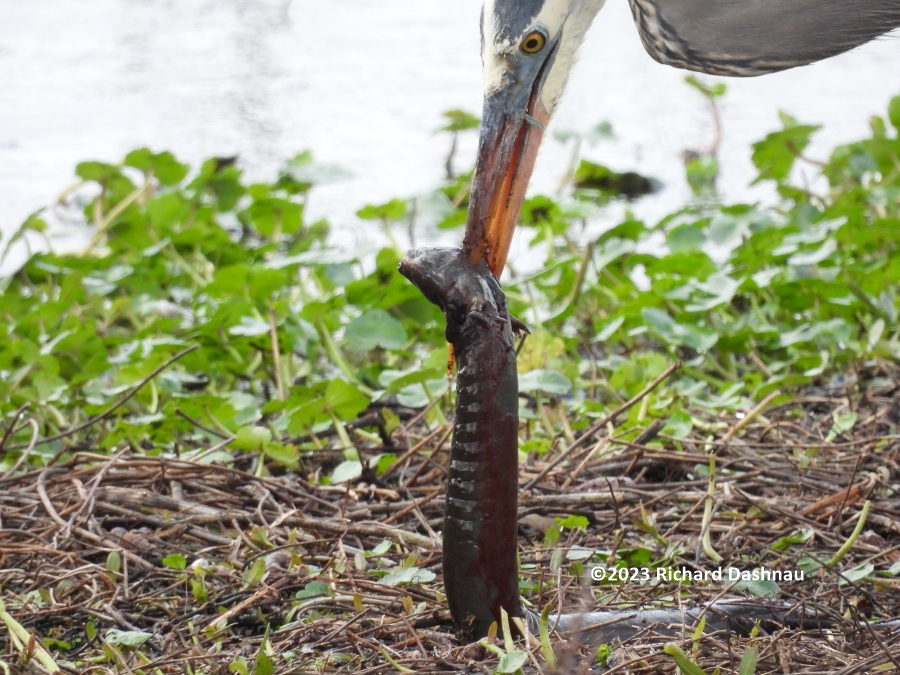
When park visitors see this,
they are often surprised when the Heron swallows the siren.
But many people don't realize that all the wading birds with
long necks and pointed beaks are predators;
and unlike other avian predators (such as Eagles or Hawks),
Herons. Egrets, Bitterns, etc. don't cut or tear their prey
into smaller pieces before eating it. They swallow it
whole. The entire
process seems violent, but the Heron moves precisely and
efficiently. Almost every thrust of its beak strikes its
target; and after the initial capture, most stabs hit a
vital point in the head,
neck, or chest. The power of some of the strikes is
illustrated by the points of the beak fully penetrating the
prey--even going through the skull in some cases.
While editing the video clip,
I discovered that this Heron's stabs at the Siren were very
consistent, and I also tried to figure out how fast those
strikes were. The video was filmed at 60 frames per second
(FPS). Therefore
each frame was 1/60th of a second, or .0167seconds. I
counted frames from when the Heron's head started to move,
to when the neck was fully-extended. This usually took 8
frames (but I used
10 to make things even). That gave me 1/6th of a
second, or .167 seconds for the strike. I estimated
the length of the thrust to be 2 feet ( I couldn't find the
length of a GB Heron's neck
anywhere). If the beak travels 2 feet in 1/6th of a
second, then it will travel 12 feet in a full second; so 12FPS.
12 fps x 60 = 720 feet per minute; 720 x 60 = 43,200
feet per hour;
43,200/5280 = 8.18
MPH. The edited video is here (it's about
10 minutes long, and shows the other event described below).
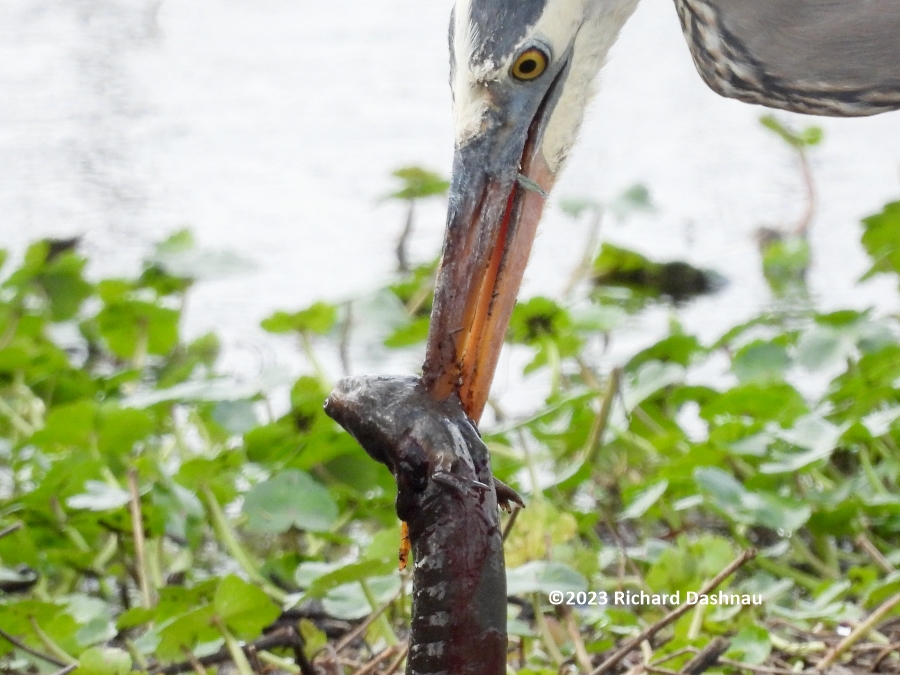
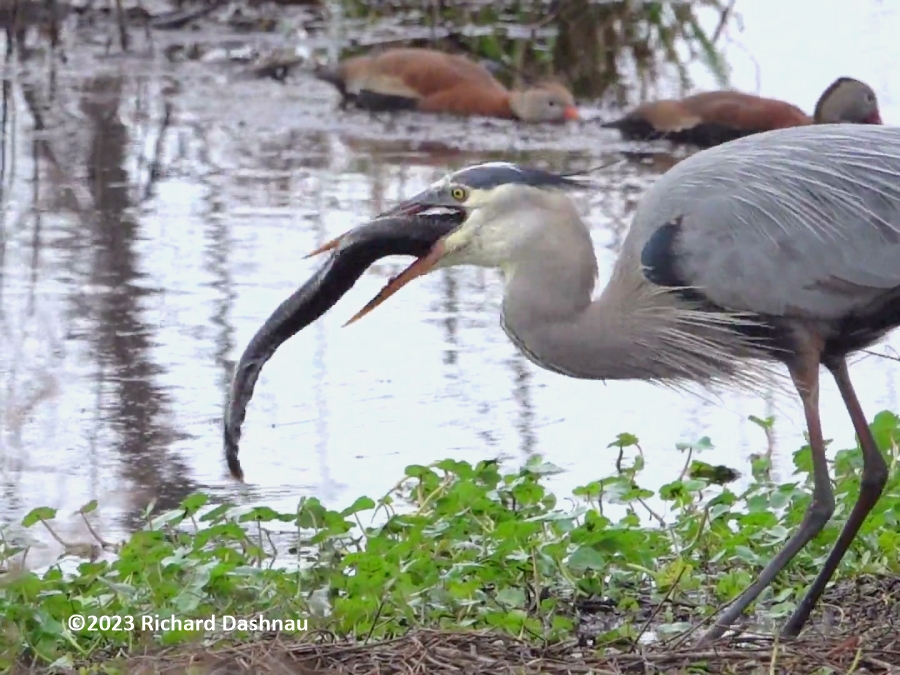
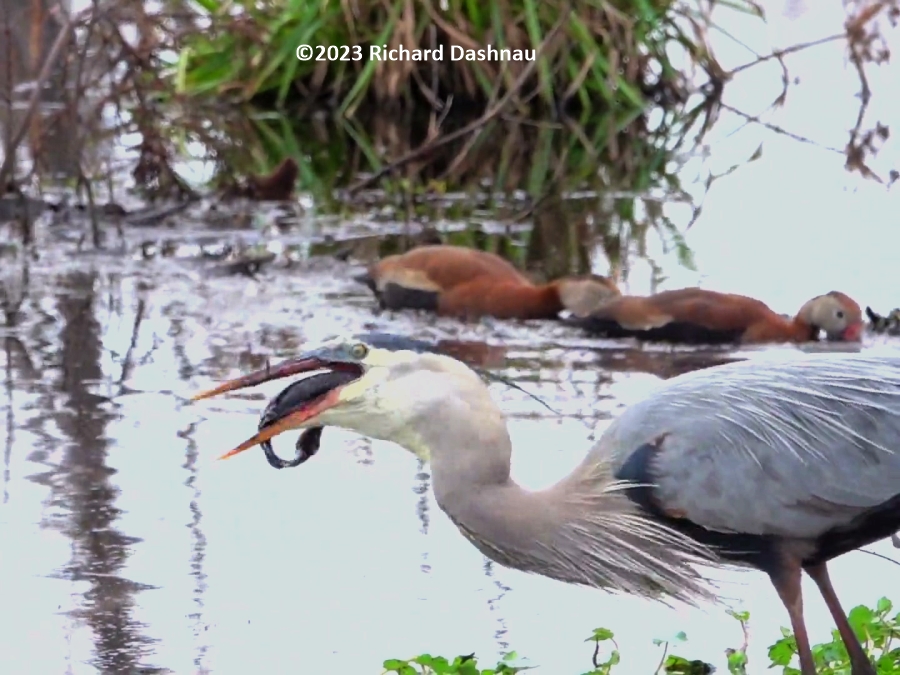
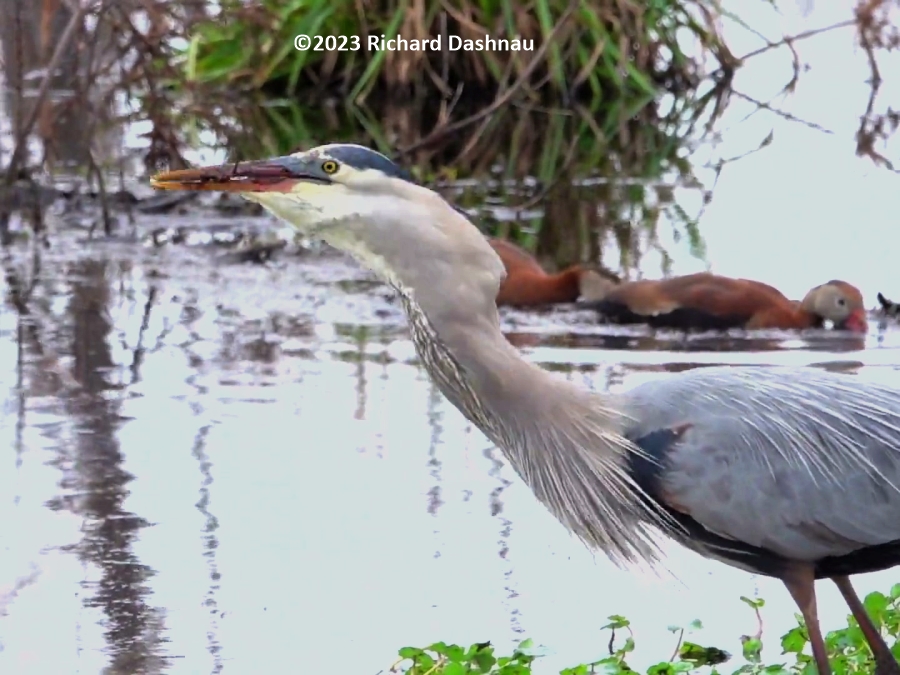
About
2:30pm
I was near the Observation Tower at 40-Acre Lake. About 70
yards East, a Great Blue Heron stalked across the floating
growth carrying squirming prey. As mentioned above,
my experience leads me to believe that whenever I see
a GB Heron with long, thick, dark prey--I assume that it's
caught a Lesser Siren. But another look through binoculars
showed me I was
wrong. I moved closer, along with a group of visitors, to
watch the conflict. This time, the Heron had caught a snake.
And, the snake was a Cottonmouth (Agkistrodon piscivorus)!
The Heron
displayed the snake from all angles, so I could verify
the general chunky body shape, bands with irregular
boundaries, black "stripes" along the sides of the head, and
the shape of the head.
It was a beautiful snake! I was sorry to see it in such a
predicament.
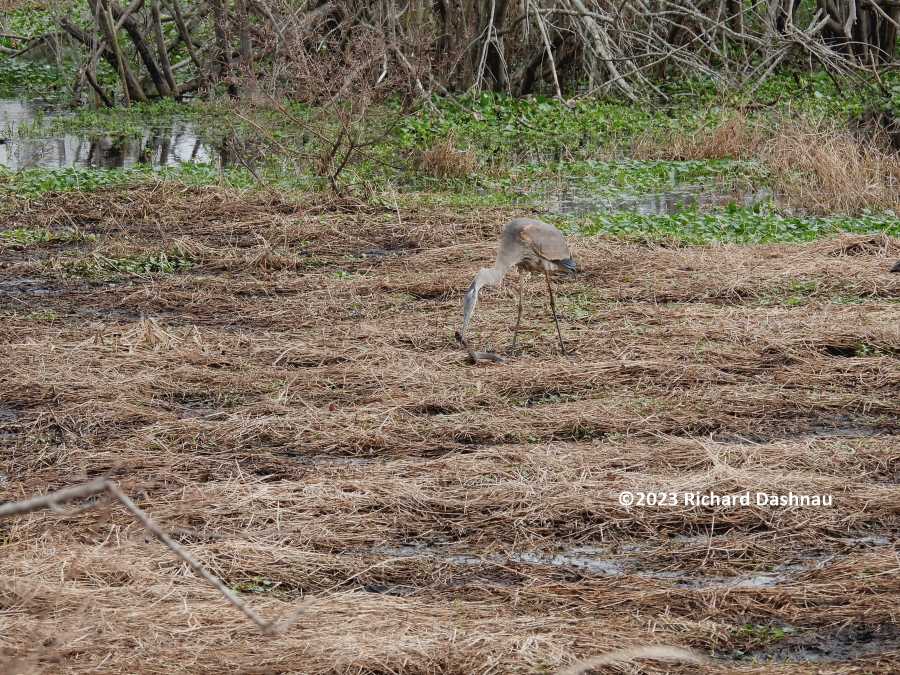
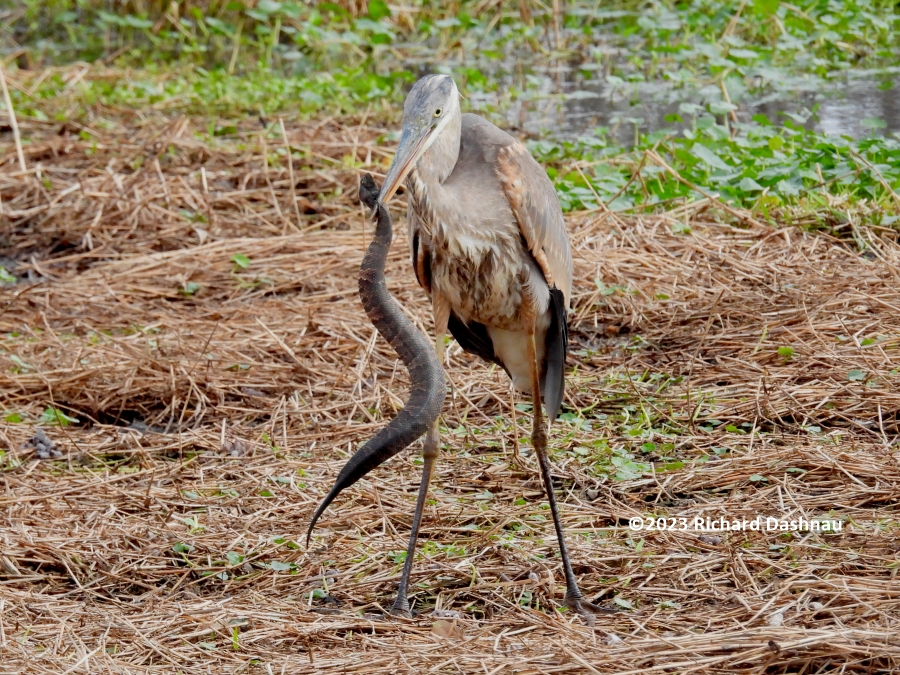
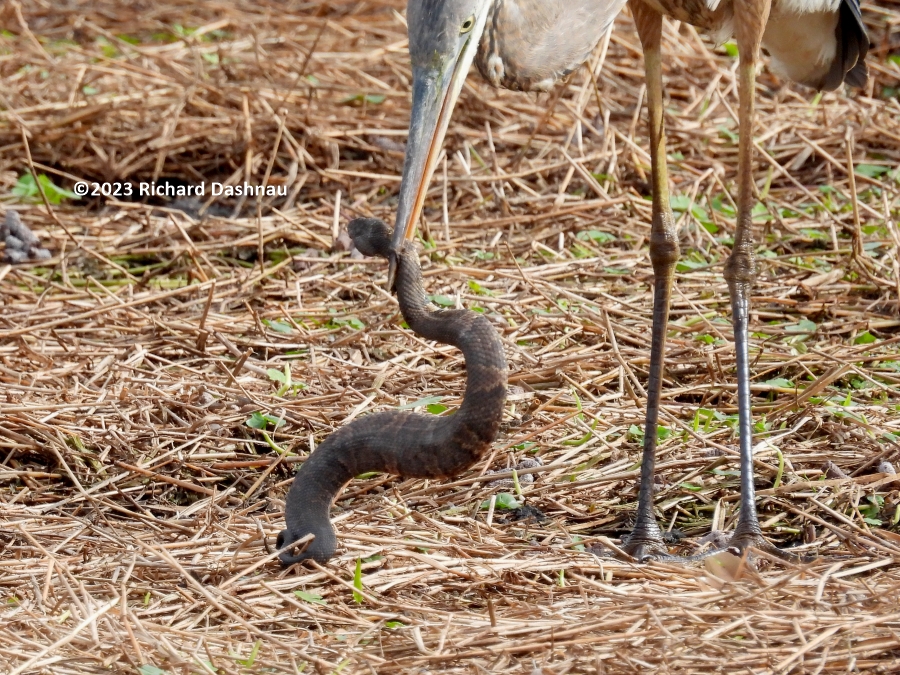
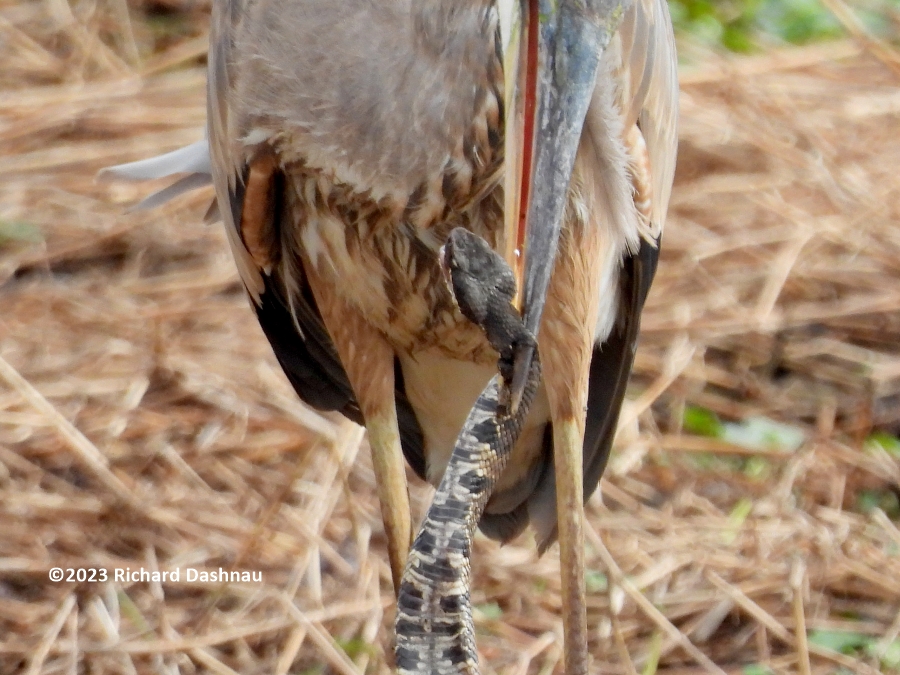
The group of visitors with me
were amazed by the struggle. Some were surprised when I
identified the Cottonmouth and verified that it was
venomous. When they asked how the Heron could
successfully attack the snake without being bitten, I told
them that the Heron was a predator, and an expert at
handling prey. Throughout most of this event, the Heron
maintained a tight grip on
the snake's head, or right behind the head. Most of
the heron's handling involved rapid rotations of the beak
and head--probably trying to break the snake's neck. When a
heron handled a
Siren that morning, it mostly stabbed the Siren and picked
it up (by the front end). If it moved, the heron dropped the
Siren and stabbed it again.
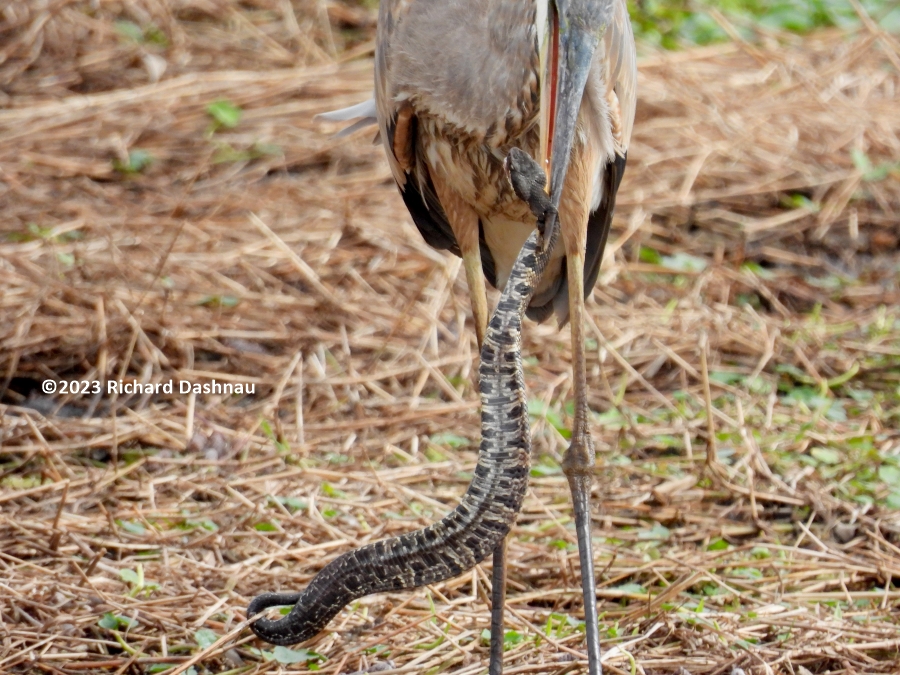
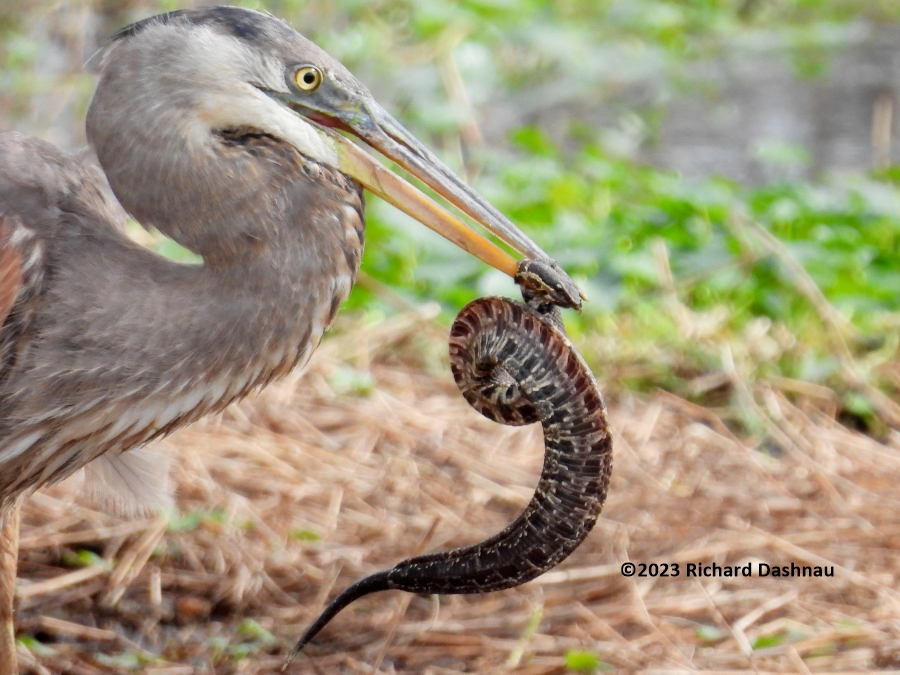
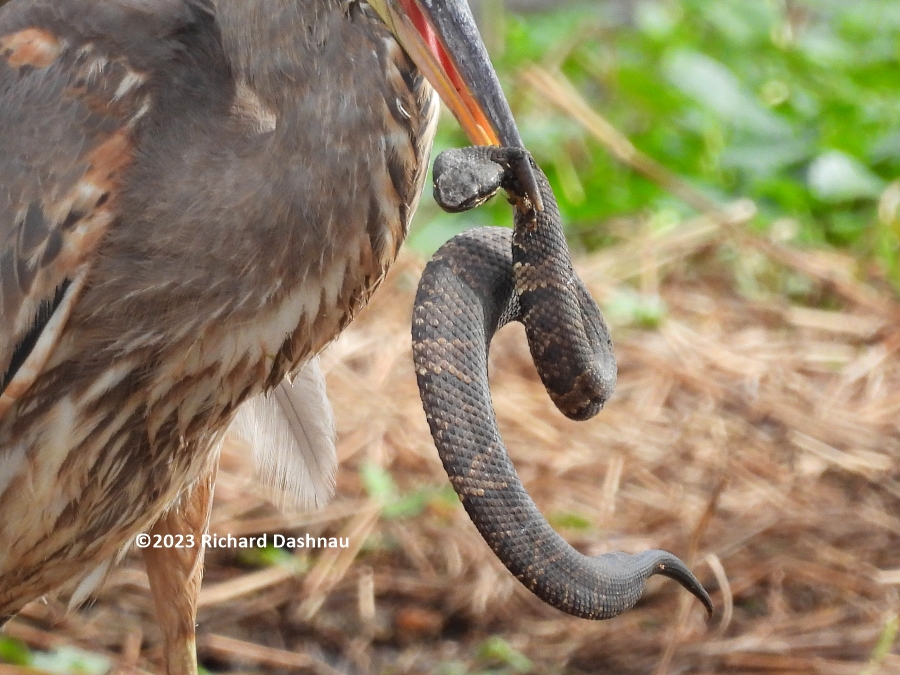
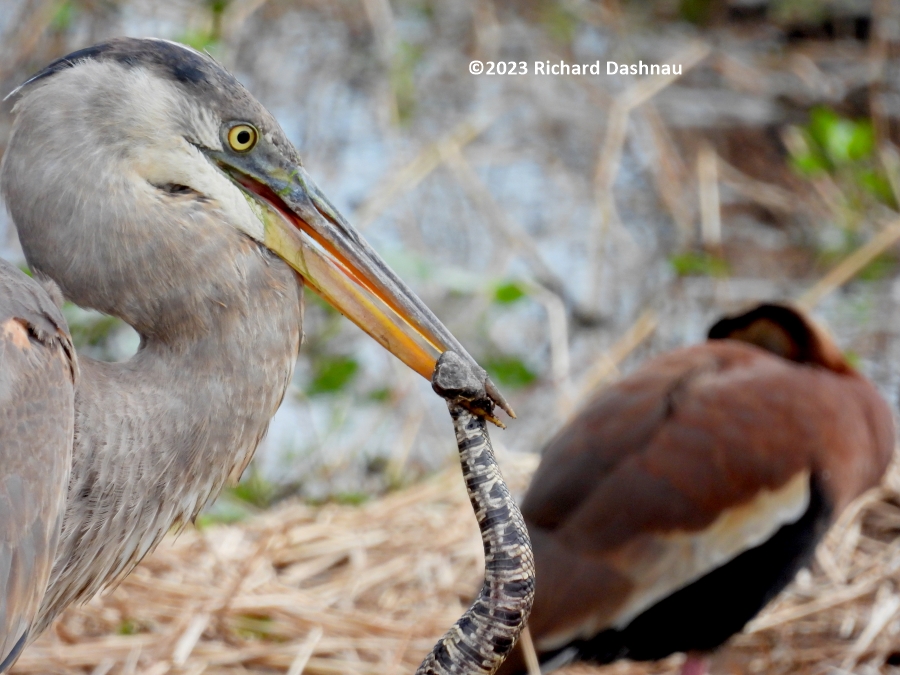
Handling
of the snake was a bit different. There was more apparent
squeezing of the head and neck, and very few "drops" at
first. When the heron did finally drop the snake, it
immediately
stabbed for the skull, and pierced it quickly. This
immobilized the snake, and it was swallowed soon after. The edited video is here (it's about
10 minutes long, and shows the other event
described above).
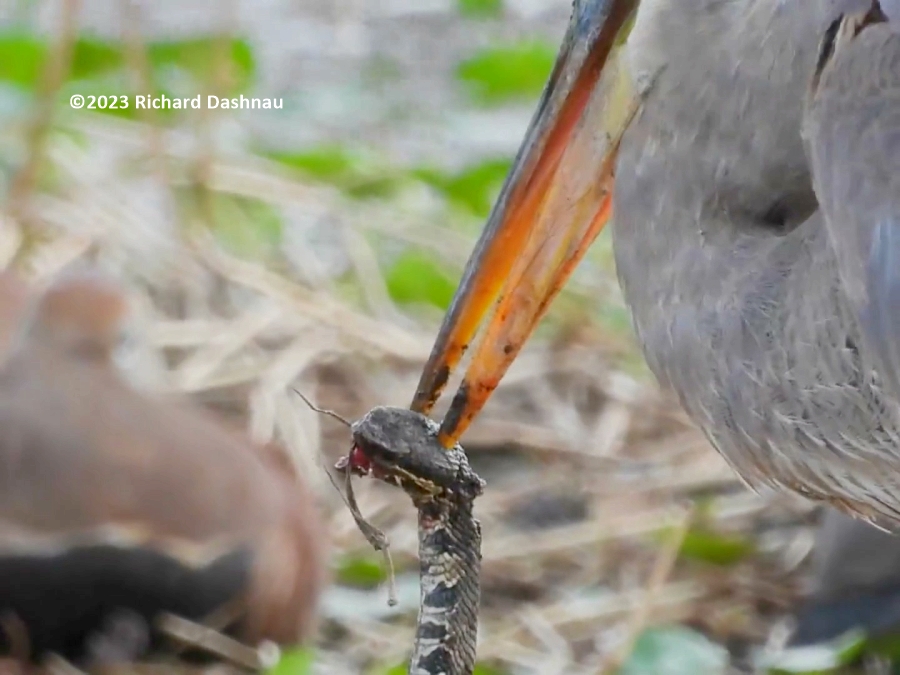
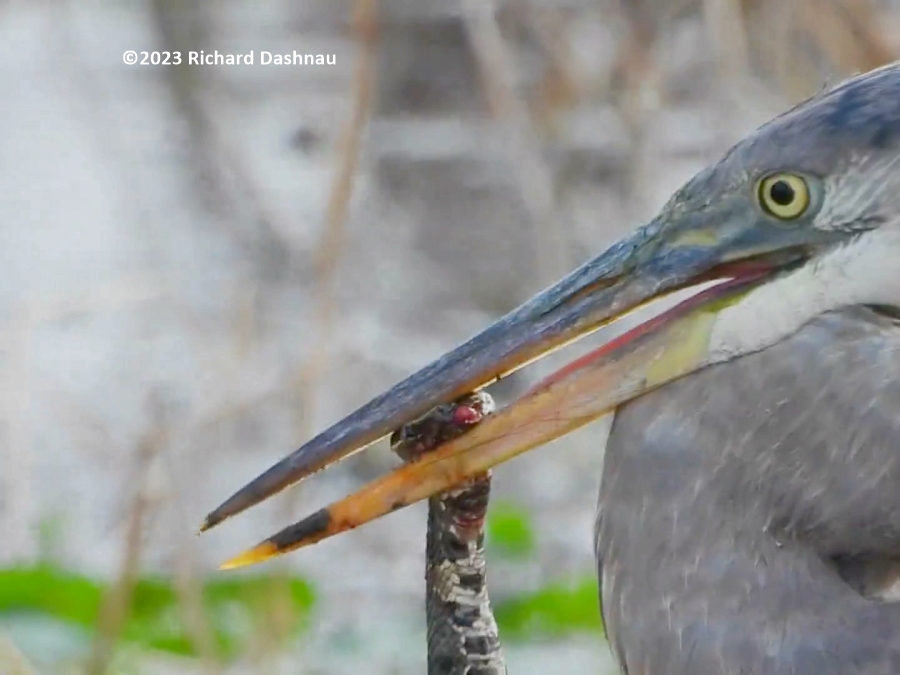
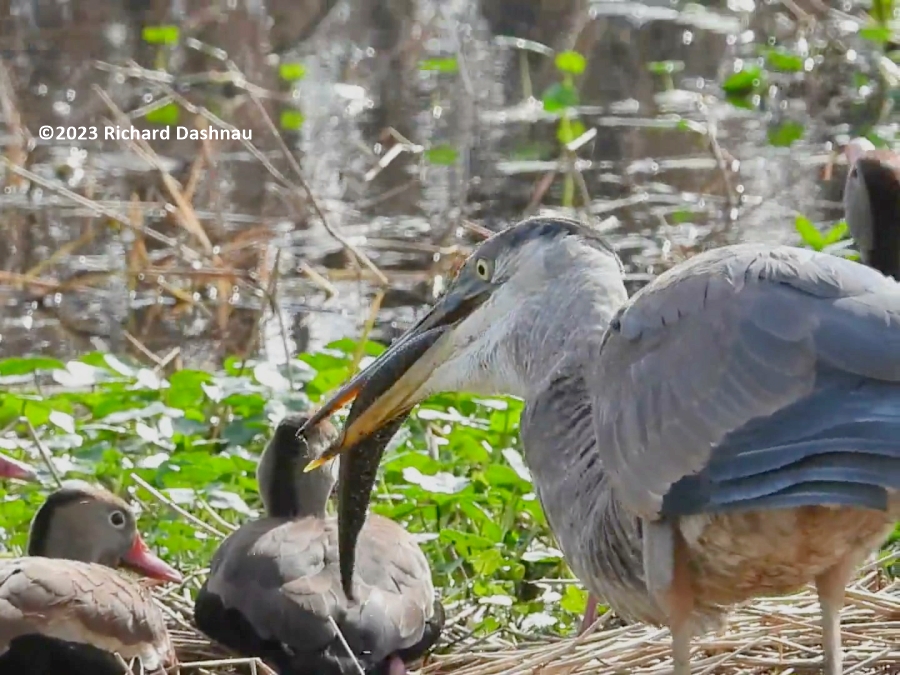
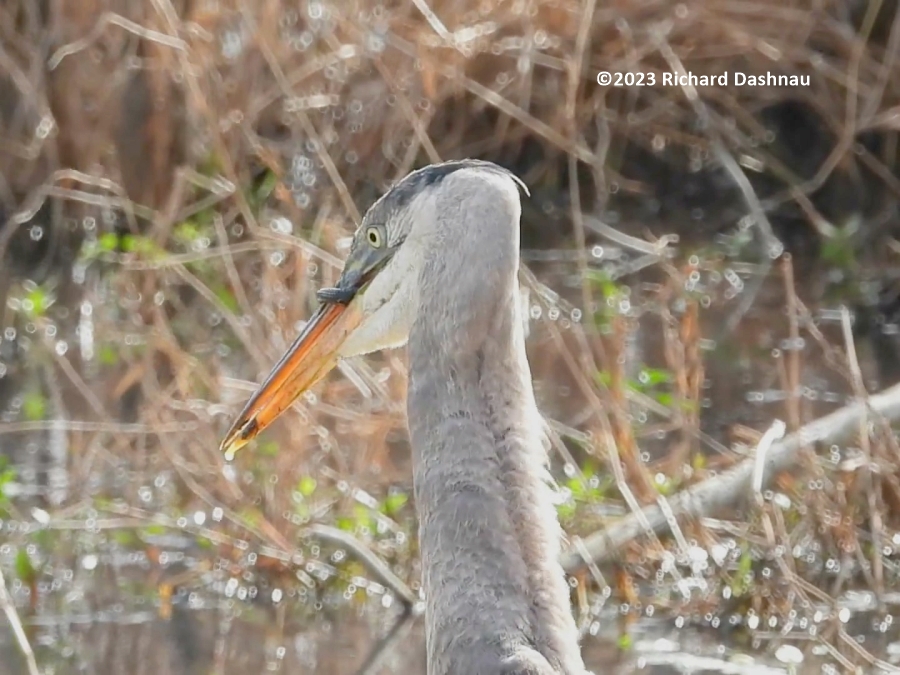
About
2:50pm
a heron caught another snake in the same area. I only
got a short look at it, but from the general color and
shape, and the lines I could see on its belly, I think this
was a
Graham's Crayfish Snake (Regina grahamii)..
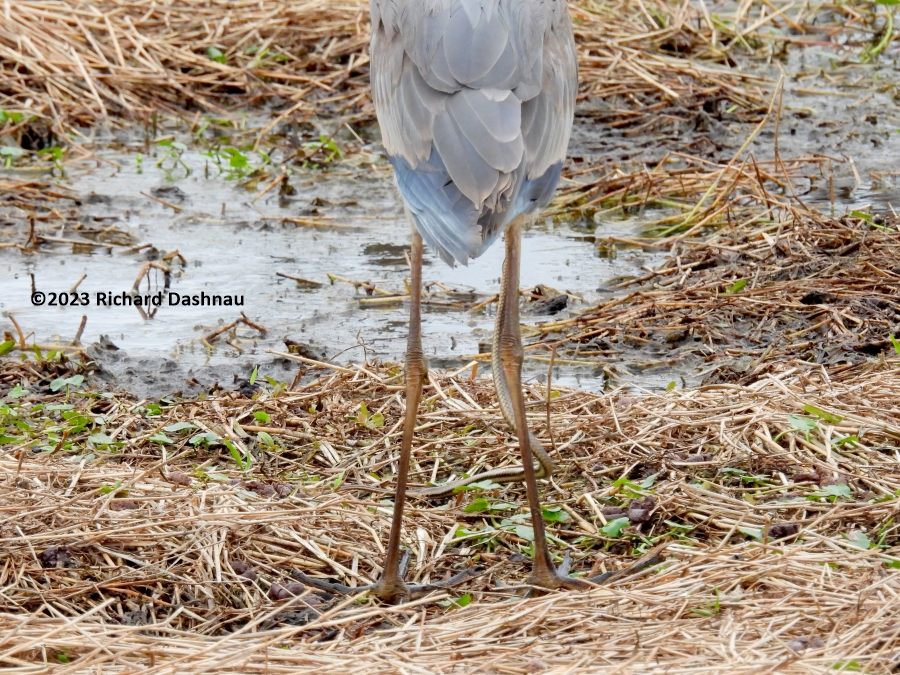
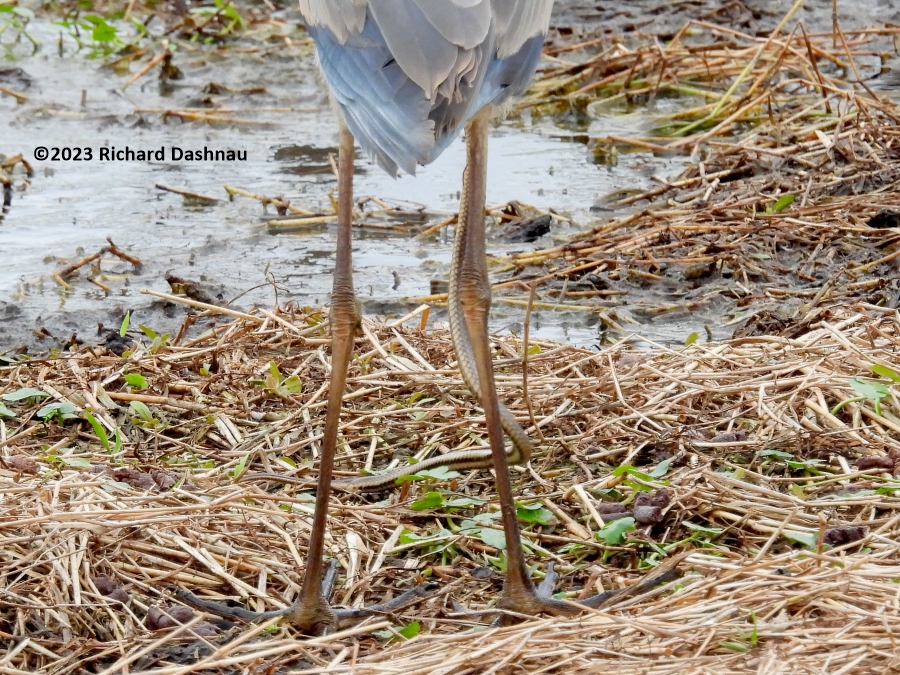
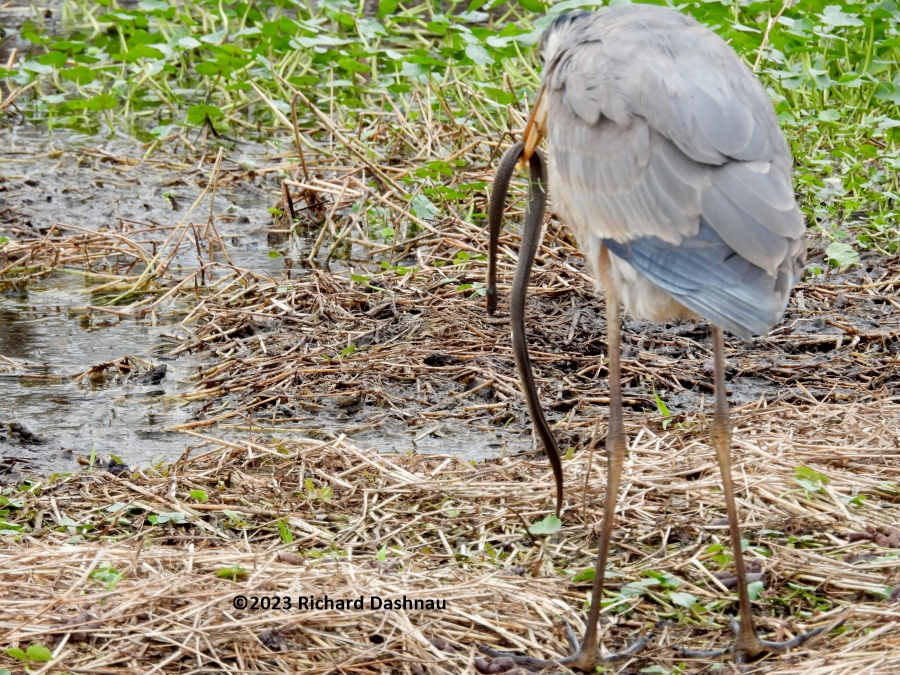
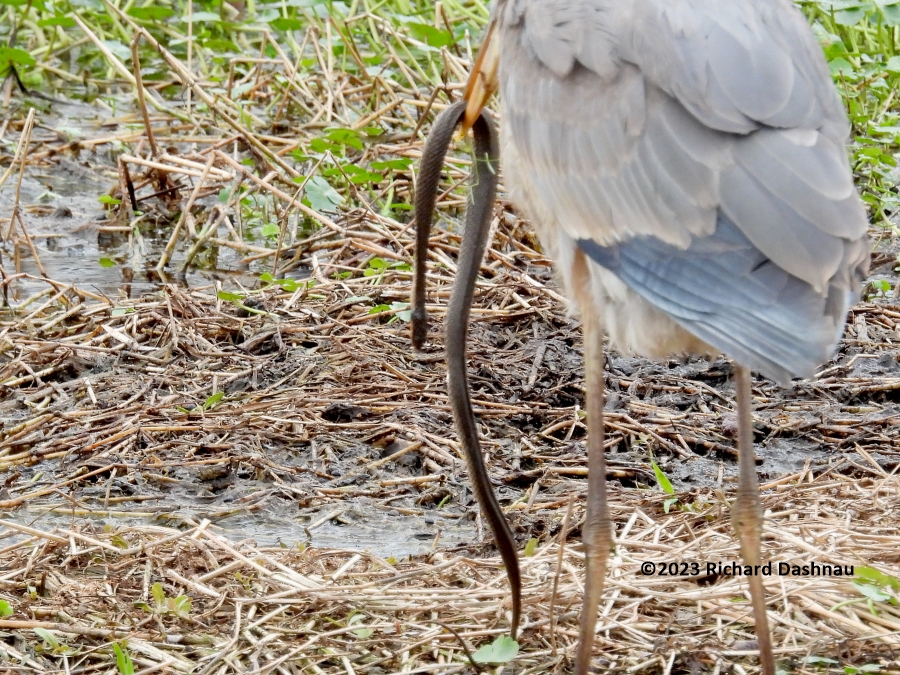
The Heron subdued and ate
this snake very quickly. We can compare the pictures
to see the differences between the Cottonmouth and the
Crayfish Snake and the Siren. The Crayfish Snake
was not as thick as the Siren or Cottonmouth, not glossy,
with markings on belly. The Siren was glossy, dark, with
flattened tail, costal grooves, and legs. The Cottonmouth
had scales,
patterns on back and belly, back of the head much wider than
the neck at that point, and differently shaped head. This
was a lot to see in one day!
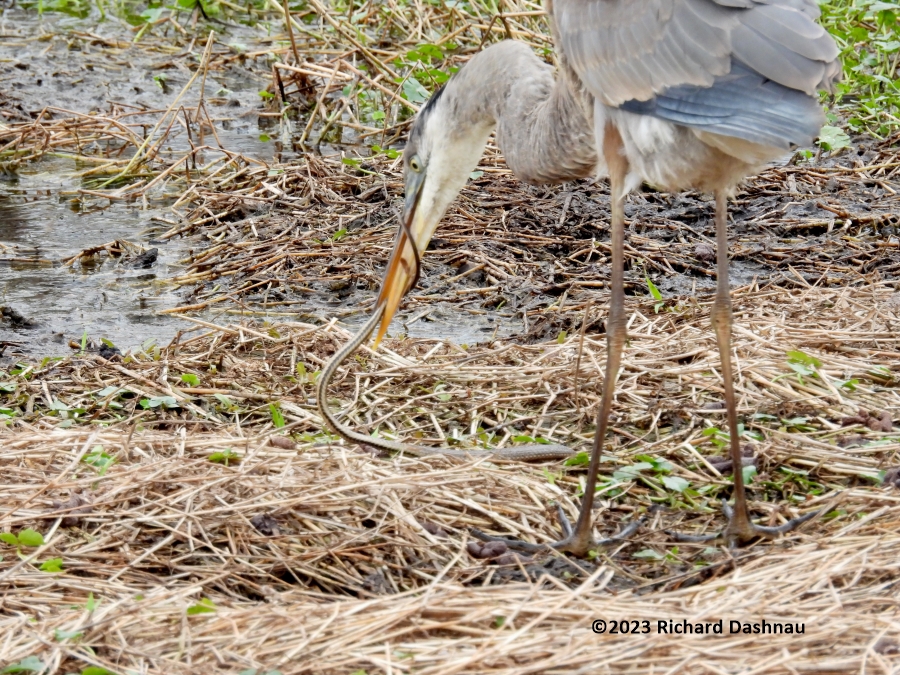
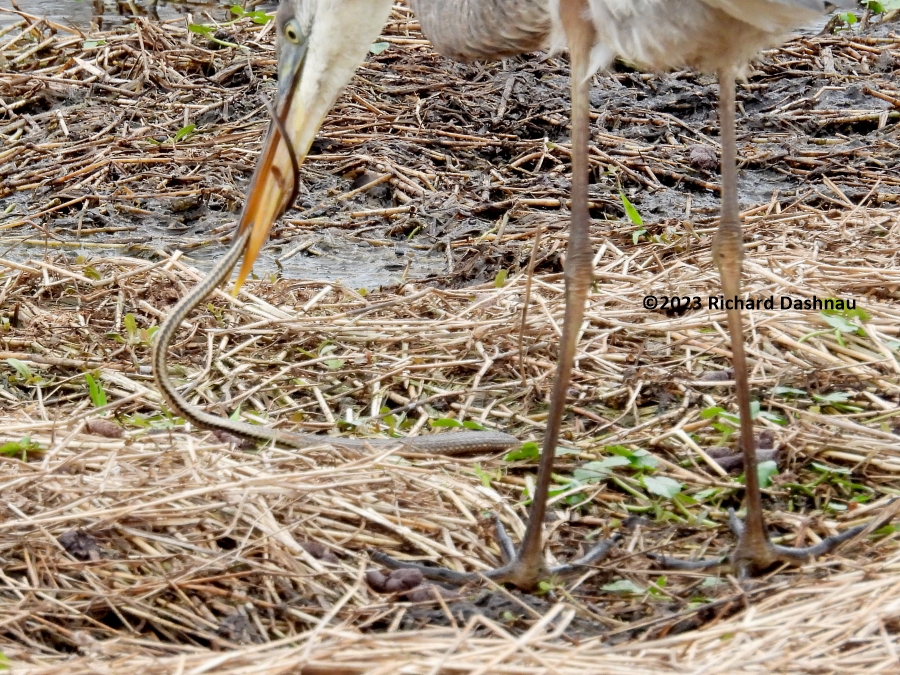
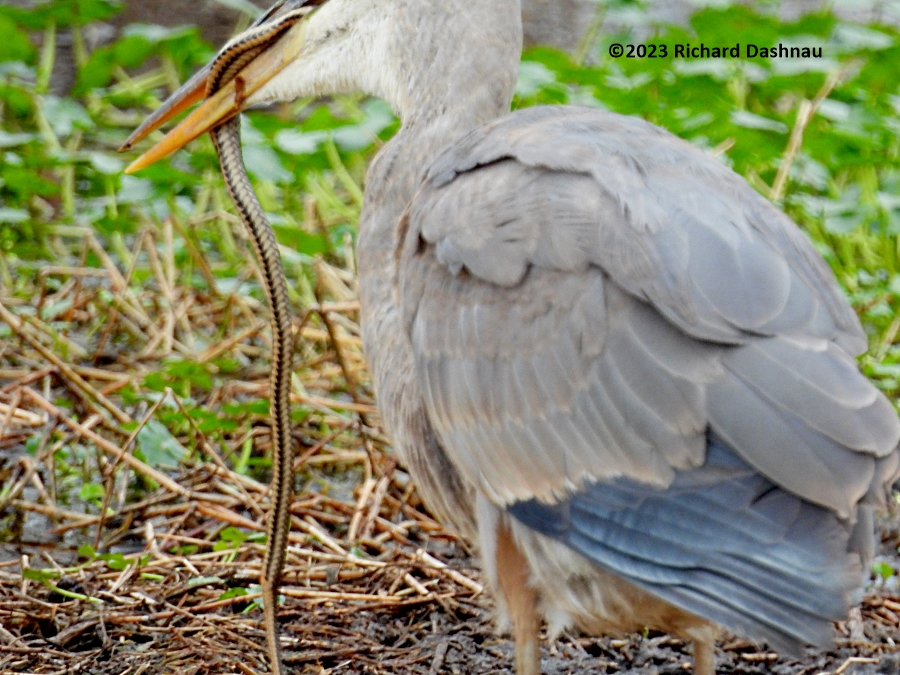
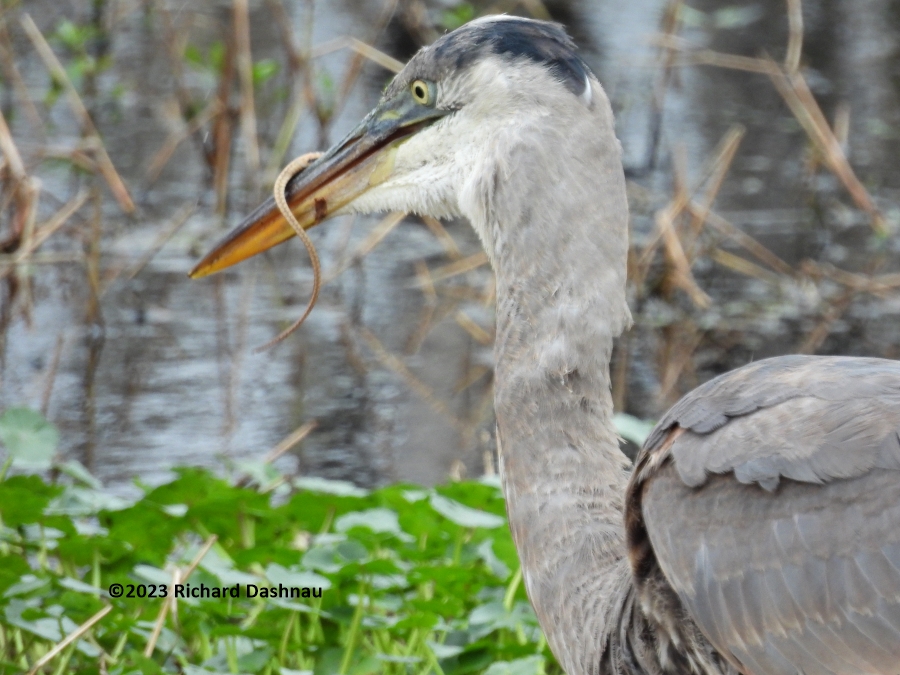
Part 9
of 9 (for parts
1-8 go to this page) : On
12/04/2022
The
water
was still high. In the morning, the mother alligator was
visible, but I couldn't see any of the babies at first.
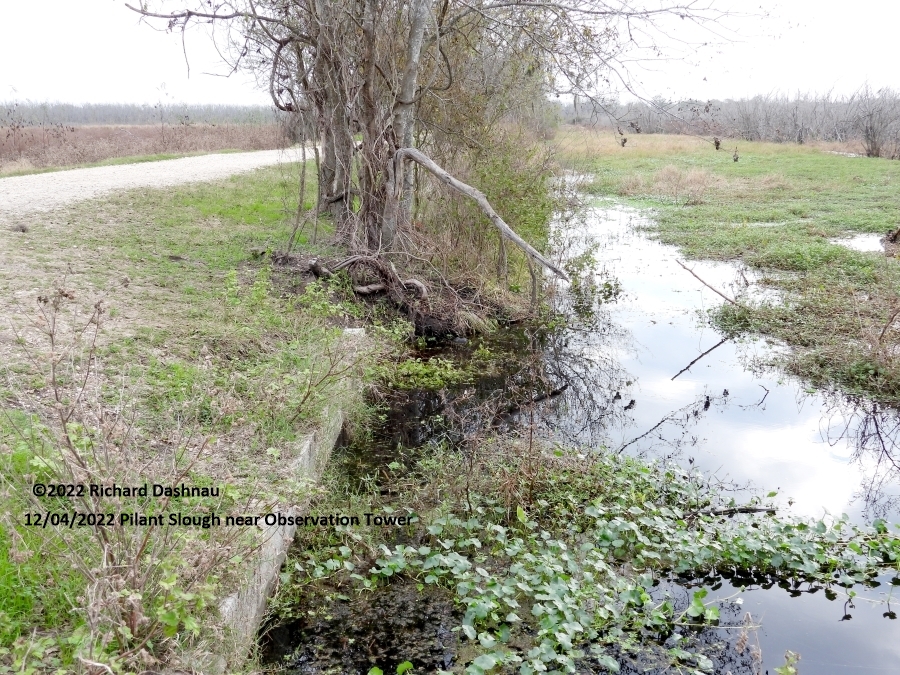
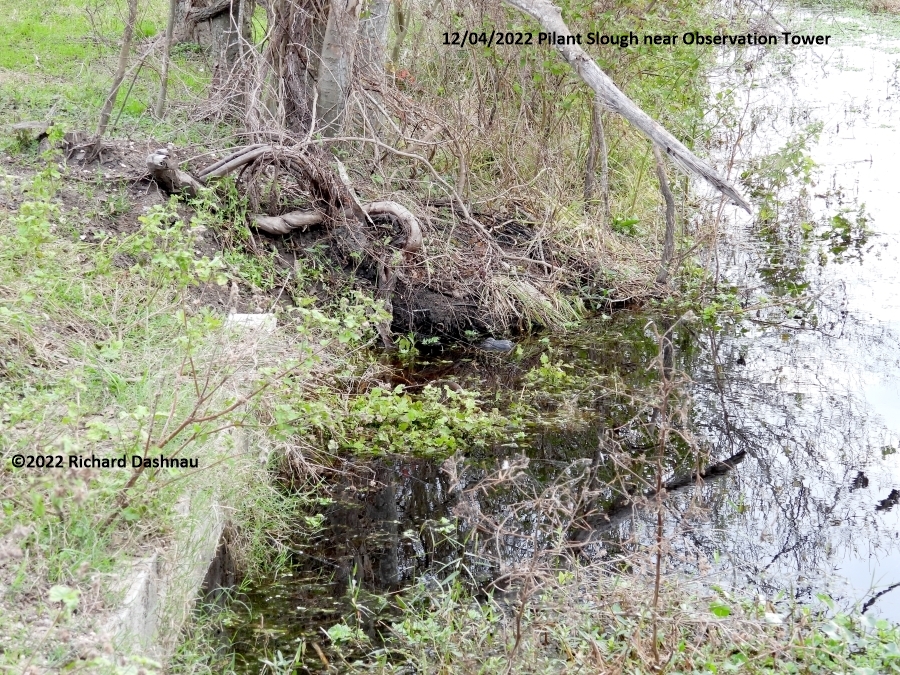
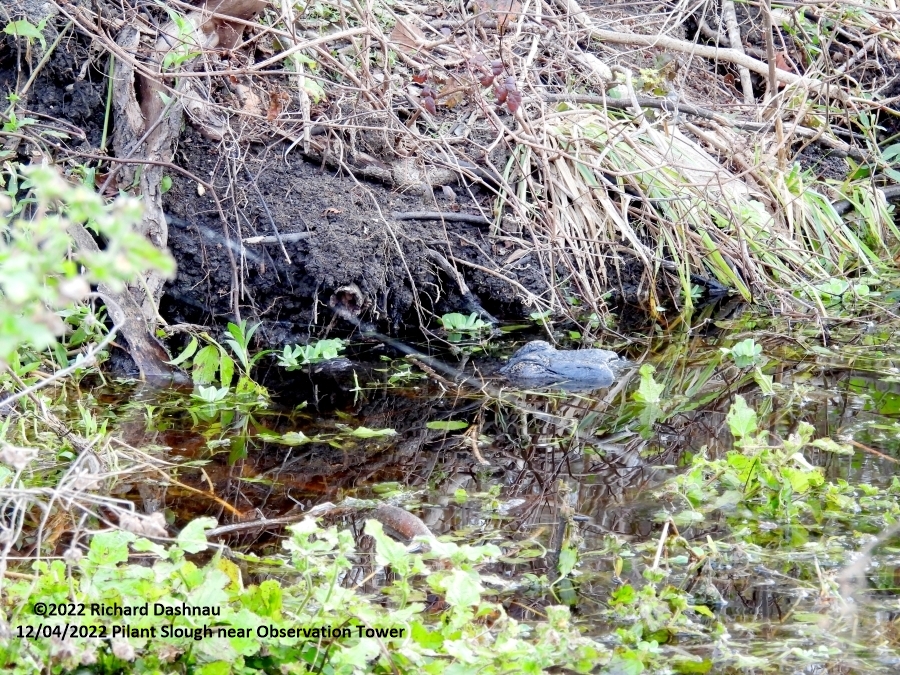
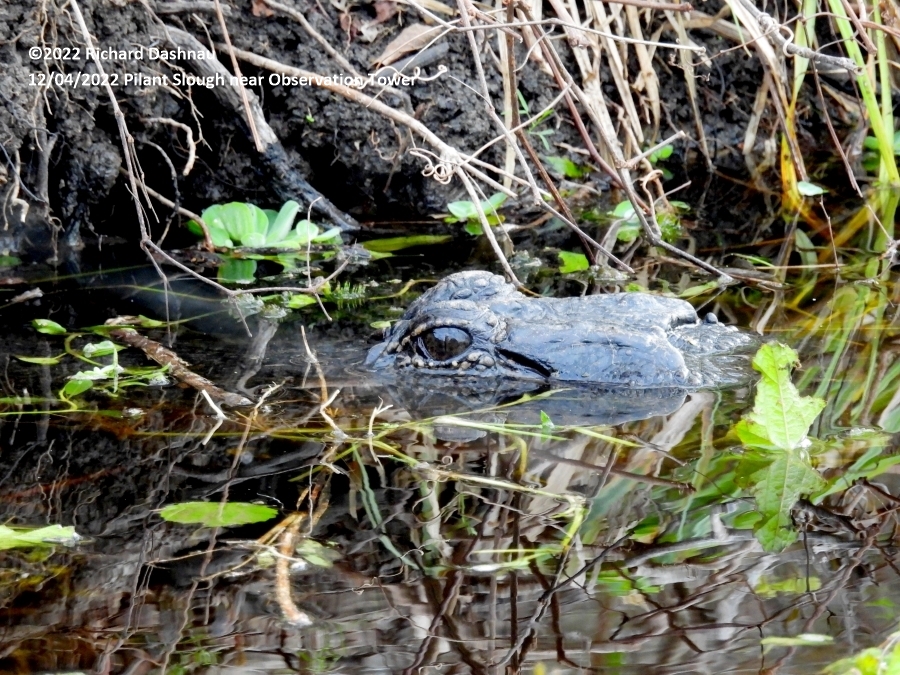
A larger
alligator (probably the "2nd gator" that had been sharing the
area all along) moved in behind the mother! At one point, it
even bumped the mother alligator and one of them made a
very low, quiet, short "growl". The mother didn't move,
and the other alligator backed off and moved away. It
eventually climbed onto the floating plant mat. One picture
shows how close the
2nd gator was, and also shows the size difference between
them. Babies started to appear after a couple hours. They
seemed to be coming out of a cavity under the bank, near mom
gator's
nose in the last picture.
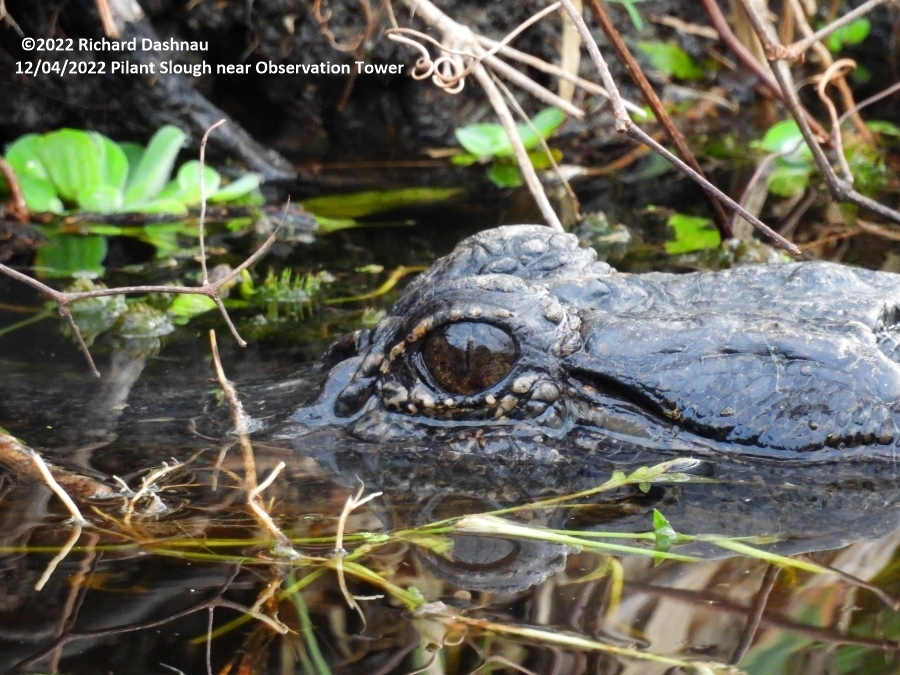
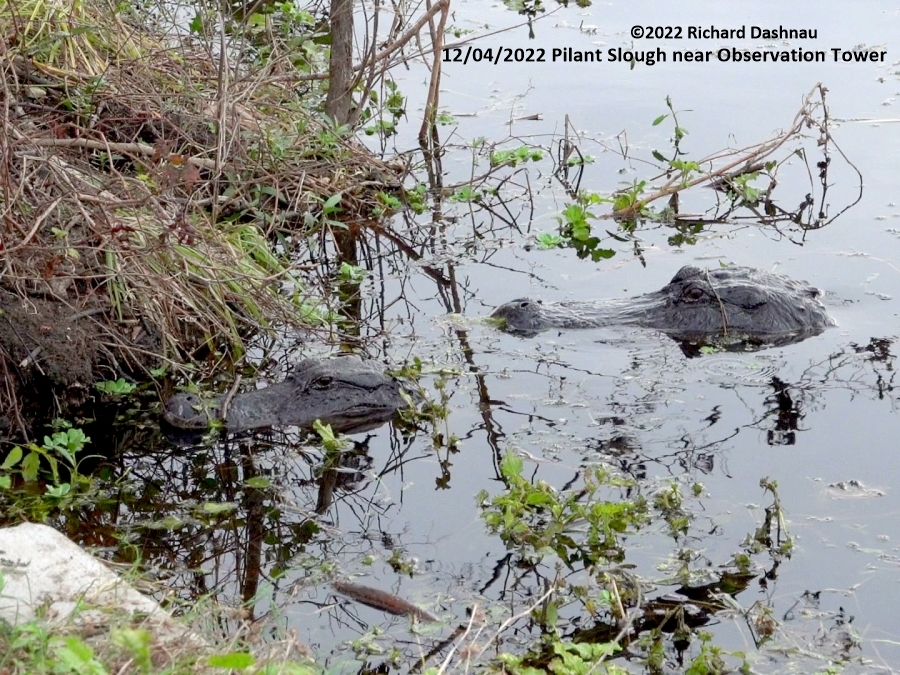
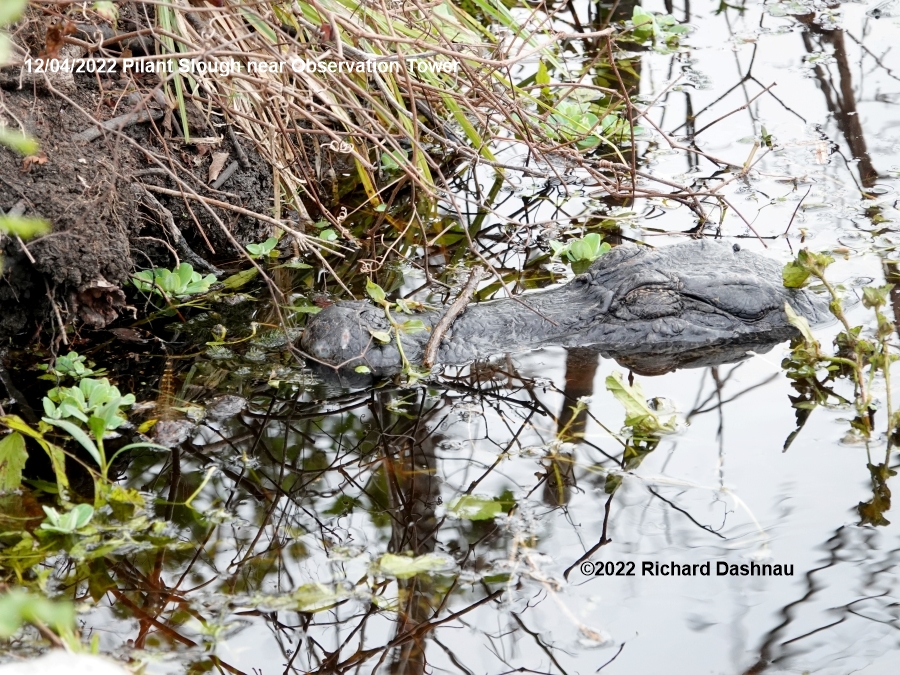
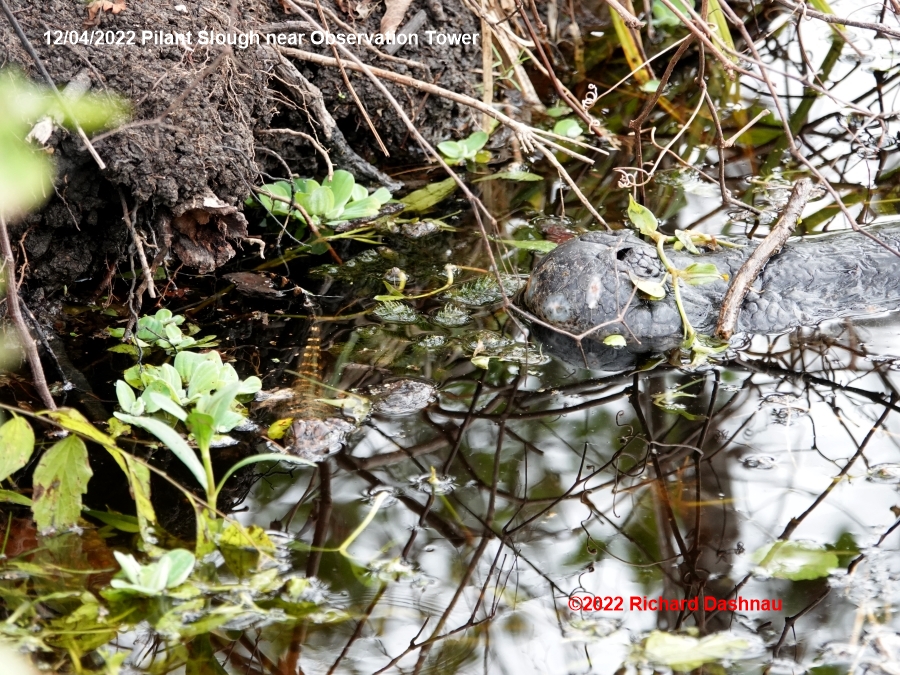
The mother
also moved over to the plant mat (she's at the center in the
2nd image below). More babies moved out of that hidden cavity
and climbed onto the bank. They were a few feet below
the trail, well camouflaged, and near the water. Their mother
was within sight of the pod. It was a situation that I've seen
many times over the years. During all of those times, I've
enjoyed
watching the baby alligators, and enjoying the quiet times
with park visitors that came by--for hours on some days.
But today was going to be different.
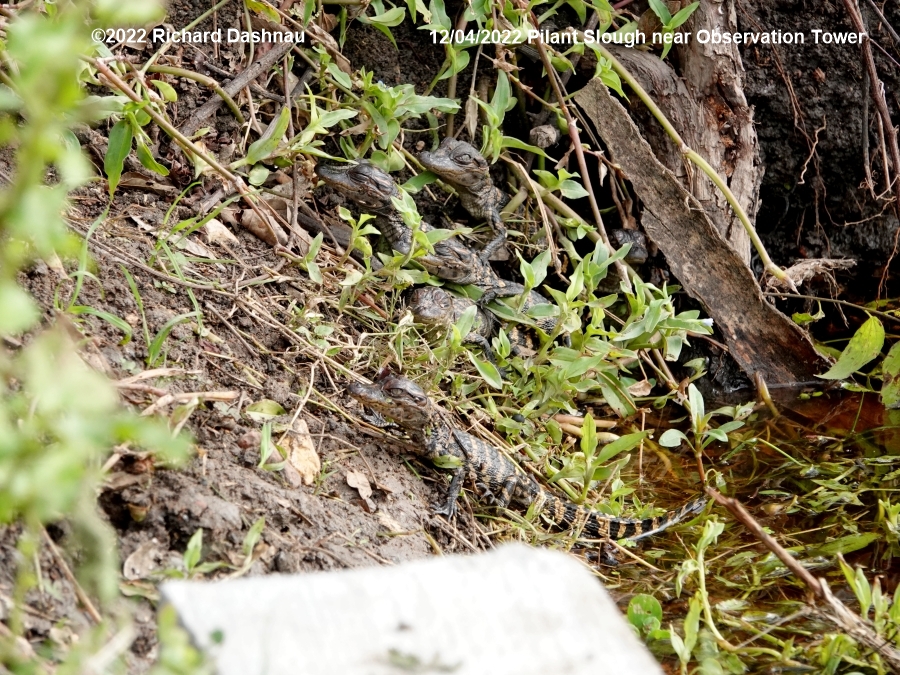
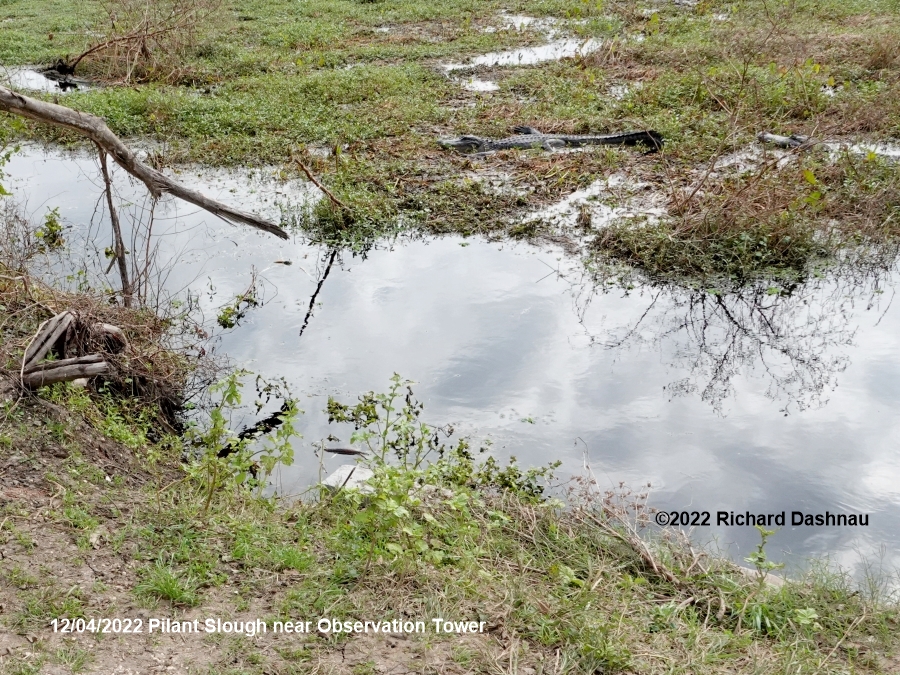
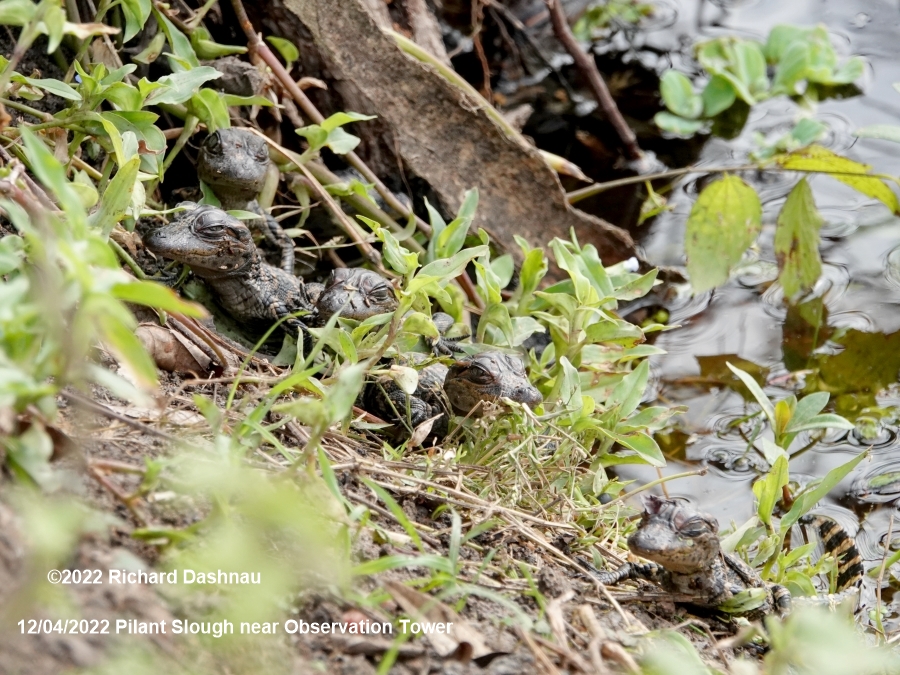
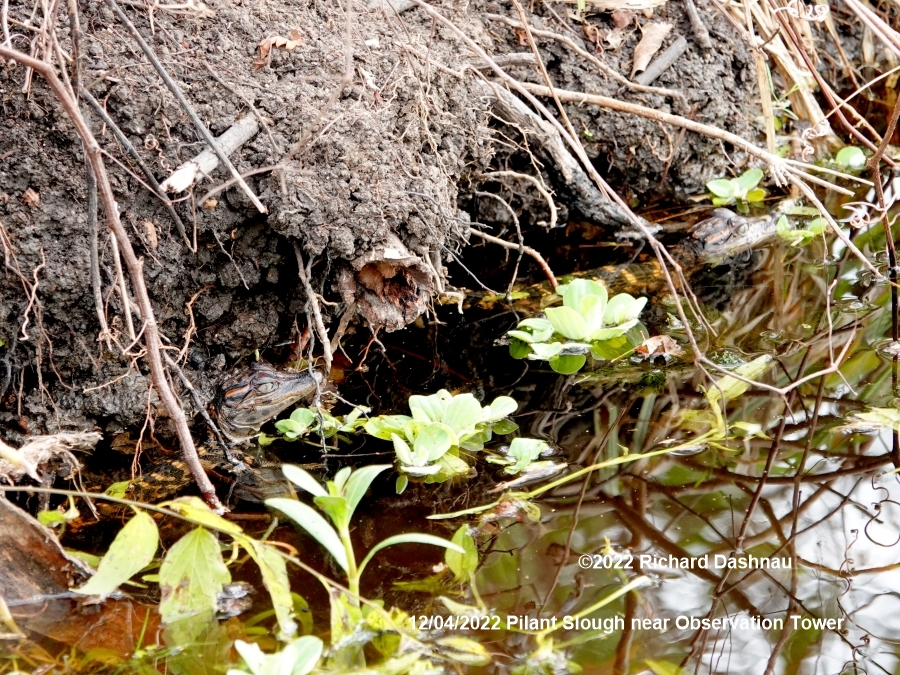
At about
12:30, I was doing the usual "crowd control"-keeping people
back from the bank so they wouldn't scare the babies; talking
about the adult gators, etc. There was a small group of
visitors around me. As we talked, and pointed, a Great Blue
Heron walked along the bank, coming from the short wooden
bridge. It came closer to us, then walked at the edge of the
trail
--only 6
feet away from us!!--then moved to the edge of the
concrete culvert. I asked everyone to be still, and
watch what would happen next. The heron paced to the left edge
of the culvert,
looked down the bank, stalked down the bank, and grabbed a
baby alligator! Right
in
front of us!
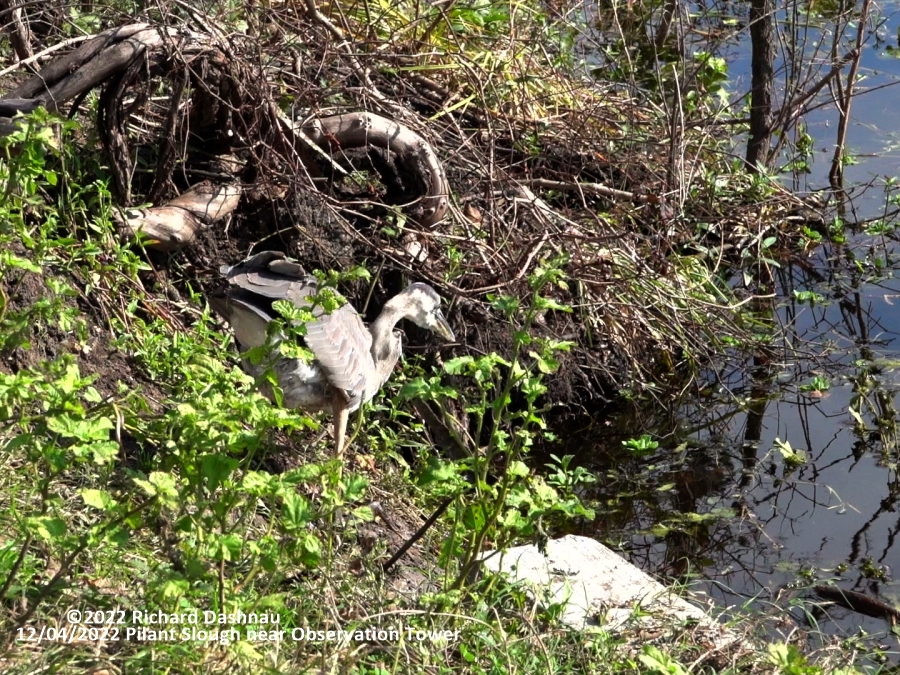
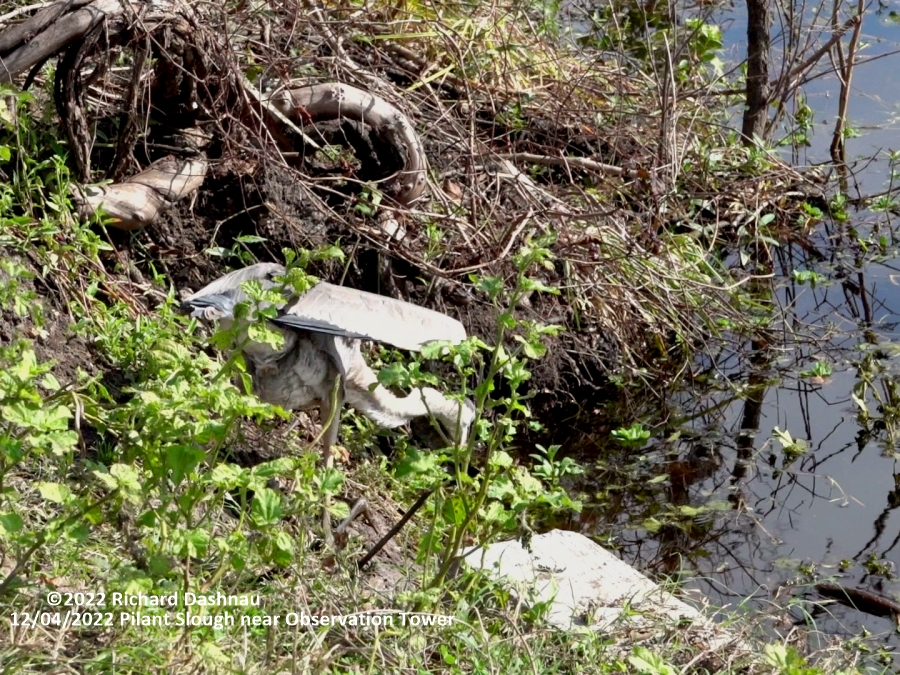
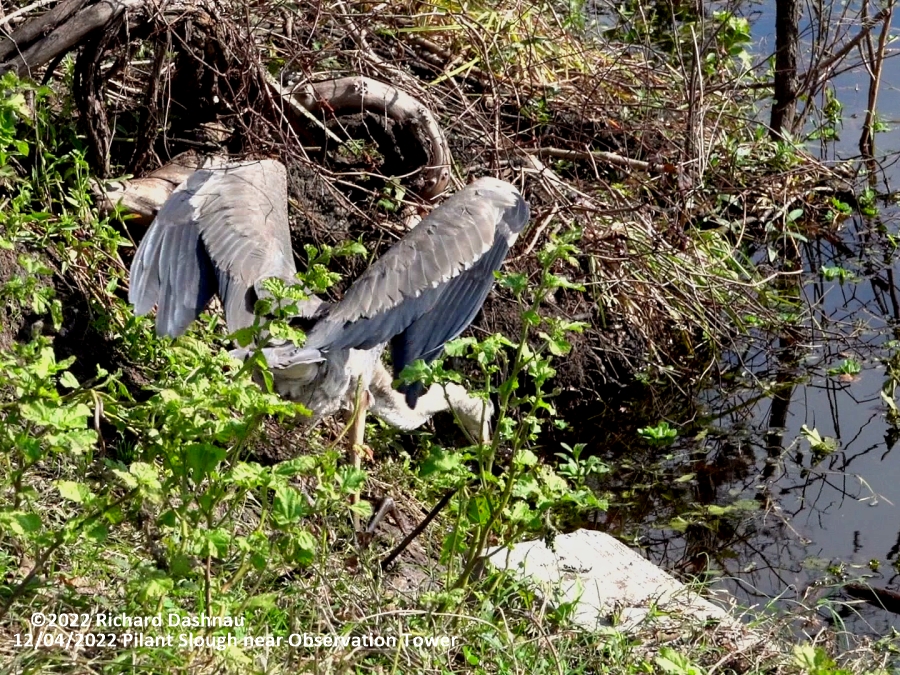
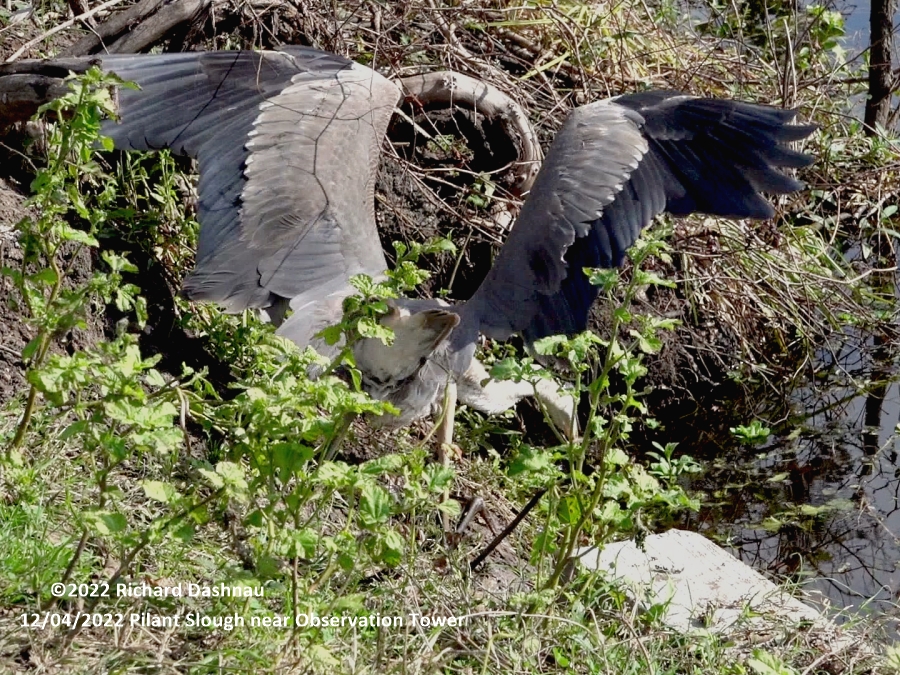
The images of
the heron here are frames from video. Standing just 6
feet from the heron, I had a brief, amazed look of those
huge wings opened in front of me. Reviewing the images later,
I
can admire the balance and physical prowess being
demonstrated. The open wings provide balance and stability to
offset the weight of the heron's neck, the energy of its
strike and
recovery; all as it was leaning forward and down while
standing on a steep bank. Imagine standing in the same spot,
and reaching down to grab something with your hand without
falling into
the water, and you may have some idea of why I could admire
what was happened here. The heron
turned, walked up the bank, took a step or two and took off
with the baby.
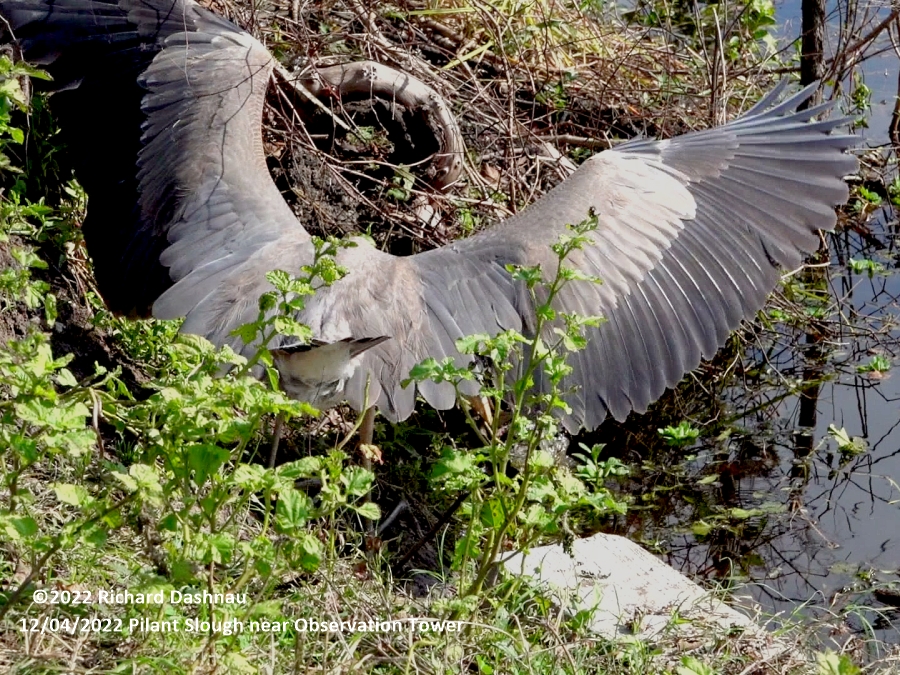
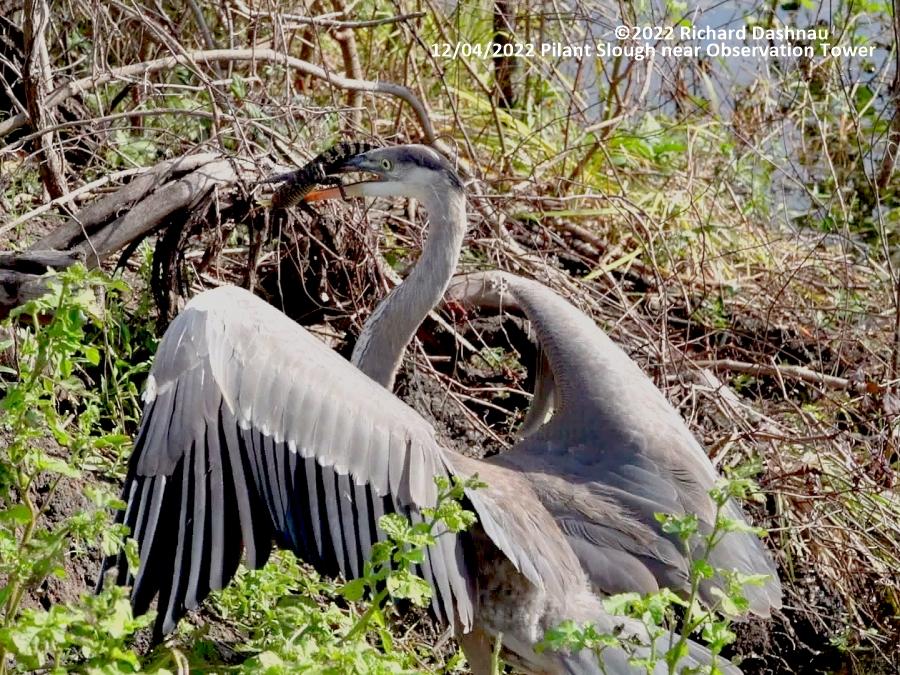
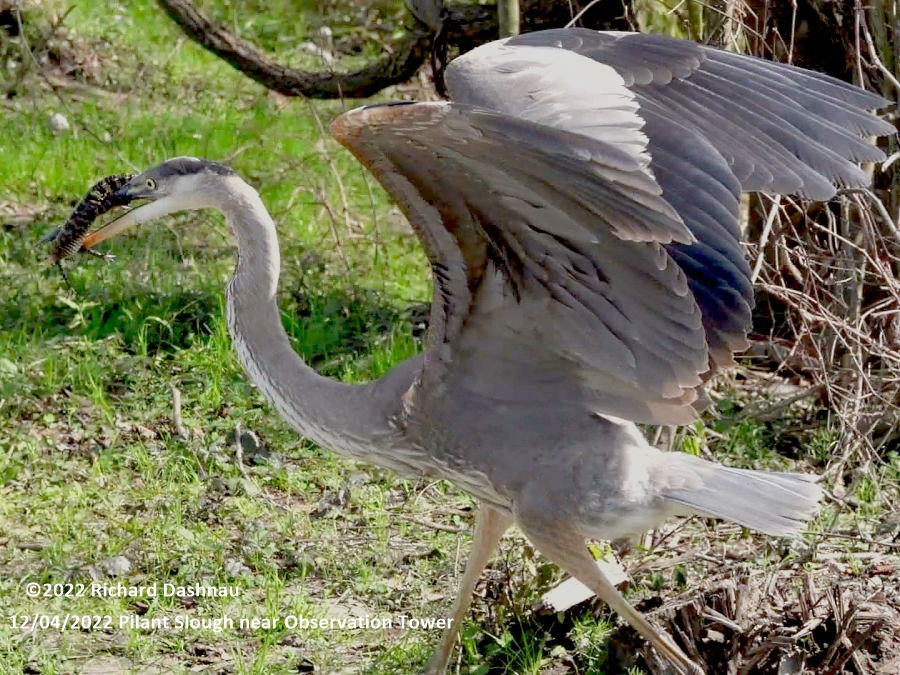
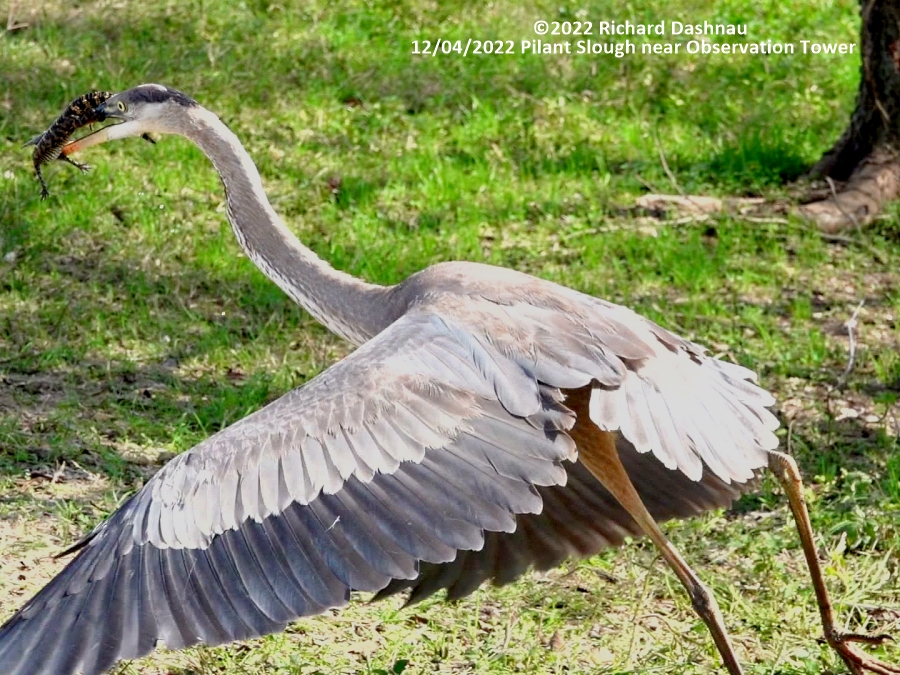
It landed about 50 yards West, on the plant mats in Pilant
Slough, and we could see it finish eating the hatchling.The
mother responded by rushing into the water and over to the
bank, but she
hadn't begun moving until after the heron had
gotten back onto the trail, far too late to save the heron's
prey. The babies had all submerged.
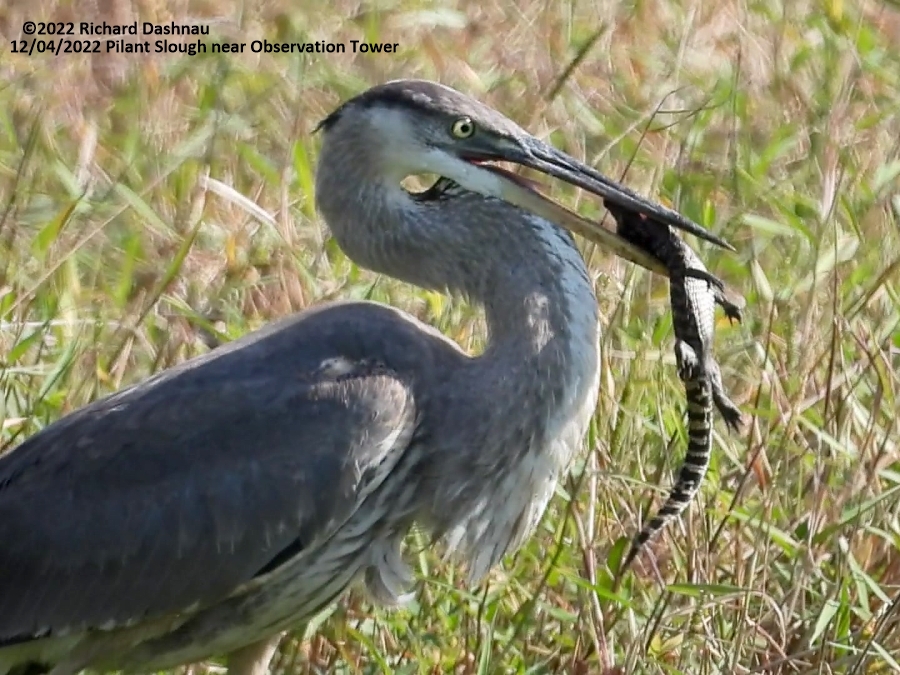
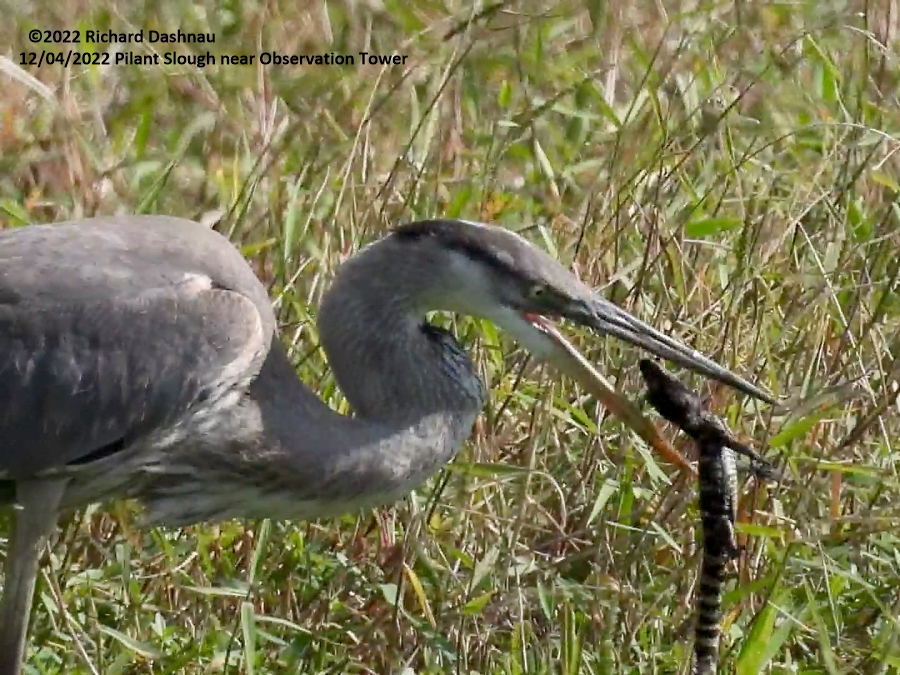
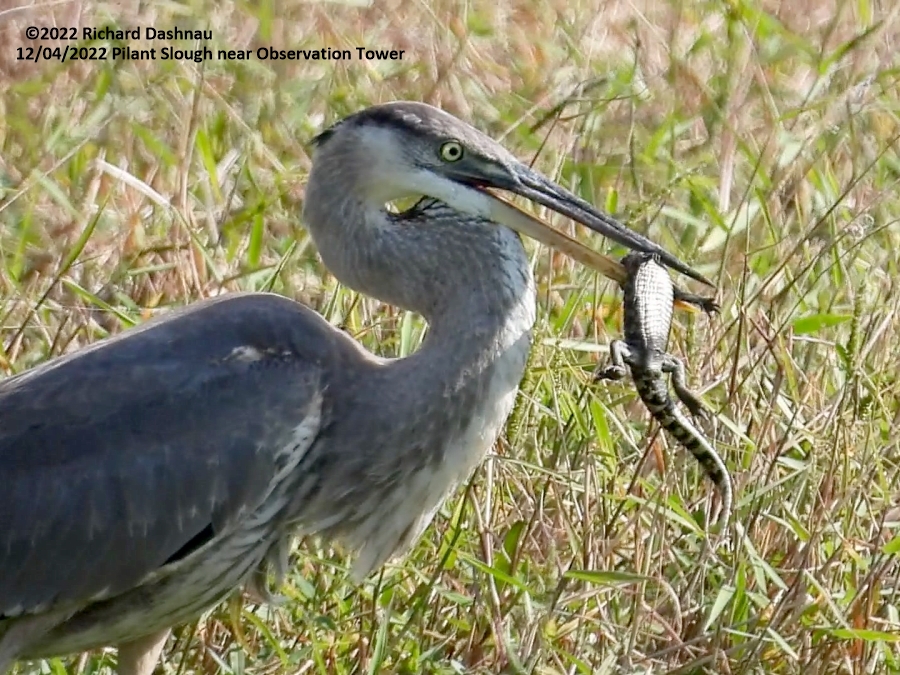
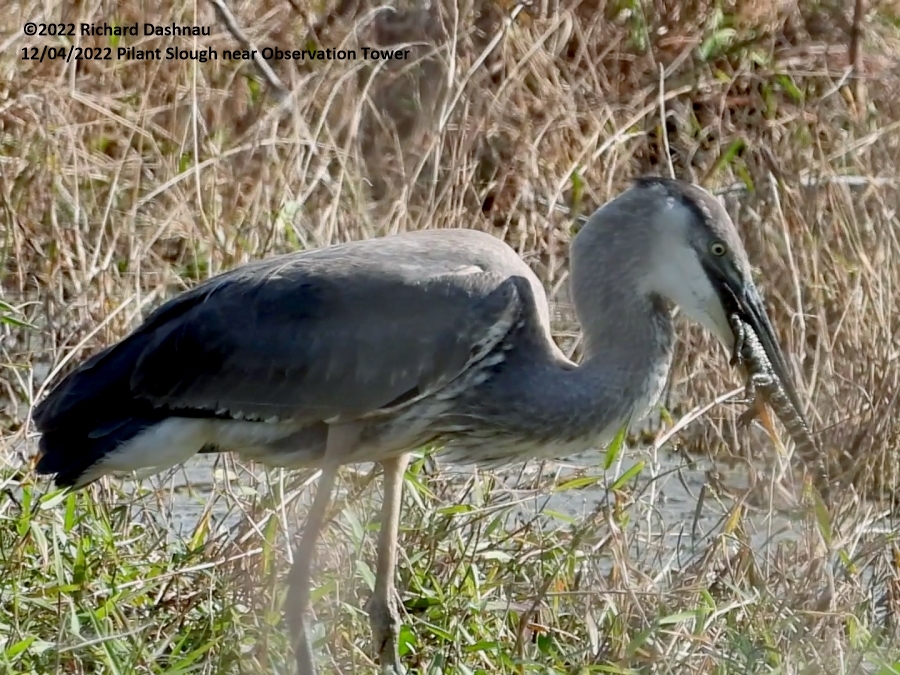
The mother
climbed onto the trail near the culvert, and rested
there. She was still there when I left. Although I
knew the heron was stalking the babies, I was still very
surprised that it ignored
me and the crowd and grabbed one. As mentioned
above,
I've put together an 11-minute long video that summarizes this,
with the added attraction of video clips showing some of the
action.
That
11-minute
video is here.
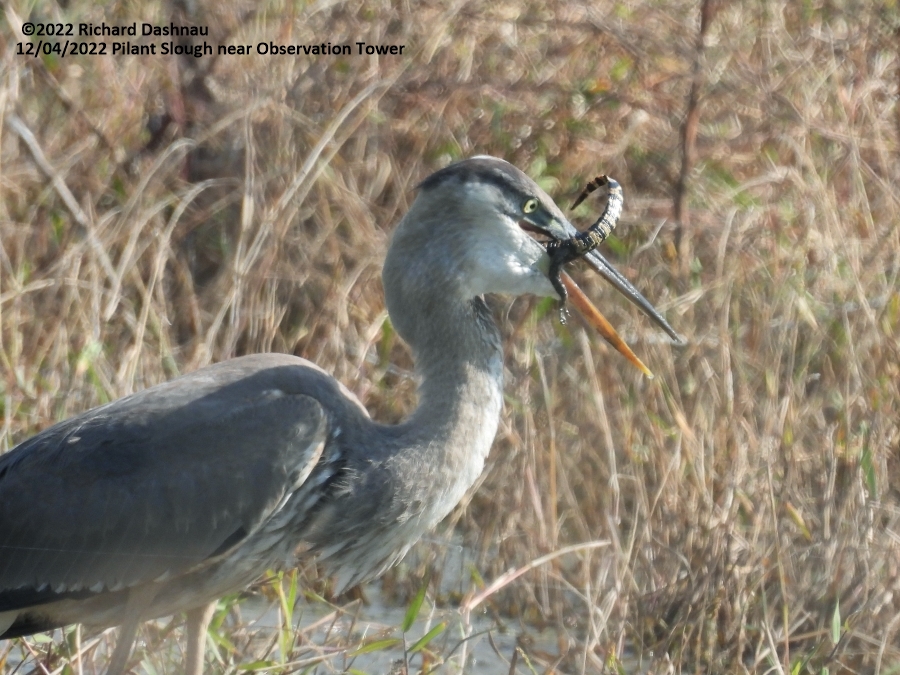
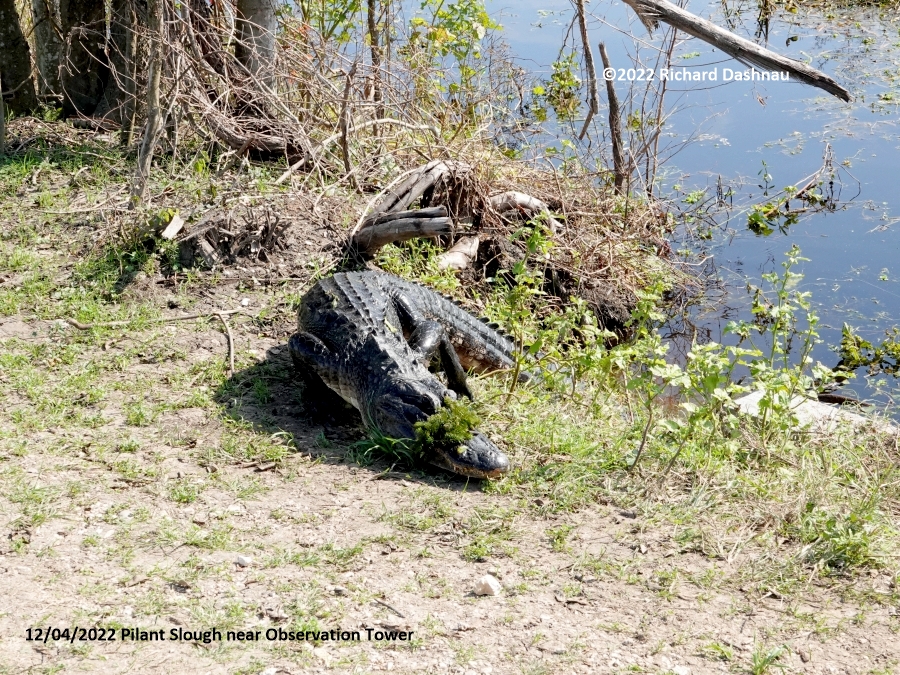
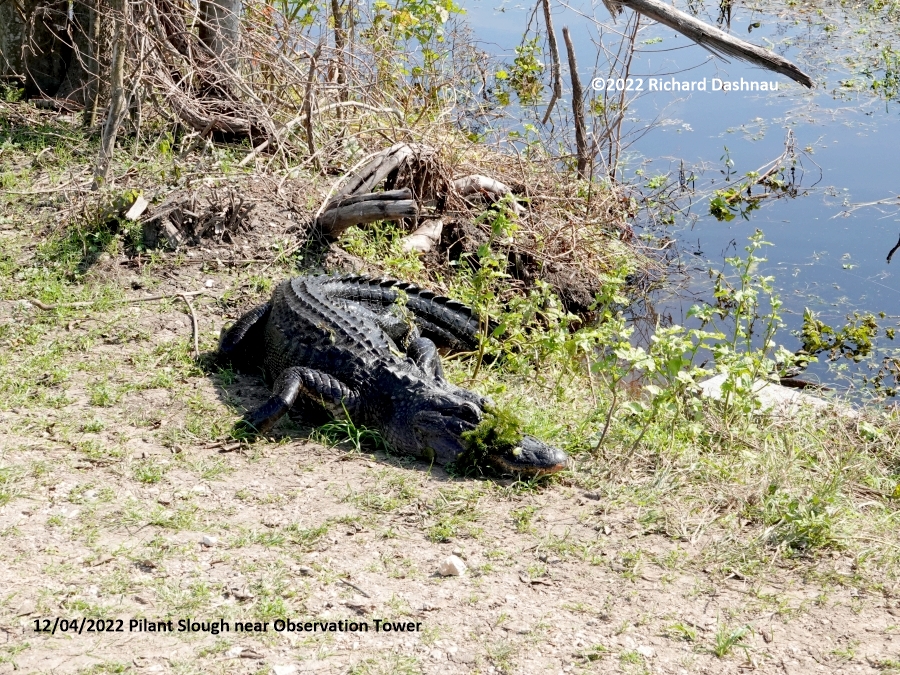
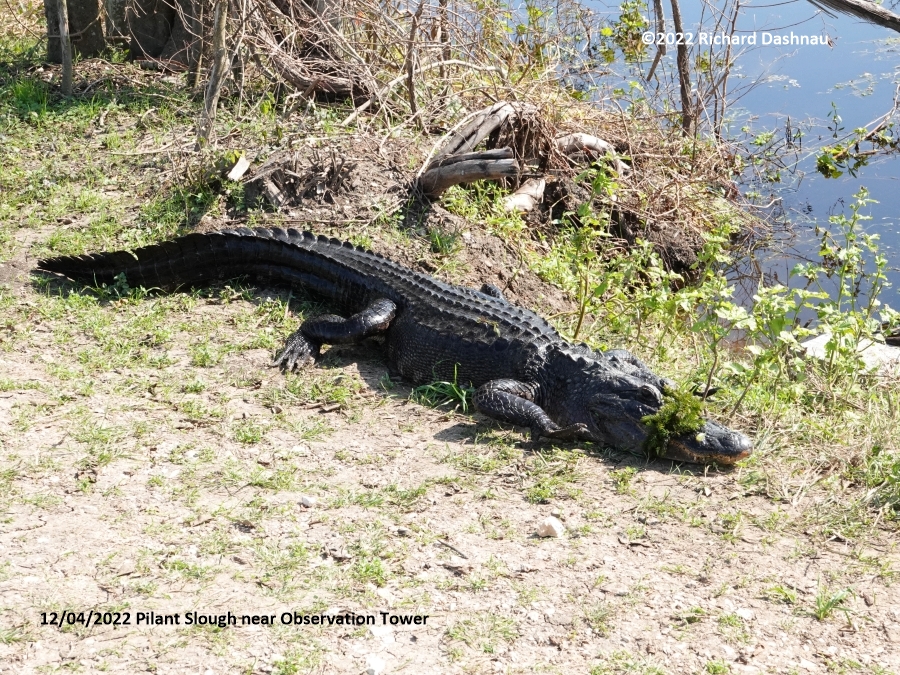
From
Brazos Bend State Park on 11/06/2022
About 5
minutes after the snake crossed, there more drama! Great
Blue Heron that had been stalking the area (baby gators
were around)
stabbed into the weeds and came up with squirming prey colored
with stripes. At first I thought it had caught a baby
gator...but then recognized it had caught a snake. With the
apparent
black with white speckled colors, I thought at first--Speckled
King Snake. That didn't make sense (I don't think this is its
favored hunting zone). I watched the events happen, and tried
capturing
enough images to identify the snake.
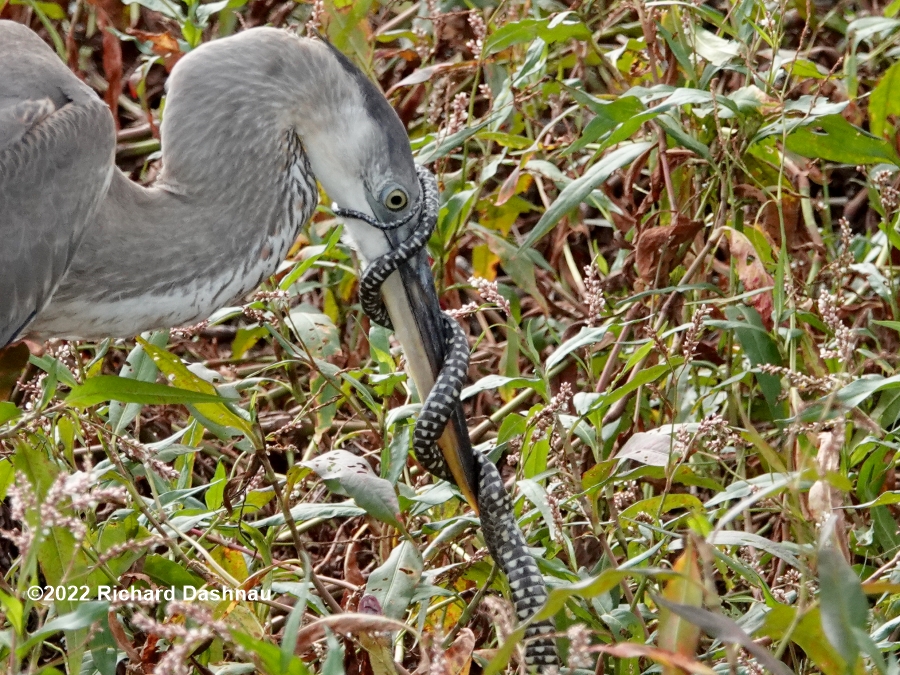
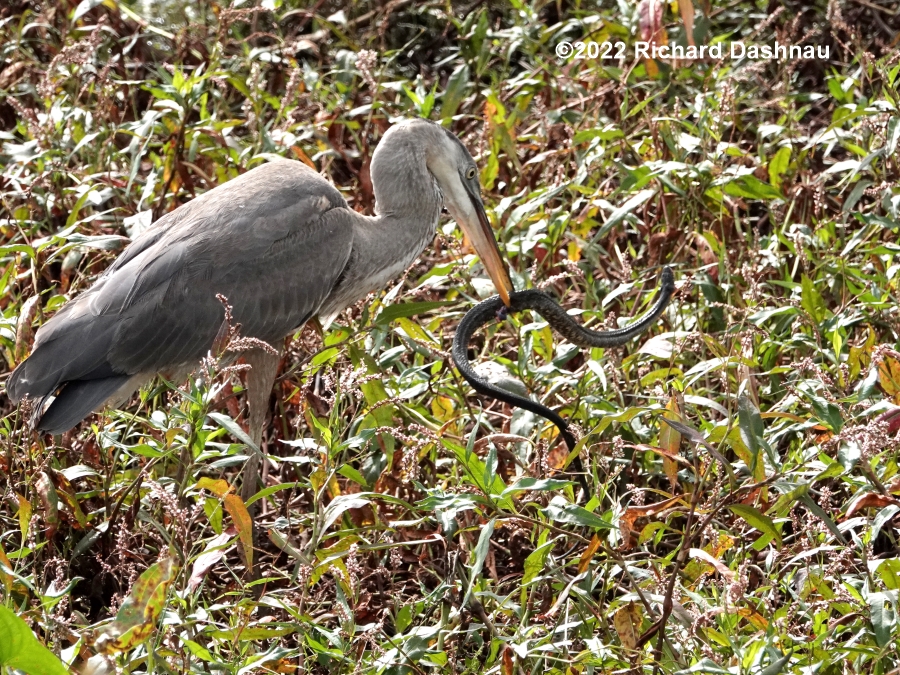
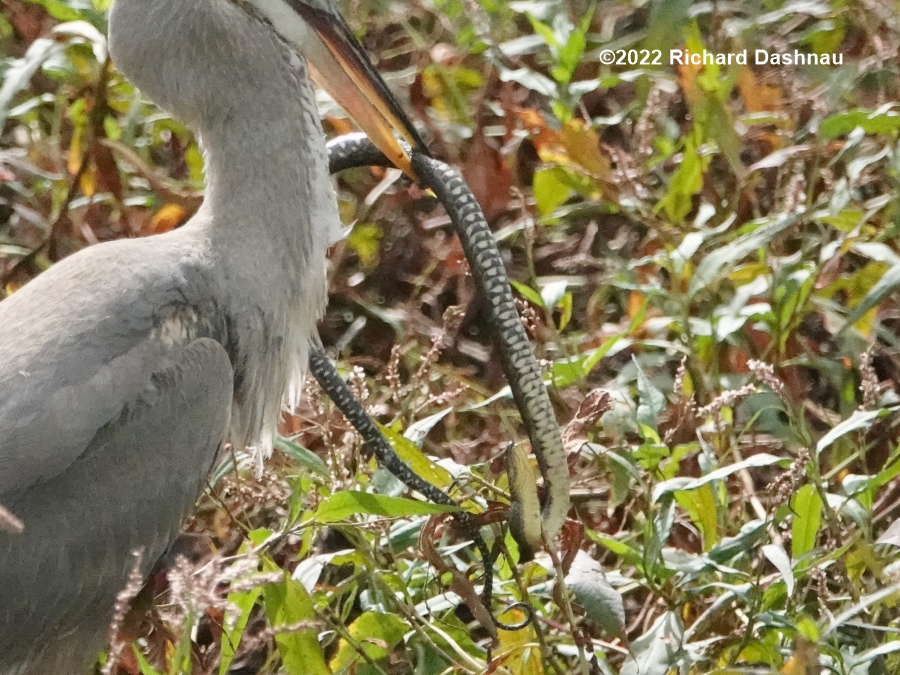
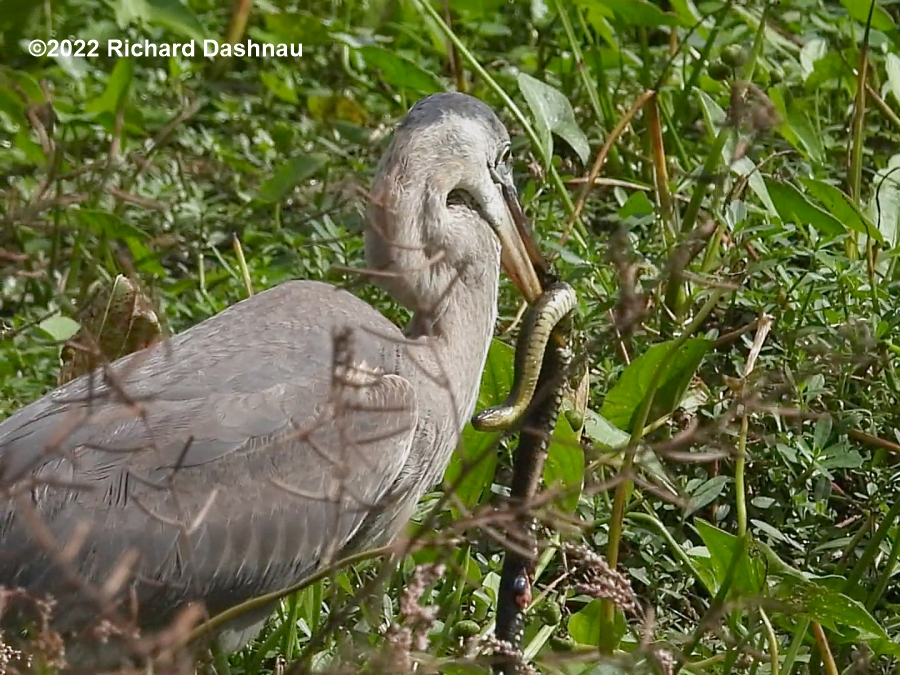
Some of the images are grabs from video, too. Let's try
to identify the snake. The head is not shaped like a
pit-viper's (not blunt profile, no gland swelling at the rear
of the jaws). The top
(dorsal) color is a sort of dark green. Not any bands across
the body(head shape & round pupil & no mask(stripe on
side of head) rule out Cottonmouth. No stripes along the
dorsal and sides.
So not a Ribbon Snake or Garter Snake. Could be a water snake.
No orange colors on top or bottom--so not Broadbanded Water
Snake. But look at that pattern on the belly, especially
visible starting near the tail and stopping about 4
inches behind the head. It's not a double line--so not a
Crayfish Snake. How about this: "numerous yellowish
half-moons, they cover most of
the belly, which is typically yellowish-white on the forward
third and grayish or brownish on the midbody and the rear".
--from Texas Snakes-A Field Guide by Dixon and Werler ©2000
page198.
This sounds about right to me. If it is, then this was a
Mississippi Green Water Snake (Nerodia Cyclopion) The
Heron dealt with the snake as they normally deal with large
prey. There were
multiple stabbing, picking up to sense movement, drop and stab
again cycles,; until it was time to swallow the snake. This
was a bit of a problem, because the snake had tied the rear of
its
body into a very large knot. This discourage the Heron, but
only for a little while. It did finish its meal.
Interesting times in a very small part of the park.
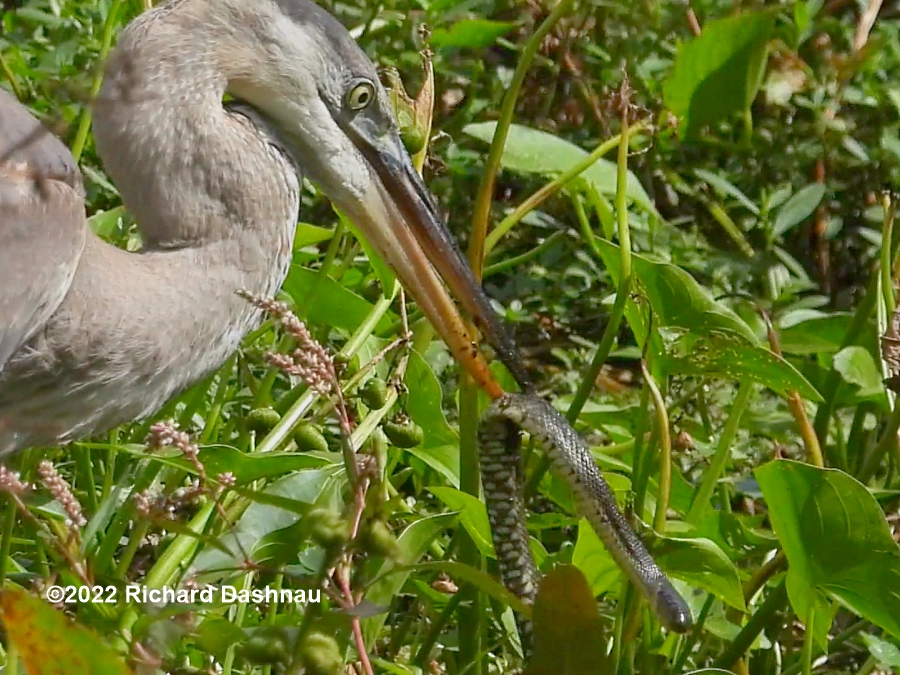
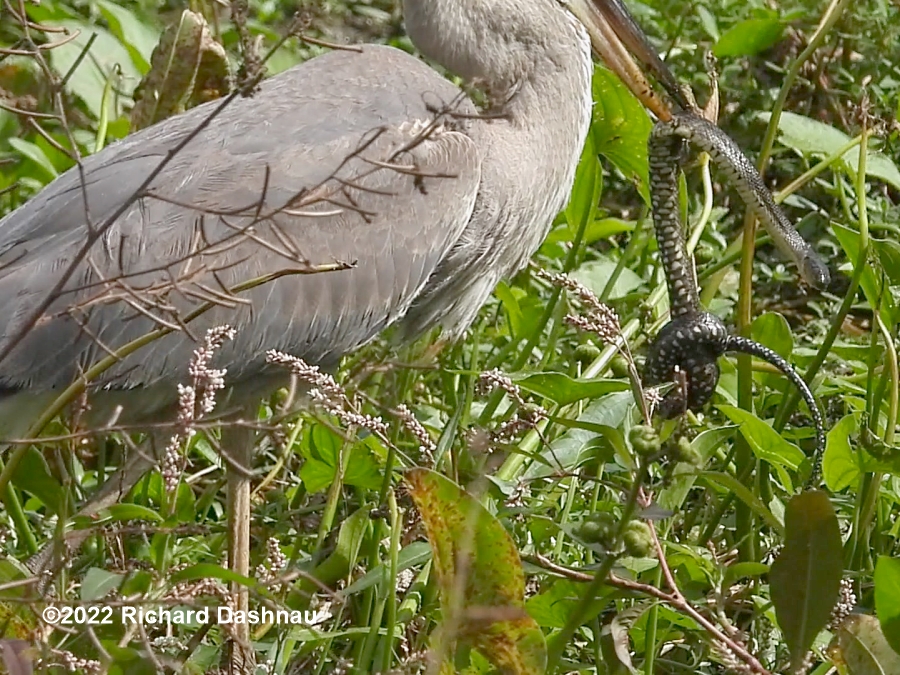
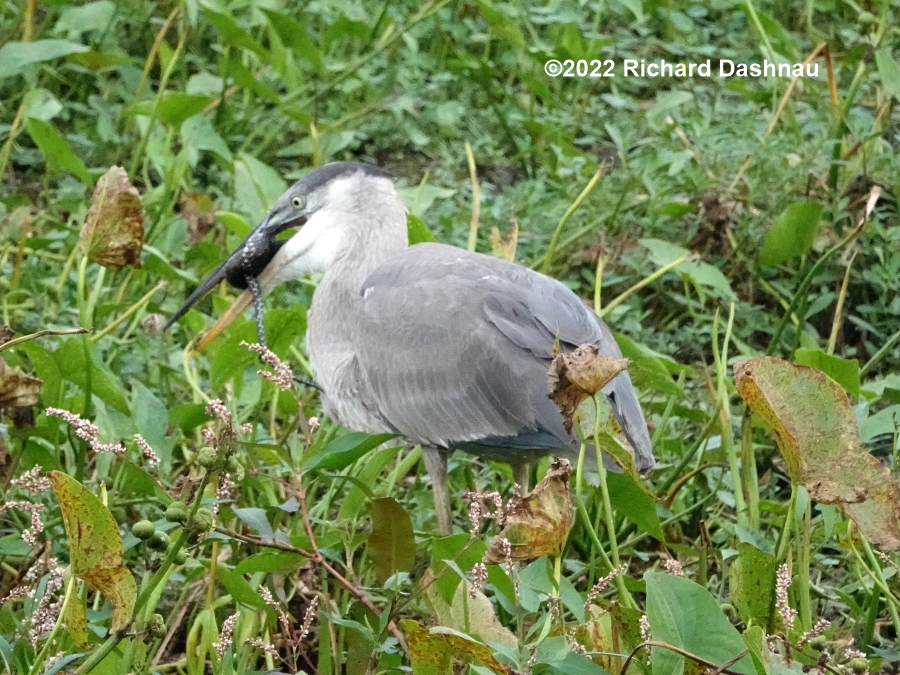
From
BBSP on 10/16/2022 (update
added 11/14/23)
Walking along Pilant Slough Trail, I noticed the quick movement
of this heron catching
something. It was a dragonfly.
I've seen Great Blue Herons catch many types of prey, including
dragonflies--which they usually grab when
the insect has landed. But while I was watching through the
camera, the heron looked up,
and grabbed another dragonfly out of the air!!
Amazing catch! I'd intended to share the experience before, but
it was put out of mind by later experience. But, here it is! The
images below
are frames from this very short video.
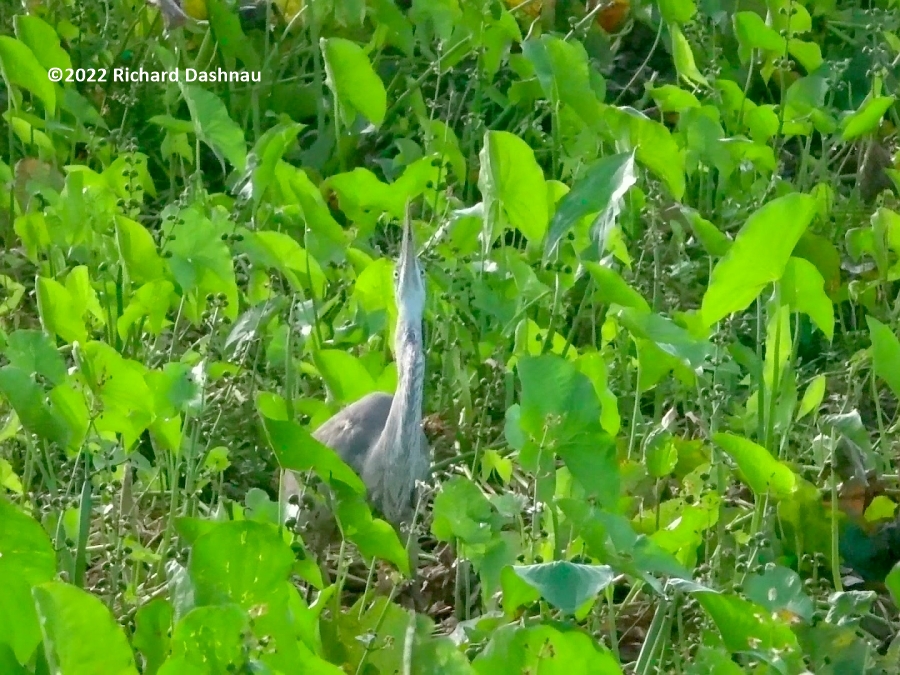
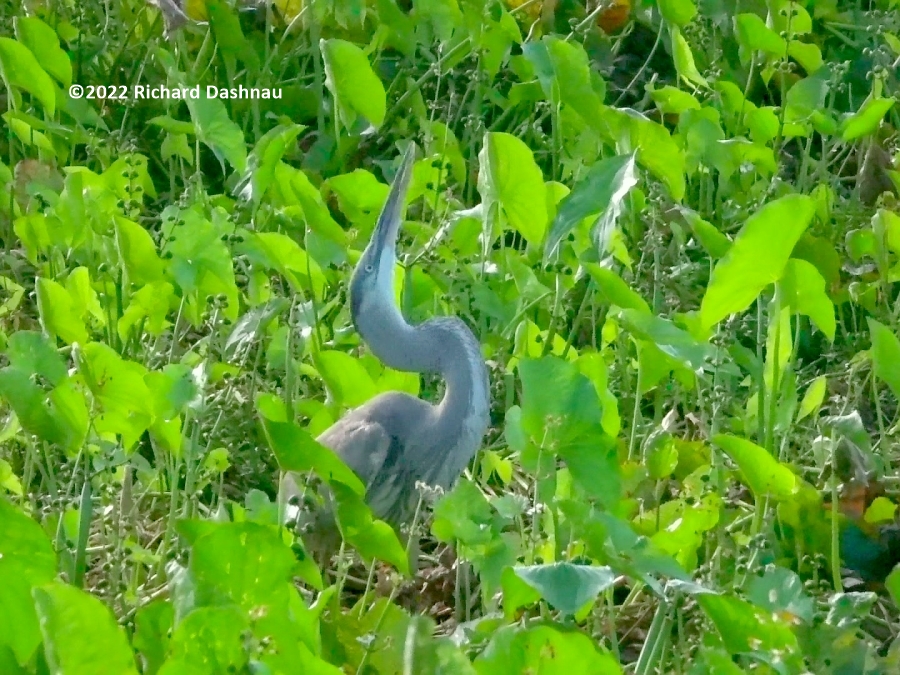
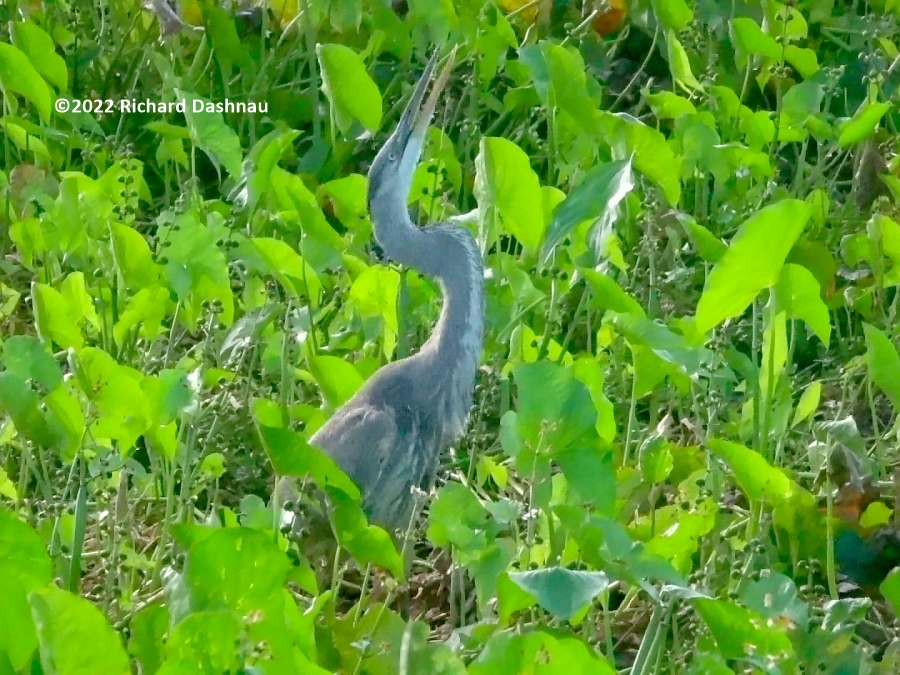
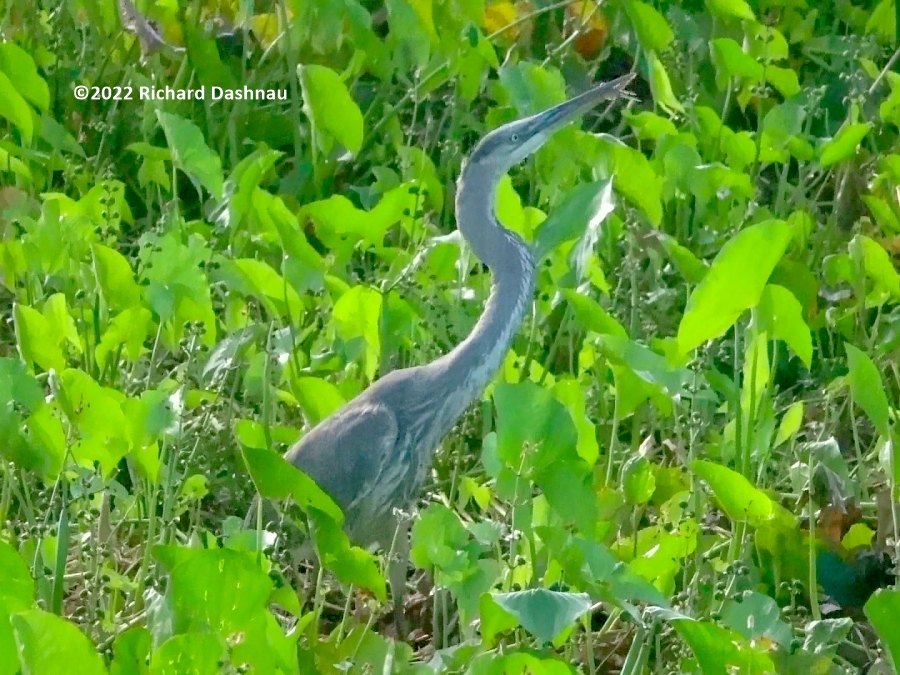
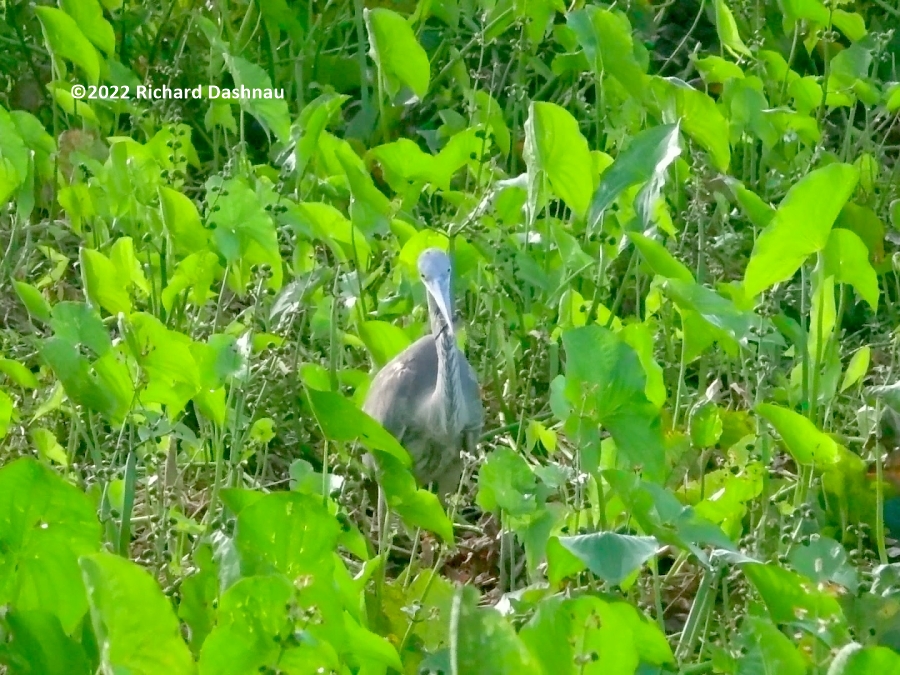
From
BBSP on 06/05/2022
Due to trail construction, lack of rain, and the heat, the water
level in Pilant Lake has dropped dramatically over the last
month or so.
The first picture, taken near the Observation Tower, shows how
far the water has lowered, and the small channel made by
drainage. Through the day (and I stayed on the trails
between
40Acre Lake and Elm Lake) I saw a LOT of green herons. They
might have also been taking advantage of the prey being exposed
by the low water. This
Great Blue Heron had caught a
Broadbanded Water Snake. That was another uncommon sight
for me. I usually see them catching Sirens, or various fish.
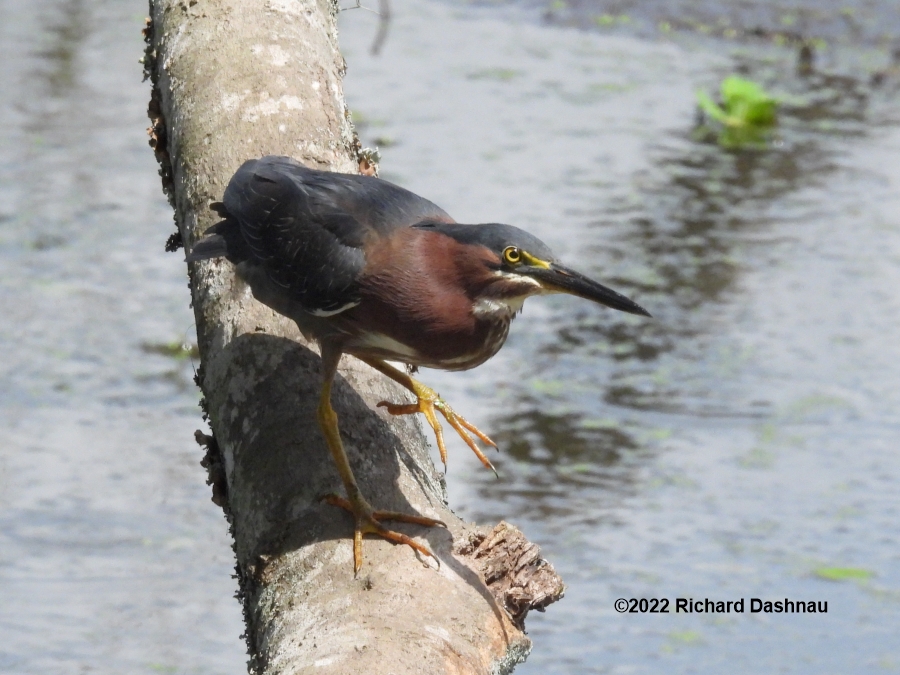
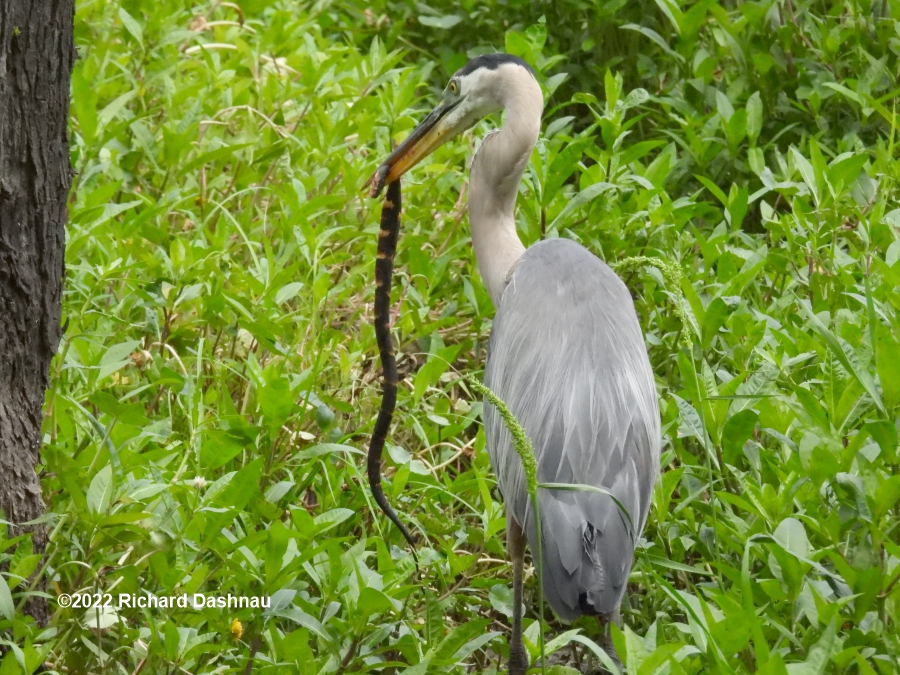
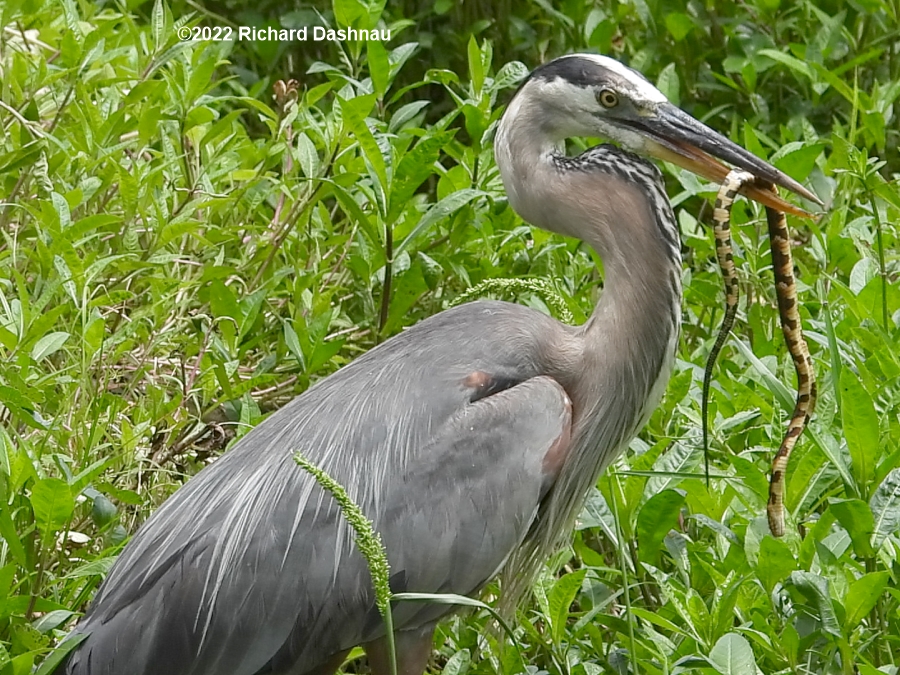
From BBSP
on 02/06/2022.
We've got Bobcats in the park, and Coyotes, and Otters, and
Alligators! So what could some toothless critter do? HOLY
COW!
When the
day started, it was about 42 deg F at 40-Acre lake at
8:10am. Throughout the day, I had the usual array of
encounters with wonderful creatures. About 4pm I was
moving
West
on the 40 Acre Lake trail when this Great Blue Heron
caught a Lesser Siren just North of the trail. That's always
an amazing sight and the visitors on the trail were
impressed.
But then
the Heron flew across the trail and landed on an island in
40 Acre Lake. The islands are about 30 yards away from the
trail, so we could easily watch the end of the hunt.
I've been
lucky enough to see this activity many times. For
example, just the last few times I've been able to
photograph Herons capturing Sirens on 9/05/2021, 11/07/2021,
12/12/2021, 01/06/2022, and this day. These images are
all frame grabs from this
edited
video. Imagine the strength in the Heron's body
and neck that allowed it to carry that
struggling
siren--while the Heron was flying!
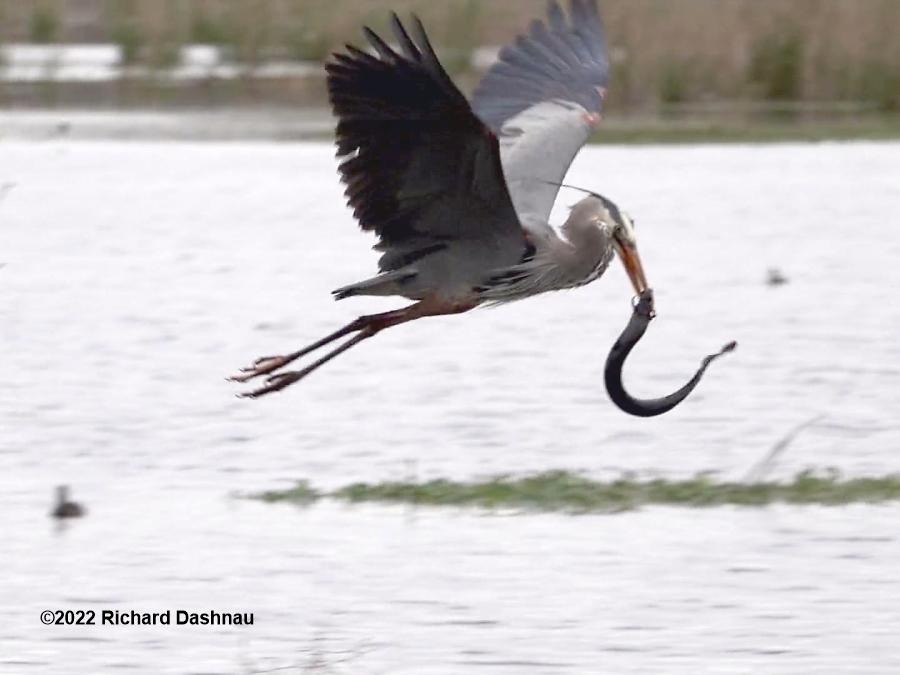
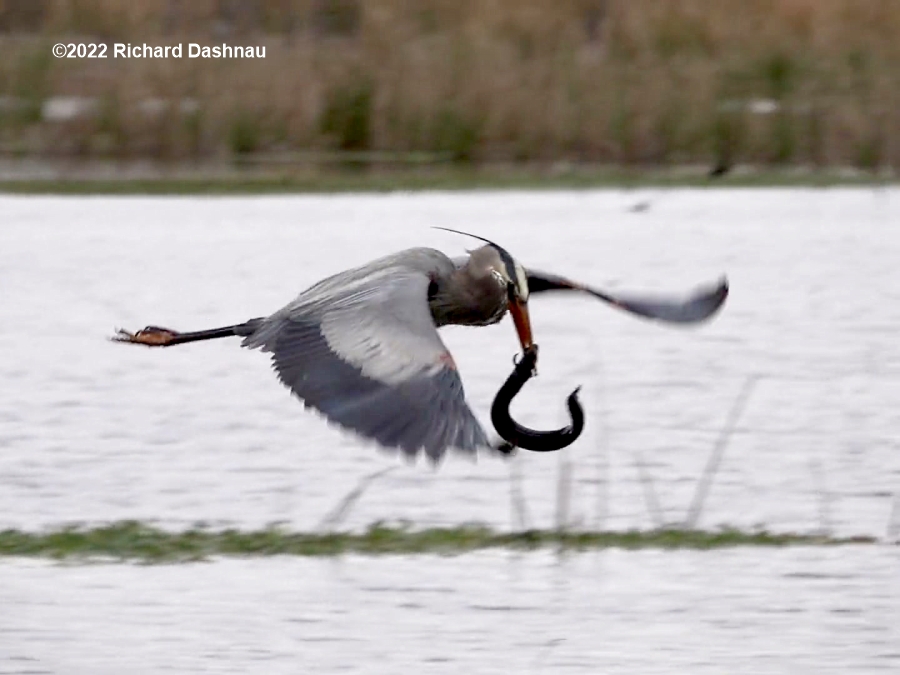
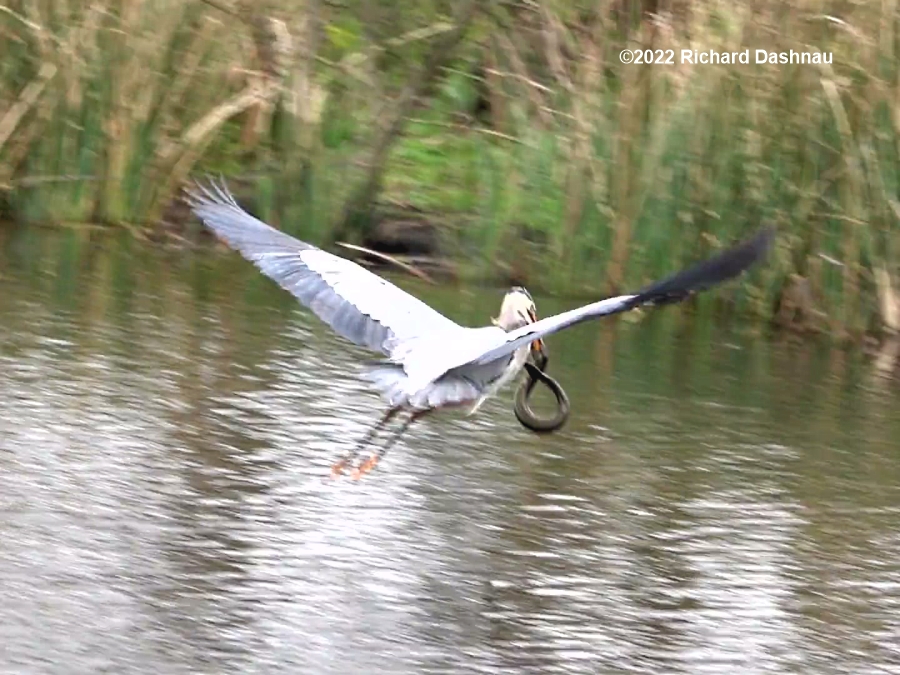
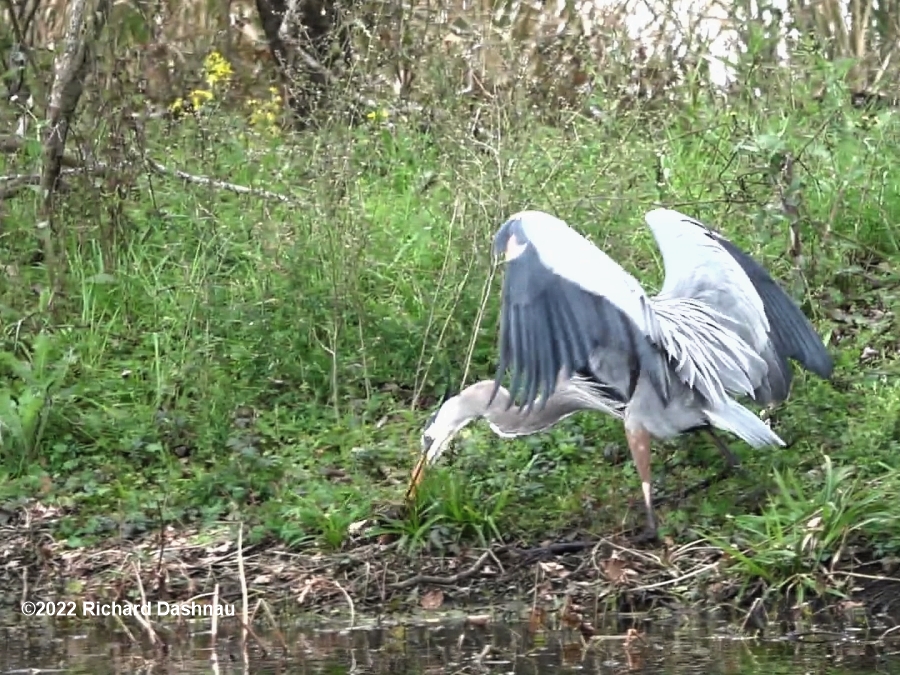
I've
seen
that Great Blue Herons usually use the same technique when
dealing with larger prey items. They capture the prey by
impaling it with their beak. If the Heron was wading, they
move
onto
land. If the prey is still struggling, it is dropped and then
impaled again. The prey is lifted, and the Heron pauses. I
believe it is checking for movement.
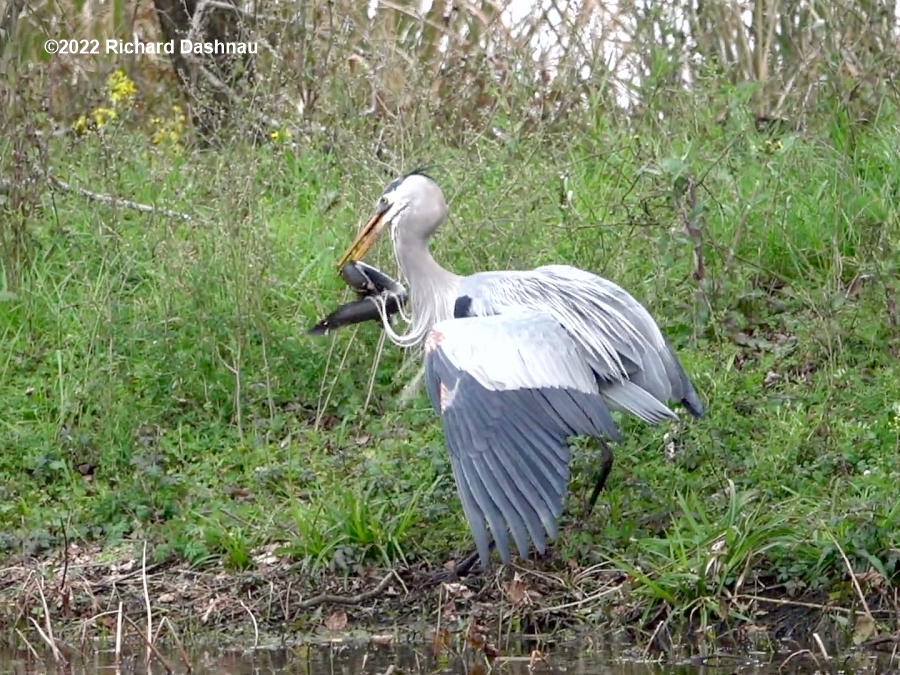
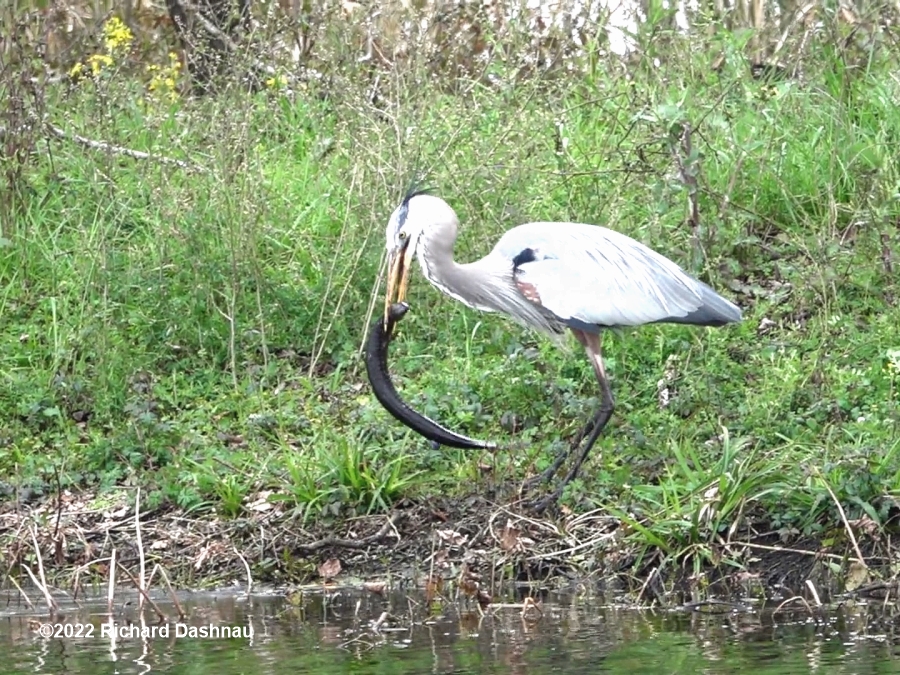
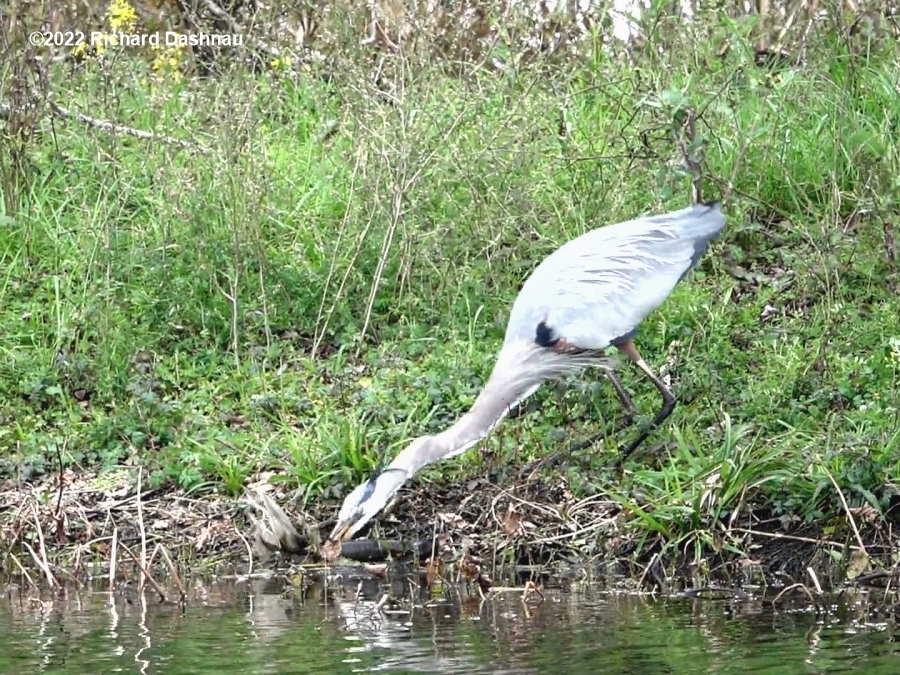
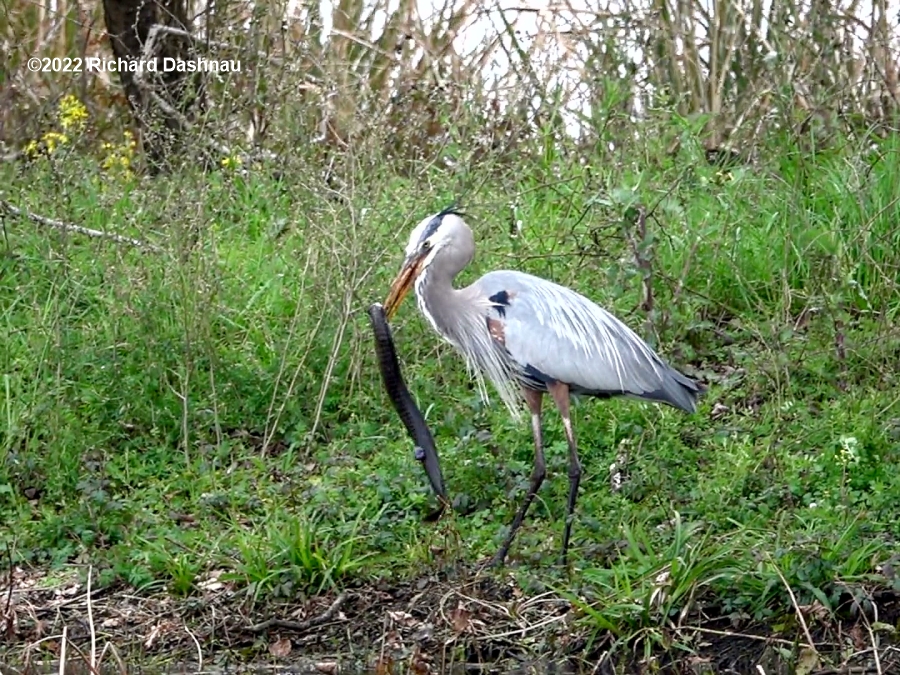
If the prey
is still struggling, the process repeats as the prey gets
weaker. When the prey has stopped moving, it is then
swallowed--WHOLE. The entire process usually happens pretty
quickly
so it is
easy to miss just how formidable the Heron's beak is. The
Heron's aim was usually true-striking the head and upper body
of the Siren. Also, the beak easily penetrated skull, body,
and
even went
through the Siren and into the dirt. Amazing power! This
Heron had a little problem handling the Siren, and it took
longer than usual to eat it. I would guess that this Heron is
younger,
and had less
hunting experience.
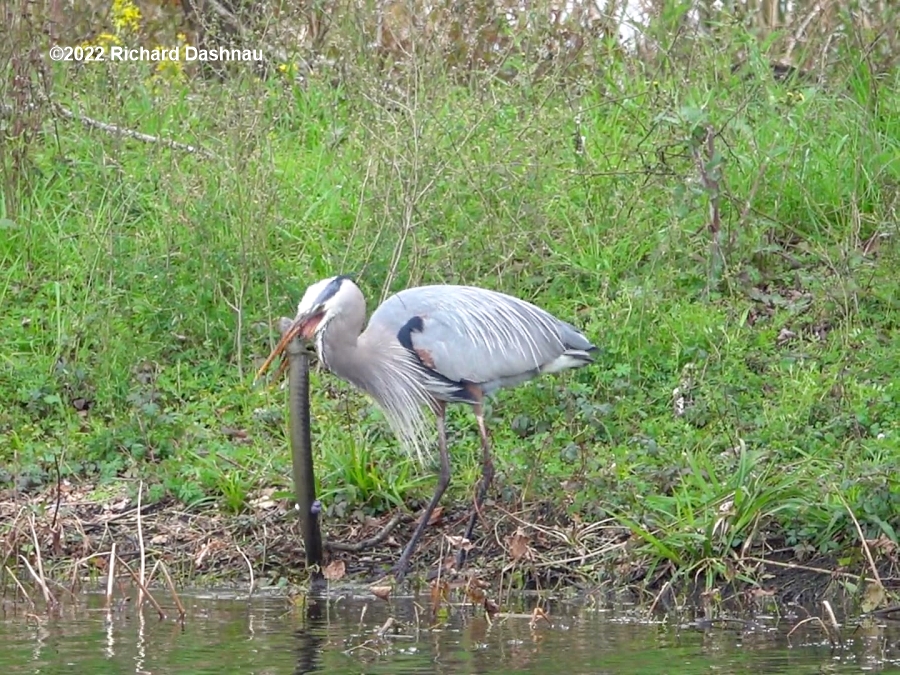
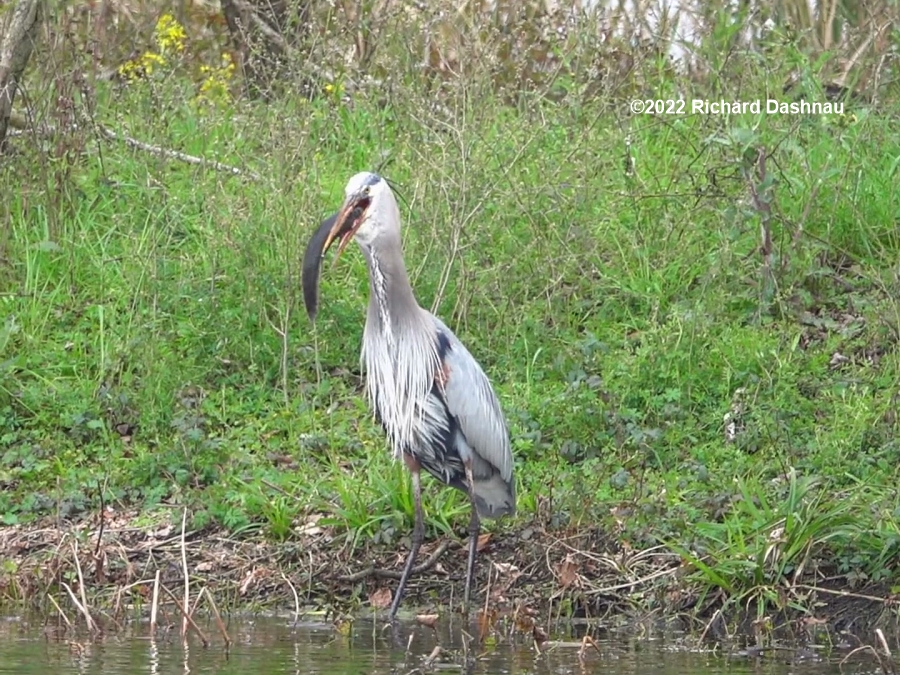
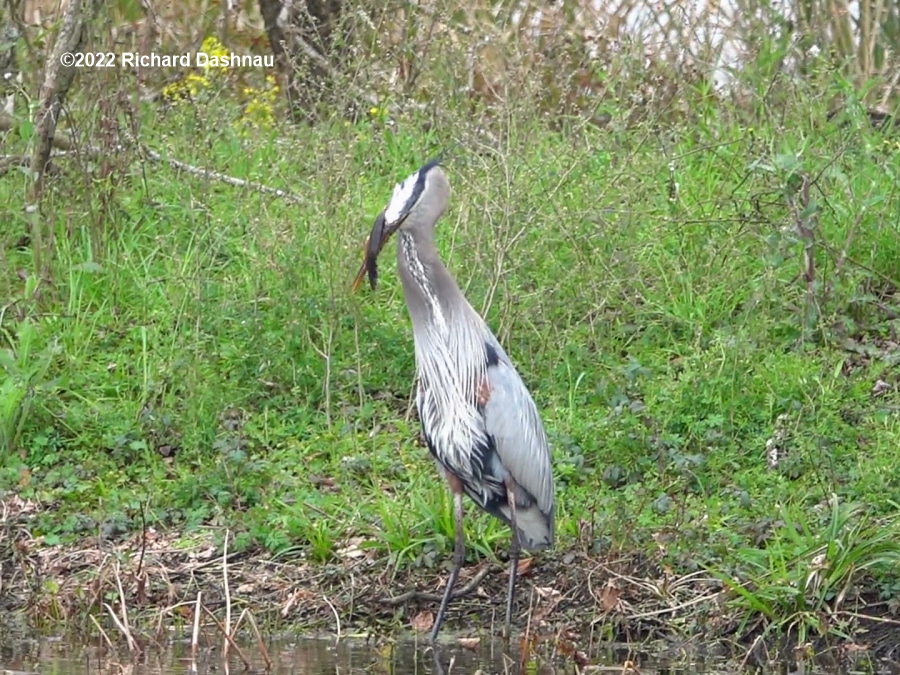
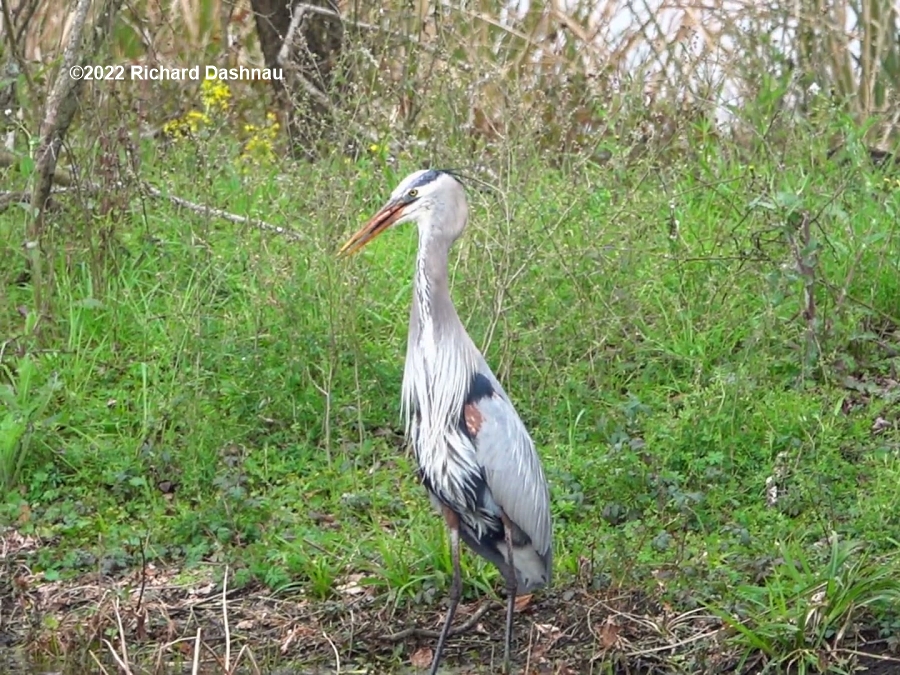
Go
back to my home page, Welcome to
rickubis.com
Go back to the RICKUBISCAM
page.
Go back to the See
the World page.








































































































